Bob Sonnenblick CaRE, USC Hyatt House Hotel EB-5 Project
CaRE, USC Hyatt House Hotel EB-5 Project
CaRE, USC Hyatt House Hotel EB-5 Project
PERE Conference Corp. has announced that Los Angeles-based real estate developer, Mr. Robert Sonnenblick, Chairman of Sonnenblick Development LLC, has been chosen to moderate a real estate panel at their upcoming PERE Real Estate Summit in NY on November 11th, 2015.
The panel is titled: “The Cycle continues, a correction is inevitable…”.
For more info, go to www.perenews.com
12:10 As the cycle continues a correction is inevitable: Balancing investments for a future downturn
How are we factoring the anticipation into our investment strategy now? Will there be appreciation in both long/short term assets?
Moderator:
Mr. Robert Sonnenblick, Chairman, Sonnenblick Development LLC
Panel Members:
Todd Henderson, Head of Real Estate, Americas Deutsche Asset & Wealth Management
Chris McEldowney, Managing Director, Real Estate, New York Life Real Estate
Jay Morgan, Senior Consultant, Courtland Partners
Press Release: New York City. New York
Real Estate Capital Magazine has announced that Los Angeles-based real estate developer Robert Sonnenblick, Chairman of Sonnenblick Development LLC, has joined the agenda for their upcoming Real Estate Capital Finance Forum to be held in NYC on Monday November 9th. Mr Sonnenblick will moderate the “Real Estate Cycle” panel. The conference will be held at the Convene Conference Center on Third Avenue, and will begin at 8am. Conference Registration is available at (646)-854-7950.
3:45 Panel session
Hear from the borrowers: where are we in the real estate cycle?
Moderator:
Bob Sonnenblick, Chairman, Sonnenblick Development, LLC
Panelists:
Chris Niehaus, Partner, GreenOak Real Estate
Christa Chambers, Chief Financial Officer, Kemper Development Company
Phil Watkins, Principal, Megalith Capital
Click for more information
Oct 20, 2015
click for full article on BIZNOWWhile Bill and Debbie were the highlight of the day, the 400 or so attendees were treated to a Sheila Johnson keynote and state of the hotel industry, covered yesterday. In the afternoon, the crowd was given an update on EB-5 financing from a panel of Polsinelli’s Dawn Lurie, Wright Johnson’s Aaron Goforth (he’s the one with the man-bun), Sonnenblick Development CEO Bob Sonnenblick, EB5 Capital founder Angel Brunner, who moderated in the style of Anderson Cooper, Homeier & Law’s Clem Turner, and NES Financial’s Reid Thomas. EB-5 is a vehicle for immigrants to invest in real estate. It’s a convoluted and complicated process, but it can be worth it. “The bottom line is always money,” Bob says. “The EB-5 mezzanine deal we just finished was at 6%. If you’re able to borrow mezz money at 6 instead of 12% to 13%, it’s going to save you millions of dollars over your transaction.”

The now legendary lone fir stands out amid the rolling landscape of the links style golf course at Chambers Bay. An 18-hole golf course and a large resort-hotel are no longer planned for Chambers Bay in University Place. Instead, Pierce County officials have asked the California developer behind the project for a smaller development. Dean J. Koepfler Staff file
By Brynn Grimley
Staff writer
An 18-hole golf course and a large resort-hotel are no longer planned for Chambers Bay in University Place.
Instead, Pierce County officials have asked the California developer behind the project for a smaller development.
“We didn’t feel from a county perspective that it was realistic to have a development predicated on the building of a new golf course,” deputy county executive Kevin Phelps said last week.
The county’s request came after the U.S. Open in June.
The space the USGA tournament took up outside the county-owned Chambers Bay golf course made county officials realize a second golf course didn’t make sense, Phelps said.
Last year, Los Angeles developer Bob Sonnenblick proposed a $150 million resort-style golf course and hotel on the southern portion of the 930-acre Chambers Creek property.
The course was planned for directly south of the Chambers Bay golf course with Chambers Creek Regional Park as a buffer. The hotel was proposed off Grandview Drive, near the entrance to the park.
“We feel that even though we could technically squeeze another 18 holes in, it might make it so we’re not competitive for a future (golf) event,” Phelps said.
County leaders want to host future golf tournaments, including another U.S. Open at Chambers Bay.
Sonnenblick, who owns Sonnenblick Development, is working on a new proposal.
“We understand the county’s reason for this decision, and we have no problem with it,” Sonnenblick wrote in an email to The News Tribune last week.
Losing the golf course means a smaller hotel, he said.
“Clearly without the second ‘resort’ (golf) course we would no longer be able to justify building a large, 300-plus room resort hotel in one big phase,” Sonnenblick wrote.
Previously a dramatic, five-story hotel with sweeping views of Chambers Bay golf course and Puget Sound was planned.
Plans included a 258-room hotel, conference center, 180-seat cafe and restaurant, and a swimming pool. The conference center was proposed for what now is the county’s environmental services building, with a ballroom added on.
“We have redone our feasibility studies and appraisals to divide this hotel development into two phases,” Sonnenblick wrote, “the first of which will be approximately half the size of what we had planned before.”
Sonnenblick expects to have new project renderings to the County Council soon.
“We are very excited about how the new, smaller, hotel layout sits (on) the land parcel and how well it works with the site’s current long-term master plan,” he said.
The county’s decision to request a scaled-back development was “partially economic and partially making sure that we have the ability to use that property for a variety of uses,” Phelps said.
After seeing architectural drawings for the hotel a year ago, at least two County Council members cited concern with impeding the public’s ability to access the site.
Public amenities include trails, parks and playground as well as the golf course.
“That is the public’s property,” Councilwoman Connie Ladenburg said at the time. “To make sure that (residents) still feel that that’s their property, I think, is very key with any development that we do out there.”
Sonnenblick maintains he will develop a project that promotes pedestrian accessibility to the site.
Brynn Grimley: 253-597-8467

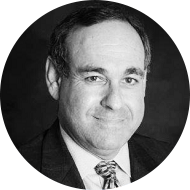


Nick Griffin
Director
Central City Association and Downtown Center BID
Jay Newman
COO
Athens Group
Maki Bara
President
The Chartres Lodging Group
Bob Sonnenblick
Principal
Sonnenblick Development

8:00-9:00 AM Breakfast & Networking
9:00-10:30 AM All-Star Panelists
10:30-11:00 AM Post-Panel Networking
![]()
Intercontinental Century City
Avenue of the Stars
Los Angeles, CA 90067
Floor Level: 1st Ballroom: Grand Salon
Parking Information: Valet only, $16/day

Los Angeles’ hospitality market is booming! Downtown LA is in the middle of a renaissance, making it a magnet for both national and international visitors. DTLA offers plenty of red-carpet events, conferences, incredible restaurants, hip amenities and world class attractions. Urbanization and favorable government regulations are promoting new lodging developments in submarket areas, such as the Fashion District, Art District and Chinatown. Come join key players examining the current state of LA’s hospitality market and discussing economic key drivers and hotel trends that impact tourism and hospitality investments. We will also assess future trends of the DTLA lodging market. And of course, there will be plenty of schmooze & networking time!
![]()

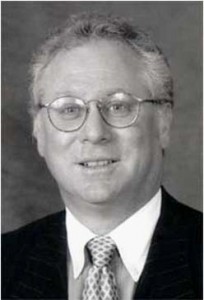 BOB SONNENBLICK
BOB SONNENBLICKMr. Robert Sonnenblick, Principal of Sonnenblick Development, LLC, is a graduate of the Wharton School of Finance of the University of Pennsylvania with more than 30 years of experience in various aspects of real estate development and real estate finance. From 1981 to 1991 Mr. Sonnenblick was the driving force and power behind Sonnenblick-Goldman Corporation of California. Mr. Sonnenblick completed over $1.5 Billion of commercial real estate transactions on the West Coast, and as a result is regarded as one of the West Coast’s leaders in the field of commercial real estate finance. Among the more notable projects for which Mr. Sonnenblick personally structured the financing for are The Beaudry Center, Los Angeles, California ($197 million), the Ritz Carlton Hotel, Pasadena, California ($97 million), One Waterfront Plaza, Honolulu, Hawaii ($100 million), and the Los Angeles World Trade Center, Los Angeles, California ($55 million).
In 1991 Mr. Sonnenblick was appointed Director of Development for the New Jersey and L.A. MetroMalls, with the responsibility for oversight and direction of the design, financing, and leasing programs for two proposed $250 million enclosed regional malls totaling 1.2 million square feet each. Mr. Sonnenblick personally oversaw more than 1 million square feet of leases in connection with this position as well as arranging the necessary debt and equity financing. The New Jersey project opened to one of the strongest starts in the history of the United States mall industry. It is now re-named Jersey Gardens Outlet Mall.
In addition, Mr. Sonnenblick was an original development partner of the Loews Santa Monica Beach Hotel. This 360-room, $90 million hotel was sold for $125 million.
Prior to forming Sonnenblick Development LLC, Mr. Sonnenblick was the senior partner in a Los Angeles-based real estate development firm (Sonnenblick Del Rio Development) which specialized in P-3 public-private partnerships, specifically the development of four government leased office buildings across the Los Angeles basin. During his tenure there as Chairman, Mr. Sonnenblick successfully developed nearly 1 million square feet of government-leased buildings, occupied by such tenants as U.S. Department of Homeland Security, the Federal Bureau of Investigation (FBI), the Los Angeles County Sheriffs Department, Los Angeles County Department of Public Social Services, The Small Business Administration (SBA), the LA County Mental Health Dept, The Social Security Administration, and Los Angeles County Department of Children and Family Services.
Mr. Sonnenblick is a frequent speaker and panelist at various real estate-related functions, such as those hosted by Deloitte Touche, ICSC, Value Retail News, Bloomberg News, Crittenden Conference Co., USC Real Estate, UCLA Real Estate, IMN Real Estate Conferences, Bisnow Media, Opal Conference Group, iGlobal Forum, and the Institute for International Research. Mr. Sonnenblick is a published author on subjects ranging from commercial architecture to general real estate market conditions. In addition to Mr. Sonnenblick’s expertise in development, finance, and joint ventures, Mr. Sonnenblick has also been certified as an expert witness in the areas of real estate bankruptcy/foreclosure and finance. Mr. Sonnenblick is a qualified expert witness on the topic of Commercial Real Estate Interest Rates and Finance for the United States Federal Court System in numerous different jurisdictions across the State of Calif, Nevada, and Arizona.

LodgePress Release: Scottsdale, Arizona
The Lodging Conference, one of the nation’s premier Hotel Industry annual events, is pleased to announce that Los Angeles-based hotel developer Bob Sonnenblick, Chairman of Sonnenblick Development LLC, has agreed to join the “EB-5 and Crowdfunding” panel at their upcoming conference on October 7th at The Arizona Biltmore Hotel in Scottsdale, Arizona. The panel will focus on alternative methods to fund new hotel projects and acquisitions.
11:00 – 12:15
CONCURRENT THINK TANKS
T-2: EB-5 and CrowdFunding: Innovative Options for Your Next Hotel Project
Learn how EB-5 and crowdfunding work as the panel reviews the benefits and pitfalls including legal, regulatory and legislative issues, fees, risk, marketing and timeline to meet your fundraising goal for new construction, acquisition or renovation.
Moderator:
David Eisen, Editor-in-Chief Hotel Management Magazine
Panelists:
Tim L. Edgar, Founder & President, Hotel Innvestor
Julie Richter, Chief Financial Officer Concord Hospitality Enterprises Company
Bob Sonnenblick, Chairman, Sonnenblick Development LLC
Gregory Steinhauer, President, American Life Inc.
For more information, please call (800)-252-3540 or email: info@lodgingconference.com
Or go to: www.Lodgingconference.com
IMN Crowdfunding Conf Press Release: Santa Monica, California
NY-based IMN Real Estate Conferences is pleased to announce its 2nd Annual Crowdfunding Forum for Real Estate, to be held on September 17th at the Fairmont Miramar Hotel in Santa Monica.
The lead panel will be moderated by Los Angeles developer Bob Sonnenblick, Chairman of Sonnenblick development LLC, and it will focus on:
The Future of Crowdfunding as a Money Source for Real Estate Projects.
For more info, go to www.IMN.org or call (212)-224-3207.

PRESS RELEASE: July 8th, 2015
Bob Sonnenblick, Chairman of Los Angeles-based Sonnenblick Development LLC, has been chosen by Bisnow Conferences to be one of the lead panelists at their upcoming 4th Annual Lodging & Investment Conference in Washington DC on October 19.

PRESS RELEASE: 4-20-15
Los Angeles-based real estate developer Bob Sonnenblick has joined the Real Estate Finance panel at the upcoming CFO Forum Conference in San Diego on May 4th. The conference is run by IMN Conferences Inc and will be held at The Park Hyatt Aviara Resort in Carlsbad. The topic of Sonnenblick’s panel is “Real Estate Fundraising: Navigating Different Sources of Capital”.
| 10:00 AM Fundraising: Navigating Different Sources of Capital |
Moderator:
Joseph V. Delaney, CEO, J.V. DELANEY & ASSOCIATES [
BIO ]
Panelists:
Jeff Zuckerman, CFO Western Regions, ALLIANCE RESIDENTIAL COMPANY
[BIO ]
Jerome Fink, Managing Partner, THE BASCOM GROUP, LLC
[BIO ]
Tim Trifilo, Tax Partner and National Tax Lead, COHNREZNICK LLP
Charlie Kellogg, CFO/COO, SINGERMAN REAL ESTATE, LLC
[BIO ]
Bob Sonnenblick, Chairman, SONNENBLICK DEVELOPMENT, LLC
[ BIO ]
|
|
|
|
|
|
Hotel developer Bob Sonnenblick, Chairman of Los Angeles based Sonnenblick Development LLC, has been chosen by Crittenden Conferences Inc. to moderate its “California Real Estate Development – 2015” panel at the upcoming Crittenden National Real Estate Conference in San Diego, California.
The conference will be held at The S.D. Omni Hotel, next door to The San Diego Convention Center, on April 28-30, 2015.
Hour 3: Wednesday, April 29th – 12:00pm – 1:00pm
Moderator: Bob Sonnenblick, Chairman – Sonnenblick Real Estate LLC
John Santry, Executive Vice President of Acquisitions and Development – Shopoff Realty Investments, L.P.
Christopher Piche, Vice President of Development – The Mayer Corp
Mark Strauss, Managing Director – Cohen Financial
For more info, go to www.Crittendenconferences.com
Panel Participants:
Monday, March 9th, 2015 1:45 PM The Developers Due Diligence Perspective… Comparing the Major Platforms.. Why did you Choose your Crowdfunder to Raise Capital?
By Leticia Ordaz
SACRAMENTO, Calif. (KCRA) —The Sacramento County Board of Supervisors voted 5-0 on Tuesday to approve a planned $24 million hotel at the Sacramento International Airport — and it’s expected to bring hundreds of new jobs to the region.
The hotel will be funded by a developer who is planning on building a five-story, 135-room Hyatt Place.
Los Angeles-based Sonnenblick Development is proposing to put a Hyatt hotel in a grassy area next to a parking garage, an open space between the airport’s two terminals.
“(It will be) very easily accessible from Terminal A and Terminal B,” said Robert Sonnenblick, with Sonneblick Development. “You fall out of baggage claim right into our lobby.”
The project will start this spring and generate about 300 construction jobs in the next two years.
Airport travelers are excited already.
“It’s a good thing for Sacramento,” Sydney Dawes said Tuesday. “Growth is great.”
Read full coverage: http://www.kcra.com/news/local-news/news-sacramento/county-set-to-vote-on-hyatt-place-at-sac-international/30945560
 Monday, March 9th, 2015
Session Chair:
Monday, March 9th, 2015
Session Chair:
Panel Participants:
7:00 AM – 9:00 AM
Location
Luxe Summit Hotel Bel Air
11461 Sunset Blvd.
Los Angeles, CA. 90049
Registration
Non-Member – $75.00 (USD)
Students – $25.00 (USD)
With valid student ID
$10.00 – Onsite Fee

Southern California, especially Los Angeles County, is one of the largest Hospitality markets in the United States. A revitalized Downtown Los Angeles, with one of the nation’s largest international airports, and a diverse economy of business, entertainment, international trade, media, fashion, science, technology and education, has contributed to a strong demand for lodging. Experts look to attract as many as 4,000 additional hotel rooms over the next several years. Our distinguished panel will share their thoughts regarding recent trends and strategies for on-going and future hotel development.
24 million hotel will have 135-room capacity
By Leticia Ordaz
8:36 PM PST Jan 27, 2015
SACRAMENTO, Calif. (KCRA) —The Sacramento County Board of Supervisors voted 5-0 on Tuesday to approve a planned $24 million hotel at the Sacramento International Airport — and it’s expected to bring hundreds of new jobs to the region.
The hotel will be funded by a developer who is planning on building a five-story, 135-room Hyatt Place.
Los Angeles-based Sonnenblick Development is proposing to put a Hyatt hotel in a grassy area next to a parking garage, an open space between the airport’s two terminals.
“(It will be) very easily accessible from Terminal A and Terminal B,” said Robert Sonnenblick, with Sonneblick Development. “You fall out of baggage claim right into our lobby.”
The project will start this spring and generate about 300 construction jobs in the next two years.
“It’s a good thing for Sacramento,” Sydney Dawes said Tuesday. “Growth is great.”
An existing hotel was torn down more than six years ago to make room for the new Terminal B. The recession stopped plans for a new hotel at that time.
The economic revival doesn’t stop with the hotel.
Construction crews got an early start Tuesday morning at Bonney Field, the home of Sacramento Republic FC. The team is spending $1.6 million of its own money to expand the stadium’s seating from holding about 8,000 to now 11,000 fans at the Cal Expo site.
The project will send a strong message to Major League Soccer, a Sac Republic spokeswoman said.
“To show them that we can grow to a threshold of 11,000 — and then maybe as high as 14,000 in the future — (it) really shows that there is a demand and a market here in Sacramento,” Erika Bjork told KCRA 3.
Sacramento is among the cities in the running for MLS’s 24th and final franchise. Officials expect the league to make an announcement on expansion plans by June.
“We’re standing where we’ll probably have about 4,000 to 4,500 additional seating in the bleacher section — our most ardent and passionate supporters — our supporters including Tower Bridge Battalion,” said Bjork while showing KCRA 3 around on Tuesday.
Macy’s will also receive tax incentives to set up a warehouse at the former Campbell’s site. The online distribution center for wedding gifts and other goods will generate as many as 350 jobs.
“The warehousing jobs usually average $15 to $20 an hour, which is competitive for our area,” said Troy Givans, the Sacramento County director of economic development.
The worksite for the newly renamed Capital Commerce Center will become a magnet for new jobs.
Tony Bizjak | The Sacramento Bee | January 28, 2015 3:26pm
Jan. 27–Travelers to and from Sacramento International Airport soon will have a place to stay overnight on airport property, although not as grand as once planned.
Sacramento County supervisors Tuesday morning approved a new five-story airport business hotel, seven years after tearing down a smaller one.
The county will team with developer Sonnenblick Industries LLC to construct a 135-room Hyatt Place within walking distance of both airport terminals. The hotel will include an indoor pool and spa, fitness room, dining area and 3,500 square feet of meeting space.
Sonnenblick, a Southern California developer, has built hotels adjacent to medical facilities, but company principal Bob Sonnenblick said this is the first of what he hopes will be several airport hotels his company will develop in the next few years.
The hotel will sit on a triangle of grass adjacent to the north side of the parking garage between the airport’s two terminals. Sonnenblick and airport officials say the hotel will be a major amenity for travelers from around Northern California who want to stay overnight before an early morning flight. The hotel also likely will serve business people and those visiting the Capitol on business.
Sonnenblick said the location on airport grounds should allow his company to charge a premium room rate. He estimated an average night at the hotel would cost $150.
“The advantage we have is that the costumer does not have to get into a minivan and drive 10 to 15 minutes each way to stay at a hotel,” he said. “Our hotel, you literally walk out of baggage claim and into our front door.”
The hotel represents a success for airport officials, who are trying to add amenities and promote their facility as a premier Northern California airport. It is a comedown, though, from what airport officials planned a few years ago. Originally, the new hotel was to be a high-rise built directly on top of the new Terminal B, allowing hotel guests to go from room to plane without stepping outside. The hotel’s lobby would have opened directly onto the terminal ticketing area.
But that plan proved too costly, and was shelved during airport construction. Sonnenblick later explored the possibility of building two hotels elsewhere on airport grounds, one upscale with extensive meeting and ballroom space, the other more modest. Marketing studies, however, determined the upscale hotel would not pencil out, he said.
The proposed hotel will, however, be larger and better appointed than the former Host Airport Hotel, he said. “We are going to build this beautifully.”
The project has been delayed by a flood-related federal moratorium on most new construction in the Natomas basin. But those restrictions are expected to be removed in May or June, and Sonnenblick said his company will be ready immediately to submit project plans to the county for approval.
Sonnenblick expects to spend about $24 million building the hotel, which is expected to open in late 2017.
The developer will pay the airport a one-time fee of $2.46 million for use of 164 ground-floor spaces in the parking garage for guest parking. Sonnenblick will also pay the airport a minimum of $900,000 in total rent across the first four years: $150,000 annually in the first two years and $300,000 annually in the next two years. Thereafter, rent payments will be based on a percentage of hotel gross revenue, estimated at $475,000 in the fifth year.
Sonnenblick has told the county it intends to enter into a “labor harmony agreement” with UNITE HERE Hotel & Restaurant Employee Union Local 49 when hiring workers to operate the hotel, according to a staff report.
Call The Bee’s Tony Bizjak, (916) 321-1059. Bee editor Kevin Yamamura contributed to this report.
5-Story Hotel Approved For Sacramento International Airport
January 27, 2015 1:13 PM
SACRAMENTO (CBS13) – Work will go forward on a hotel at the Sacramento International Airport after Sacramento County supervisors approved the project today.
Sonnenblick Development LLC and the Sacramento County Dept. of Airports will build a 5-story, 135 room Hyatt Place hotel next the parking garage at the airport, county officials announced on Friday.
“Our customers have requested the convenience of an onsite hotel for many years and we are now at a point where we are ready to move forward,” said Director of Airports John Wheat said in a statement.
Officials have been looking to build a hotel at the airport since the previous airport was demolished in 2008 to make room Terminal B.
Construction could begin as early as June 2015, and the hotel would open in 2017, airport officials say.
Sonnenblick is reportedly investing $23 million to build the hotel.
BEE METRO STAFF
01/27/2015 12:00 PM 01/27/2015 1:35 PM
Sacramento County supervisors Tuesday morning approved a new five-story business hotel at Sacramento International Airport, seven years after tearing down the old facility.
Supervisors voted 5-0 to work with developer Sonnenblick Industries LLC to construct a 135-room Hyatt Place within walking distance of both airport terminals. The hotel will include an indoor pool and spa, fitness room, dining area and 3,500 square feet of meeting space.
Sonnenblick has told the county it intends to enter into a “labor harmony agreement” with UNITE HERE Hotel & Restaurant Employee Union Local 49 when hiring workers to operate the hotel, according to a staff report.
The developer will pay the airport a one-time fee of $2.46 million for use of 164 ground-floor spaces in the parking garage for guest parking. Sonnenblick will also pay the airport a minimum of $900,000 in total rent across the first four years: $150,000 annually in the first two years and $300,000 annually in the next two years. Thereafter, rent payments will be based on a percentage of hotel gross revenue, estimated at $475,000 in the fifth year.
Though they support building a new airport hotel, some supervisors were not impressed Tuesday with the first drawing of the Hyatt Place hotel, telling staff that they want to review the structure’s design in the future.
“It appears it’s a concrete block facade,” said Supervisor Roberta MacGlashan. “It needs to blend in better.”
Hotel construction is expected to take two to three years. Sonnenblick is projected to spend about $24 million building the hotel.
Bee staff writer Brad Branan contributed to this report.
Read more here: http://www.sacbee.com/news/local/article8307690.html#storylink=cpy
By Sharokina Shams 7:25 PM PST Jan 23, 2015
SACRAMENTO, Calif. (KCRA) —The Sacramento International Airport could finally have a new hotel if plans that have been years in the making are approved next week.
Sonnenblick Development, a Los Angeles-based developer, is proposing to put a Hyatt Place hotel in a grassy area next to a parking garage, an open space between the airport’s two terminals.
Watch report: Plans in the works to build hotel at Sac Int’l
An existing hotel was torn down more than six years ago to make room for the new Terminal B and the recession stopped plans for a new hotel at that time.
The new terminal, which cost roughly $1 billion, has left the airport in debt and forced budget cuts.
Wheat said a new hotel, in addition to giving travelers a convenient place to stay, would also bring in new money.
“Everything helps, I mean, it’s a revenue,” Wheat said.
The $24 million in construction costs would be paid by the developer, who would pay the airport about $2.5 million up front, and several hundred thousand dollars a year to lease the property.
On Friday, some travelers said a new hotel would make traveling more convenient for out-of-town visitors and for travelers from around Northern California.
“If you’re leaving on a long trip and have a very early departure, that might be a good idea,” said Neil Robinson, who said he lives in Folsom.
See also:
Video Transcript
INTERVIEW WITH SABRINA RODRIGUEZ RIGHT NOW ON KCRA.COM. PLANS ARE MOVING FORWARD TO BUILD A HOTEL AT SACRAMENTO INTERNATIONAL AIRPORT. IF COUNTY LEADERS APPROVE THIS PLAN, THE HOTEL WOULD BE BUILT HERE IN THIS GRASSY AREA BETWEEN TERMINAL A AND TERMINAL B. AND THE NEW HYATT PLACE HOTEL WOULD LOOK LIKE THIS. KCRA 3’S SHAROKINA SHAMS IS LIVE AT THE AIRPORT AND THESE PLANS AREN’T REALLY NEW. NOW IT LOOKS LIKE IT WILL HAPPEN. THAT’S RIGHT. THESE PLANS HAVE BEEN A LONG TIME IN THE MAKING. WE CAN TAKE A LOOK OUTSIDE OF THE WINDOWS AND GIVE YOU A LOOK AT THE SITE BEHIND ME LOOKING OUT THE WINDOWS OF THE BACK OF TERMINAL B. THE HOTEL WOULD GO WHERE THAT ART WORK SITS OUTSIDE A PARKING GARAGE. IT COULD MEAN A MUCH-NEEDED FINANCIAL BOOST FOR A COUNTY AIRPORT THAT HAS A LOT OF DEBT. DUSTIN BILTON IS VISITING SACRAMENTO TODAY WITH HIS 18-MONTH-OLD SON. NORMALLY, HE’S HERE ON BUSINESS AND LIKES THE IDEA OF A HOTEL AT SACRAMENTO INTERNATIONAL AIRPORT. FOR ME AS A MANAGER, IF I WANT TO HOST A MEETING HERE, IT GIVES ME ANOTHER OPTION, TOO. FOR ANOTHER REASON THAT WE WOULDN’T GO TO SAN FRANCISCO. IT WOULD GIVE SACRAMENTO ANOTHER OPPORTUNITY. THIS ART SHOWS WHAT HYATT IS PLANNING — A NEW, 135-ROOM HOTEL LIKE THIS HYATT PLACE HOTEL WHICH WAS BUILT IN ROSEVILLE, NEAR THUNDER VALLEY CASINO FIVE YEARS AGO. EVERYBODY’S GOING TO HAVE JOBS. IT’S KIND OF A PEBBLE IN THE WATER, IT GOES OUT FROM THERE. AN EXISTING HOTEL HERE WAS TORN DOWN SIX YEARS AGO TO MAKE ROOM FOR THE NEW TERMINAL B. WITH A COST OF $1 BILLION, THIS TERMINAL HAS ALSO BROUGHT DEBT TO THE AIRPORT AND FORCED BUDGET CUTS. BUT A NEW HOTEL, SINCE IT WOULD BE PAID FOR BY THE DEVELOPER, COULD HELP PUT A DENT IN THAT. HYATT WOULD PAY THE AIRPORT $2.5 MILLION UP FRONT AND THEN SEVERAL HUNDRED THOUSAND DOLLARS A YEAR TO LEASE THE PROPERTY. JOHN WHEAT IS THE COUNTY’S AIRPORT DIRECTOR. EVERYTHING HELPS. I MEAN, IT’S A REVENUE. IT REALLY BENEFITS THE PEOPLE WITHIN OUR PRIMARY REGION, A REGION ALL THE WAY UP TO REDDING, YOU KNOW, WITHIN 100 MILES OF THIS AIRPORT. THERE WERE PLANS FOR A NEW HOTEL AS TERMINAL B WAS GOING UP, BUT THEY WERE SCRAPPED BECAUSE OF THE RECESSION. TODAY THOUGH, IT WASN’T JUST FAR-AWAY TRAVELERS WHO TOLD US THEY’D STAY IN A HOTEL HERE. NEIL ROBINSON LIVES IN FOLSOM. IF YOU’RE LEAVING ON A LONG TRIP AND HAVE A VERY EARLY DEPARTURE, THAT MIGHT BE A GOOD IDEA. IN CASE YOU’RE CURIOUS, HYATT IS SET TO SPEND $24 MILLION BUILDING THE HOTEL. THIS ISN’T A DONE DEAL UNTIL THE COUNTY BOARD OF SUPERVISORS APPROVES IT. THEY’RE SET TO CONSIDER IT AT THEIR MEETING NEXT WEEK.
Mark Anderson
Staff Writer- Sacramento Business Journal
A $23 million Hyatt Place hotel proposed for Sacramento International Airport could be open in 2017.
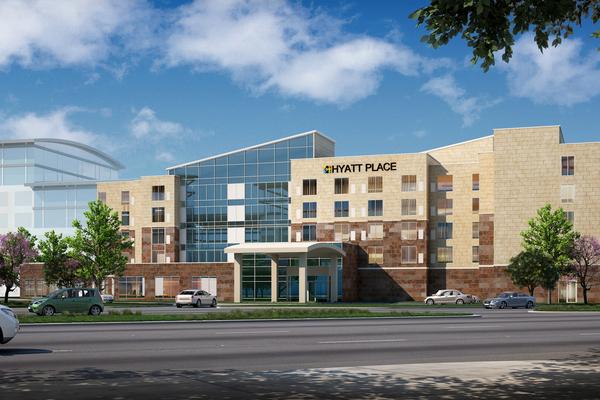
This rendering depicts a Hyatt Place hotel proposed for Sacramento International Airport. It could be open in 2017, if Sacramento County approves a development agreement.
Shimahara Illustration
Sacramento County supervisors at their meeting Tuesday will consider a development agreement with Los Angeles-based real estate development firm Sonnenblick Development LLC to build a 135-room hotel between the airport’s main commercial terminals. The hotel would feature indoor pool and spa, fitness room, a dining area and 3,500 square feet of meeting space.
Hospitality company Sonnenblick-SMF LLC would develop and operate the hotel, paying the county a fixed fee of $900,000 though the first four years of operations, and then a percentage of gross revenue. That scale would be 5 percent from years five through 19, 6 percent in years 20 through 39 and then 7 percent of gross in years 40 through 50.
The developer also would pay a one-time fee of $2.5 million to use 164 spaces in the airport’s parking garage.
“Our customers have requested the convenience of an onsite hotel for many years and we are now at a point where we are ready to move forward,” said Sacramento County Airport System director John Wheat.
If approved, construction could begin by June, when federal flood map building restrictions on the Natomas Basin are lifted.

A $23 million Hyatt Place hotel proposed for Sacramento International Airport could be open in 2017, if Sacramento County approves a development agreement. This is the site.
Sacramento County Department of Airports
Hyatt Place is a limited-service property. Locally, there are Hyatt Place properties in Davis, Rancho Cordova and Roseville.
Sacramento County, which operates the airport, has been seeking a hotel for more than a decade. The previous hotel at the airport, the Host Airport Hotel, was successful, but the small hotel was demolished for the expansion of the airport’s new terminal and parking garage.
Sonnenblick-SMF LLC would negotiate a contract with the UNITE-HERE Local 49, the local hotel and restaurant employees union. The previous hotel had been a union shop.
The county says if the Hyatt Place is successful, a second hotel is possible.
The airport is a demand driver for the hotel. Many flights out of Sacramento leave very early in the morning, so travelers from all over Northern California could use the hotel to arrive the night before traveling. Also, the hotel, like the airport, is right off Interstate 5, which can generate demand from drivers. Another potential business for the hotel is air crew rooms. Many airlines have contracts that require them house their flight crews in nearby hotels.
January 23, 2015 1:52 PM
SACRAMENTO (CBS13) – A Los Angeles developer is looking to build a hotel at the Sacramento International Airport, county officials announced Friday.
Airport officials will be meeting the Sacramento County Board of Supervisors come Tuesday for approval of the plan. Sonnenblick Development LLC and the Sacramento County Dept. of Airports reportedly have an agreement to build a 5-story, 135 room Hyatt Place hotel next the parking garage at the airport.
“Our customers have requested the convenience of an onsite hotel for many years and we are now at a point where we are ready to move forward,” said Director of Airports John Wheat in a release.
Officials have been looking to build a hotel at the airport since Host Hotel was demolished in 2008 to make room Terminal B.
If the new hotel plan is approved, construction could begin as early as June 2015 and the hotel would open in 2017, airport officials say.
Sonnenblick is reportedly investing $23 million to build the hotel.

January 24, 2015 by bboyd Leave a Comment
THE NATOMAS BUZZ | @natomasbuzz
The Sacramento County Board of Supervisors will decide Tuesday whether to approve an agreement that will allow a five-story hotel to be built at the Sacramento International Airport.
The Sacramento County Department of Airports will go before the board on Jan. 27 to request approval of an agreement with a developer to build a long-sought onsite hotel at the airport. The Sacramento County Department of Airports is responsible for planning, developing, operating and maintaining the county’s four airports: Sacramento International Airport, Executive Airport, Mather Airport and Franklin Field.
Sonnenblick Development LLC has proposed building five-story, 135-room Hyatt Place hotel with an indoor pool and spa, fitness room, dining area and 3,500 square feet of meeting space.
The Los Angeles-based developer plans to lease a 1.4-acre site adjacent to the parking garage for construction of the hotel, as well as 164 spaces on the ground level of the garage. The hotel would be accessible to passengers of both terminals.
Construction could begin as early as June 2015, when federal building restrictions on the Natomas Basin are expected to be lifted. In that scenario, the hotel would open in 2017 or 2018.
Sonnenblick has agreed to invest at least $23 million to build the facility. The Department of Airports will receive a one-time payment of $2.46 million for the use of the parking garage spaces. Rent for the hotel site will be fixed for the first four years for an amount totaling $900,000. In subsequent years, rent will be paid as a percentage of gross revenue.
An in-terminal hotel was in the works for the new Terminal B but was removed from plans due to the economic downturn. Airport staff performed a site analysis and in 2011 issued a Request for Proposals for hotel development. Sonnenblick responded to the RFP with a proposal to develop two hotels. If the Hyatt Place is successful, a second hotel is a possibility.
The onsite Host Hotel was demolished in 2008 to make room for Terminal B construction. Under the agreement going to county supervisors this week, Sonnenblick LLC would pay for construction and assume the financial risk associated with owning and operating the hotel.
The item is number 51 on the agenda and is scheduled for 10:45 a.m. Tuesday. Click here for more information
– See more at: http://www.natomasbuzz.com/2015/01/airport-seeks-approval-for-five-story-hotel/
Posted 12:32 PM, January 23, 2015, by Sam Cohen, Updated at 12:37pm, January 23, 2015
Sacramento International Airport is seeking approval for plans to build a five-story, 135-room hotel onsite.
A Los Angeles-based developer is proposing to build a Hyatt Place hotel near the parking garage, with access to both terminals. Plans include an indoor pool and spa, fitness room, dining area and 3,500 square foot meeting space.
The Sacramento County Department of Airports will take their plan to the Board of Supervisors on Tuesday.
If approved, construction could begin this summer when building restrictions in the Natomas area are expected to be lifted. It could take more than a year to build the hotel.
An onsite hotel was demolished almost six years ago to make room for the new Terminal B. The new plans have the developer,
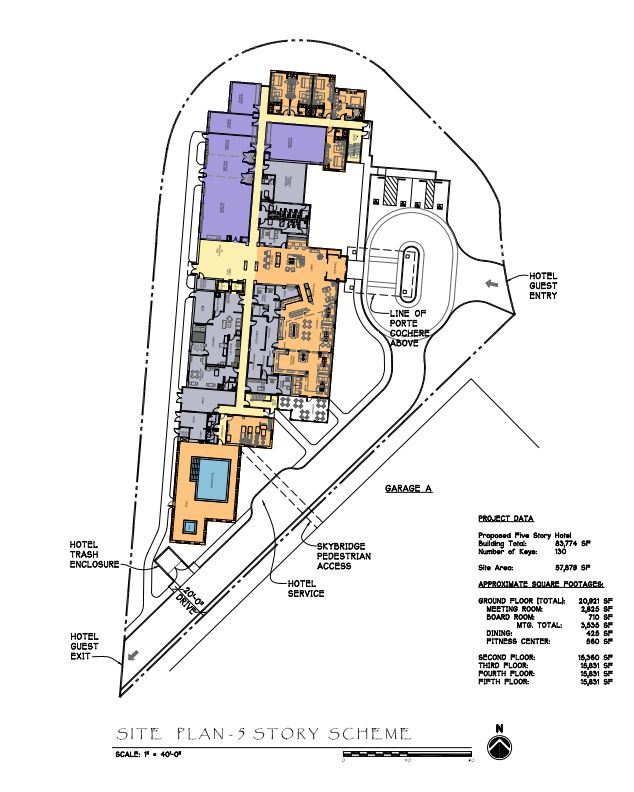


This rendering depicts a Hyatt Place hotel proposed for Sacramento International Airport. It could be open in 2017, if Sacramento County approves a development agreement.Shimahara Illustration
By Tony Bizjak tbizjak@sacbee.com
01/23/2015 9:31 PM
Seven years after tearing down the old airport hotel, Sacramento International Airport has reached a deal with a private developer to build a new facility on site – a five-story hotel that will sit within short walking distance of both passenger terminals.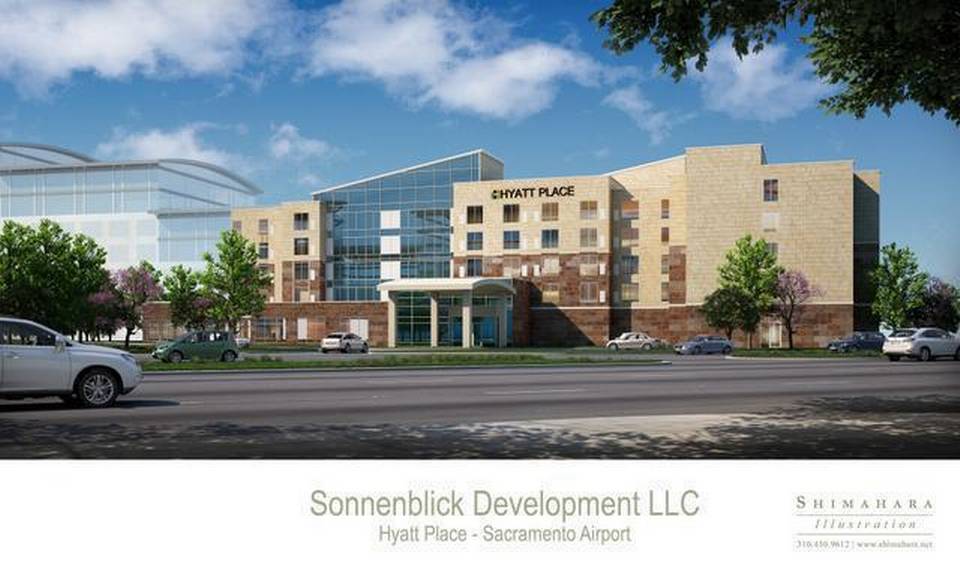
The deal, years in the making, will provide airport customers with a privately built 135-room Hyatt Place. The hotel will include an indoor pool and spa, fitness room, dining area and 3,500 square feet of meeting space.
Airport director John Wheat called the hotel deal a double bonus, returning a major passenger amenity to airport grounds and providing a needed income boost. Airport officials have sought ways to boost revenue to pay down a $1 billion debt load from the recent construction of a new terminal and passenger concourse building.
“It is definitely a nice convenience to our passengers,” Wheat said. “We look at it as a customer service. And, secondly, it generates additional revenue to the airport system.”
The developer, Sonnenblick Industries LLC of Southern California, has been negotiating for two years with the county on the deal. Sonnenblick , the sole company to respond to the airport’s request for proposals, specializes in government buildings but has built a number of hotels and increased its hotel development in recent years.
The airport tore down the previous on-site hotel in 2008 to make room for Terminal B. Officials had originally planned to build a new hotel several years ago as part of the Terminal B expansion project, but were forced to eliminate it as a cost-saving move during the recession.
Until recently, the airport and other Natomas-area landowners have been unable to build new structures because of a de facto building moratorium until flood improvement funding was authorized. That moratorium appears ready to be lifted this spring or summer.
Airport officials will present the deal to the county Board of Supervisors on Tuesday for approval.
According to a staff report for that meeting, Sonnenblick will build the hotel on a 1.4-acre site it will lease from the airport next to the parking garage. The developer will pay the airport a one-time fee of $2.46 million to use 164 ground-floor spaces in the garage for guest parking.
The company also will pay the airport an annual $900,000 in rent for the first four years. In year five and beyond, the rent will be set at a percentage of hotel gross revenue, estimated to be about $475,000 in year five.
The hotel construction cost, to be borne by Sonnenblick, is expected to be about $24 million. Construction is expected to take two to three years.
The hotel site will be on a triangular grassy area, currently unused, at the north end of the parking garage.
Call The Bee’s Tony Bizjak, (916) 321-1059.
Jan 23, 2015, 7:25am PST
Mark Anderson Staff Writer- Sacramento Business Journal

Todd Quam | Digital Sky Aerial Imaging
In a major step forward for Sacramento International Airport, county supervisors on Tuesday will consider a development agreement for a 135-room Hyatt Place hotel to be built between the two passenger terminals.
In a major step forward for Sacramento International Airport, county supervisors on Tuesday will consider a development agreement for a 135-room Hyatt Place hotel to be built between the two passenger terminals.
Sacramento County, which operates the airport, has been seeking a hotel for more than a decade. The previous hotel at the airport, the Host Airport Hotel, was successful, but the small hotel was demolished for the expansion of the airport’s new terminal and parking garage.
The five-story hotel would be just north of new parking structure at the airport, between the two commercial airline terminals.
Hospitality company Sonnenblick-SMF LLC would develop and operate the hotel, paying the county a fixed fee of $900,000 though the first four years of operations, and then a scale of percentage of gross revenue. That scale would be 5 percent from years five through 19, 6 percent in years 20 through 39 and then 7 percent of gross in years 40 through 50.
Hyatt Place is a limited-service property. Locally, there are Hyatt Place properties in Davis, Rancho Cordova and Roseville.
Sonnenblick-SMF LLC would negotiate a contract with the UNITE-HERE Local 49, the local hotel and restaurant employees union. The previous hotel had been a union shop.
The 2nd Annual Boutique Hotel Investment Conference BLLA held in New York 2014
Bob Sonnenblick Moderating: New York Boutique Hotel Investment Conference.
November 21 2014 Speakers at the Caribbean Hotel Investment Conference & Operations Summit lament a lack of financing that has created a dearth of deals, but they don’t expect it to last forever.
By Jeff Higley
Editorial Director
jeff@hotelnewsnow.com
The biggest issue is easy to spot, panelists said. Despite strong performance fundamentals for the region’s hotel industry, lenders are reluctant—and in a number of cases unable—to throw their hats in the ring when it comes to deals.
“The performance numbers aren’t translating into the availability of capital,” said Gary Brough, managing director of KPMG, during the “Capital and the new normal” general session.
“Right now there is a ton of money going into the hotel business in the (U.S),” said Bob Sonnenblick, principal of Sonnenblick Development. “It’s going to take time to trickle down here.”

Adam Rosenberg (right) of Fortress Investment Group and Gary Brough (center) of KPMG react to a comment from Bob Sonnenblick of Sonnenblick Development during the -Capital and the New Normal- session at last week’s Caribbean Hotel Investment Conference – Operations Summit. (Photo: Jeff Higley) –
“The good and the bad of the region is oftentimes the absence of senior debt, or if there is senior debt you’re talking about 50% equity,” added Nick Hecker, senior principal at Och-Ziff Real Estate.
Bill Sipple, executive managing director of HVS Capital Corporation, said it’s difficult to source capital for the Caribbean, but cracks in the armor are starting to appear. He said one bright spot is U.S. commercial mortgage-backed securities lenders, which are starting to show an interest in the region.
“They’re seeking ways of finding new avenues that are less competitive and where they can get higher yields,” Sipple said.
Lorne Bassel, president and CEO of Crave Real Estate, said during the “Investor/capital provider outlook” general session that investors who have a clear intent to stay in the deal for the long run are more apt to obtain financing.
“(Lenders) want to see a compelling vision in the plan that makes your project different,” Bassel said. “Marina, golf and beach just isn’t enough. They want to see you bought in financially for the next 10 years.”
But Ali Elam, managing director of Fortress Investment Group, said there’s a simple reason large banks aren’t lending into the Caribbean: “They simply do not have the facility to make loans in the Caribbean. It’s not something they invested in infrastructure for.”
Another issue is rating agencies don’t have coverage in all 32 countries in the Caribbean, Elam said.
The obvious lack of capital creates a shallow deal environment in the region.
George Spence, principal of Leading Property Group, said while some deals have been completed during the past 18 months, it’s going to take at least that long for the flow to increase.
“The Caribbean is 18 to 24 months behind the U.S. in terms of capital and new deals going on,” he said.
Spence noted several key transactions in the Caribbean during 2013 and 2014, including the former Ritz-Carlton Rose Hall in Jamaica that sold to Playa Hotels & Resorts for $70 million and rebranded as the Hyatt Zilara Beach, and the 105-room One & Only Ocean Club in the Bahamas that was sold to Access Industries for a reported $1 million per room.
Interest is building
There is growing interest in acquiring hotels in the region from players such as Fortress Investment, according to managing director Adam Rosenberg. But a deal would have to meet certain criteria for the company to make an acquisition.
“There’s a paradox,” Rosenberg said. “The world seems awash in capital … yet it’s very hard to find a deal from a return perspective. It’s hard to find things that are the right fit. (The Caribbean is) off the radar for a lot of capital providers.”
Sipple said the appetite for projects in the Caribbean tend to be in the $30-million to $100-million range.
“It doesn’t have to be a mega deal to get interest,” Sipple said. “There’s a lot of non-resort type of properties that can be built here. There’s a need for them.”
“If you’re going to spend the time to put capital out, you might as well do a large project,” Sonnenblick said, acknowledging that select- and limited-service properties have a place at airports in the region.
Elam said Fortress’ acquisition of the debt on the Westin Grand Cayman Seven Mile Beach Resort and its refinancing of the Aruba Marriott Resort is proof the company thinks the recovery in the Caribbean will continue. The two deals combined equated to a $470-million investment he said.
“Investment in the Caribbean will always be a deep pocketed investment game, knowing that eventually you’ll have an investment that’s unique,” Elam said.
Help from governments go a long way
Panelists agreed that some of that investment should be offset by governments that want to attract development and capital infusion into their countries.
A prime example of that is the Dorado Beach, A Ritz-Carlton Reserve, in Puerto Rico, according to Kenny Blatt, principal and COO for CPG Real Estate, which owns the property.
“Government participation allowed us to slog through three or four tough years,” Blatt said during the “Hospitality Leaders Outlook” panel.
The $1,200 to $1,300 average daily rate for the property has given CPG reason to develop the other 1,400 acres of land around the project, according to Blatt. The company refinanced Dorado Beach on Wednesday with Och-Ziff providing the financing.
“It gives us liquidity to build real estate, including hopefully building a second hotel site,” Blatt said.
The effects an active government can have on resort development and transactions aren’t always visible, speakers said.
“When people talk about cash flows and returns on a project, the first question I have is always, ‘What is the tax impact?’” Hecker said.
There’s also a difference between strategic investment and economic investment in the Caribbean, panelists said.
“The most strategic investor is generally the government,” Sonnenblick said. “I’m surprised there isn’t more going on in the Caribbean where the government is doing more.”
John Keith, managing director for Caribe Hospitality, said policies of some of the Caribbean governments, especially the foreign exchange rates, make it difficult for the hotel industry to be successful.
“I would challenge the governments to review their policy,” he said, adding they must understand they are competing in a world full of alternatives.
November 14, 2014

Bob Sonnenblick panelist at Hotel Summit on November 11th, 2014 in Los Angeles
Sonnenblick Development principal Bob Sonnenblick, a panelist, says LA just finished its best 12 months ever in total volume of hotel bookings and tourism, and supply is under control. In general, the coasts are very strong but the middle of the country is still fairly flat. He’s 100% concentrated on new development, but his biggest problem is that there is no land left in LA. (It’s why Katy Perry is always Walkin’ on Air.)
Rich says he’s seeing a lot of deals for limited and select-service hotels, and fewer full-service ones being built. Bob says the former have a higher profit margin because you don’t have a big spa, room service or gobs of meeting space. “It’s a rooms-only box.” Brian says the debt and equity markets love limited service because they view it as less risky. For his San Francisco project, he cobbled together EB-5 financing, historic and New Market tax credits, and a low-leverage senior construction loan.

11:15 A.M. TO 12:15 P.M. – GENERAL SESSION: CAPITAL AND THE NEW NORMAL: Panel of capital providers and advisers discuss investments in the Caribbean and what it takes to get a deal done. Who is financing projects in the Caribbean and on what basis? While it appears that confidence in the region
amongst financiers is improving this does not appear to be translating into readily available capital. Funding has been scarce for so long that it appears as if the landscape may have changed permanently. Does this environment represent the “new normal”? If so what does the new normal look like? How are
deals currently being structured? What are the key terms and conditions? Who are we dealing with and how sustainable are their interest in the region? The ability to raise capital is going to be absolutely critical if, as appears to be the case, the region is over the worst of the economic cr isis and we can start
to look forward to the future with cautious optimism. Help us resolve this crucial issue by participating in an interactive discussion with our panel of innovative and imaginative financiers bringing a fresh approach to a difficult and complex problem.
Moderator: Gary Brough, Managing Director- KPMG
Panelists:
Nicholas Hecker, Senior Principal – Och Ziff Real Estate
Bill Sipple, Executive Managing Director – HVS Capital Corp
Bob Sonnenblick, Principal-Sonnenblick Development LLC
Adam Rosenberg, Global Head of Gaming & Leisure- Fortress Investment Group-Credit Funds
![]()
Los Angeles Hotel
Oct 31, 2014

Sonnenblick Development principal Bob Sonnenblick
This morning, Sonnenblick Development principal Bob Sonnenblick (in full Halloween mode before trick-or-treating with his kids in Pacific Palisades) told us about his newest resort hotel project: Chambers Bay Resort in University Place, WA, a 30-minute drive from Sea-Tac Airport. What’s key for Bob, an avid golfer, is that next June, it’s going to be the home course of the 2015 US Open, where it will be seen by 300 million people on TV. Bob’s building a 320-room luxury hotel with a 40k SF conference center and a 10k SF spa, with a second golf course that will front directly on Puget Sound. The new course is being designed by the famed Robert Trent Jones Jr.
Bob says Chambers Bay is a $125M project. The hotel will be raised, so that people can look through the glass on the first floor and still enjoy the views (including the snow-capped peaks of the Olympic Mountains). He’s also working on a hotel site in the hot market of downtown Beverly Hills. Bob just got back from the best vacation of his life: two weeks in Phuket, Thailand.
Read on BISNOW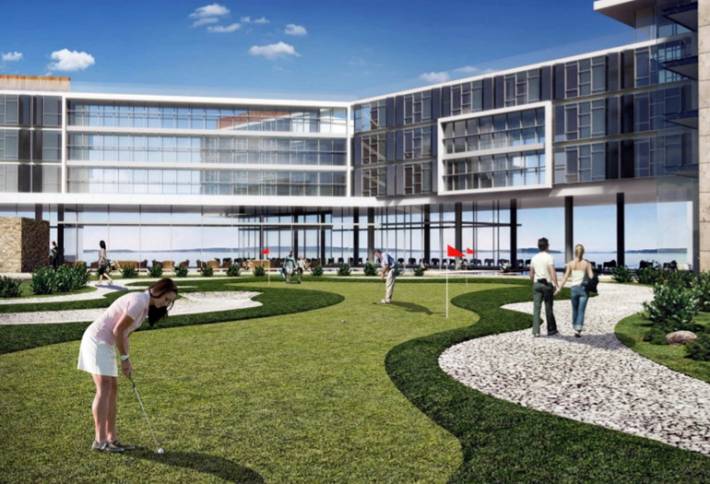
Los Angeles
| Los Angeles 11.07.2014 |
| LA HOTEL BOOM! A RACE TO THE TOP |
|
Jay Newman Clare de Briere Bob Sonnenblick |
| — Fri Nov 07, 2014. Millennium Biltmore Hotel Los Angeles — |
![]()

Jay Newman
COO
Athens Group

Clare de Briere
COO
The Ratkovich Company

Bob Sonnenblick
Principal
Sonnenblick

|
8:00-8:30 AM
|
Continental Breakfast & Networking | |||
| 8:30-10:30 AM | All-Star Panelists | |||
|
10:30-11:00 AM
|
Post-Panel Networking |
 Please join Bisnow for a great morning of top speakers and networking with members of the Los Angeles hotel investment community. We’ll cover how deals are getting done and what the outlook is for financing and development in the coming year.
Please join Bisnow for a great morning of top speakers and networking with members of the Los Angeles hotel investment community. We’ll cover how deals are getting done and what the outlook is for financing and development in the coming year.
(Gold Ballroom, Lobby Level) 506 South Grand Avenue Los Angeles, CA, 90071
Parking: $10 self, $22 valet
MORE INFORMATION!
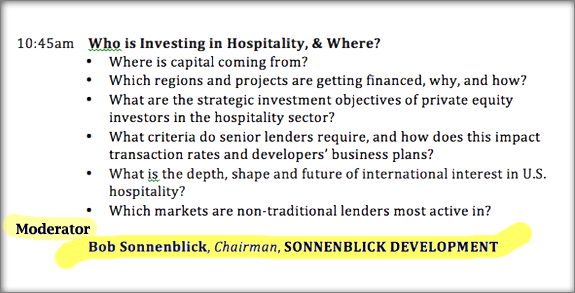

September 29, 2014

The ground floor would be all glass so people walking onto the property can enjoy the views.
Robert Sonnenblick is the man who wants to build a $150 million resort at Chambers Bay, and he says as soon as he saw the location it was love at first sight.
“That site at Chambers Bay, on a scale of one to 10, is a 12,” said the Los Angeles-based developer. He plans to build a 258-room hotel, conference center and second golf course at the site in University Place where the U.S. Open will be played next June.
“To me, I’m shocked that no one built a hotel prior to me getting involved,” Sonnenblick said. “I fell in love with it the instant I walked onto the property.”
Sonnenblick is chairman of Sonnenblick Development, which was formed in 2011 to specialize in four-star oceanfront resort hotels across the country, with a focus on high-end golf resorts.
Sonnenblick heard about Chambers Bay about a year and half ago while working on a golf course and hotel development near Pinehurst Resort in North Carolina. Someone with the United States Golf Association told him Chambers Bay is hosting the 2015 U.S. Open and there weren’t any hotels near the golf course.
Sonnenblick was in Seattle for a business trip and decided to visit the golf course, which is owned by Pierce County. He said he stopped dead in his tracks when he set foot on the property, awed by the sweeping views of Puget Sound and the Olympics. He called it the best site for a hotel he has ever seen.
Part of Sonnenblick’s plan is to convert Pierce County’s award-winning Environmental Services Building into a 48,000-square-foot conference center and add a ballroom for weddings. The Environmental Services Building was designed by The Miller Hull Partnership.
“To have that already on the property is something that we’re thrilled with,” he said.
Pierce County is planning to build a new headquarters on the campus of the former Puget Sound Hospital and consolidate a third of its 3,000 employees. Officials say it’s too soon to say where employees now housed in the Environmental Services Building would go.
Construction of the county’s new headquarters could begin early next year. The county has picked a team headed by Wright Runstad Associates, with NBBJ Architects, Gunsul + Iverson Architects and Howard S. Wright. The headquarters could open by mid-2016.

More walking paths and biking trails would be built on the property to appeal to locals
Sonnenblick is big on views, and they are plentiful at Chambers Bay.
The new hotel will be raised about 22 feet in the air and the ground floor will be all glass so people walking onto the property can enjoy the views.
The hotel will have two restaurants and two bars. Sonnenblick said one of the bars will be like the “19th hole” found at most golf courses.
Adding a second golf course is an important part of the plan. Sonnenblick said the existing course is fescue grass and golf carts aren’t allowed, so it’s a walk-only course — and that doesn’t work with a hotel.
“The reason we need a second course is the normal tourist golfer does not walk,” he said.
Golfers will likely have better scores on the second course because it will have wider fairways and a more forgiving layout.
Sonnenblick also said he wants a “huge” increase in the number of walking paths and biking trails on the property to appeal to locals.
Sonnenblick said the plan is to offer discounts on rooms, food and beverages to people from University Place, Lakewood and Steilacoom.
His team just finished architectural renderings for the project and hopes to start construction next year.
“I want to start the day the U.S. Open finishes next June,” he said. “I don’t think the county or the city will be ready for us to start by then, so it will probably be a couple of months after that.”
Sonnenblick said the U.S. Open will generate tremendous publicity for his project before it even opens because Chambers Bay will be on the cover of golf magazines and featured on golf shows, just like Pinehurst was earlier this year.
Sonnenblick said he wants to build the hotel and golf course simultaneously and hopes to open both in mid-2017. He said the entire project will be privately funded.
The golf course design should be finished in about a month by architect Robert Trent Jones Jr., who also designed the original Chambers Bay Golf Course.
Other team members are: the Los Angeles office of Harley Ellis Devereaux, architect; Absher Construction of Puyallup, general contractor; KPFF of Tacoma, civil engineer; PCS Structural Solutions of Tacoma, structural engineer; and Transpo Group of Kirkland, traffic consultant.
(Editor’s note: This article was changed to reflect that PCS Structural Solutions is the structural engineer, and that the county hasn’t decided where to relocate its workers at the Environmental Services Building.)
Sonnenblick said he expects to hire a lot of local subcontractors.
This is Sonnenblick’s first project in Washington state, but not his first business venture here. He has financed several projects here over the years, including a $165 million construction loan and $35 million equity joint venture in the mid-1980s for Herman Sarkowsky’s AT&T Gateway Tower (now Seattle Municipal Tower).
Sonnenblick said several local companies have approached him about doing other projects since word got out about Chambers Bay. He said he is open to sites with views and waterfront access, but first wants to get the ball rolling on this one.

By Steve Maynard
Staff writer September 23, 2014
A Los Angeles developer unveiled drawings Tuesday for a resort at Chambers Bay in University Place that would be big and dramatic with a five-story hotel and sweeping views of Chambers Bay Golf Course and a proposed second course.
Click for Chambers Bay Resort Brochure
Chambers Bay Resort would consist of the 258-room hotel, a conference center, a 180-seat cafe and restaurant, and a swimming pool. The conference center would be located in what is now the county’s environmental services building, with a ballroom added on.
Pierce County Council members saw the architectural renderings for developer Bob Sonnenblick’s project for the first time Tuesday.
“That is the public’s property,” Ladenburg said. Those public amenities include the trails, parks and playground as well as the golf course where the 2015 U.S. Open will be played.
Her husband, John Ladenburg, was the county executive who spearheaded developing the former gravel mine into a championship golf course in 2007.
“To make sure that (citizens) still feel that that’s their property, I think, is very key with any development that we do out there,” said Connie Ladenburg, whose district includes University Place.
“We totally agree,” said county Executive Pat McCarthy. “Any place you put anything on this property is going to impact something. But the fact of the matter is we do have a philosophy that it does need to have good public access.”
County-owned Chambers Bay Golf Course will host the U.S. Open June 15-21 of next year. The resort hotel proposal is many months away from a final decision and would not interfere with the golf championship.
Deputy County Executive Kevin Phelps said it will take up to 18 months to update the master site plan, which would require approval by the County Council and the City Councils for both University Place and Lakewood.
The County Council likely would have to authorize the county executive to enter into an agreement with Sonnenblick.
Sonnenblick started a second 90-day extension granted by McCarthy for planning the project last week.
Phelps said Sonnenblick will have to propose financing that meets the county’s needs. The master site plan must be modified, and Sonnenblick must determine if he can fit in a second golf course.
Sonnenblick, chairman of Sonnenblick Development, said his $150 million project will enhance public access to Chambers Creek Regional Park.
“I am designing the hotel to increase public access,” Sonnenblick said in a phone interview Tuesday. “We are going to add a huge number of walking and biking trails.”
He said the project’s lower levels would be lifted up and lined with glass so that visitors could see the Puget Sound and the Olympic Mountains.
 “We’re very excited about the project, and we designed it based on the input from a lot of local groups,” he said.
“We’re very excited about the project, and we designed it based on the input from a lot of local groups,” he said.
Sonnenblick hired Robert Trent Jones Jr.’s company to design the second golf course. Jones also designed the original Chambers Bay Golf Course.
Hole routings for the second course are expected to be completed in about three weeks, Sonnenblick said.
A second 18-hole course where golfers could ride carts is crucial for attracting older, higher-income customers to the resort, Sonnenblick said. Chambers Bay prohibits carts to prevent damage to fescue grass on the links-style course.
Sonnenblick met with University Place planners last month to ask questions of city planning staff as it related to his proposed development.
The City of University Place is waiting to see more detailed information about how the site will be developed, including plans for the second 18-hole golf course.
“We’ve only seen renderings of the hotel, we haven’t seen any maps or site plans,” UP City Manager Steve Sugg said Tuesday. “It’s our practice that we don’t react to renderings.”
But Sugg did say the city is interested in the project.
“The idea of a destination golf resort in UP is certainly appealing, but the details will have to be worked out,” he said.
Sonnenblick’s plan describes the hotel as reaching 66 feet, which is taller than the city’s current zoning allows. That is one of the issues that would have to be addressed through the site plan amendment process, Sugg said.
“We’ll let the process determine the outcome,” he said.

The only two council members to offer feedback were Connie Ladenburg, D-Tacoma, and Stan Flemming, R-Gig Harbor. Both voiced concerns about whether public access would be maintained.
Read more here: http://www.thenewstribune.com###

LA-based real estate developer Bob Sonnenblick, Chairman of Sonnenblick Development LLC, has been chosen to lead the Government Tenant Development Panel at the upcoming NFDA Government Real Estate Conference in Sacramento on October 1, 2014.
The Conference, the first of its kind on the West Coast, focuses on all aspects of Government-tenanted real estate projects from development, financing, management, procurement, sales, and leasing.
Please join regional leaders for the first Western Regional NFOA (National Federal Development Association | www.ndfa.us) conference on October 1, 2014 at the Sutter Club, Sacramento.
We believe this to be the first conference of its kind In the region, that is, all matters relating to government -leased and occupied real estate.
You may register at:http://nfda.ustconferenceinfo.html#westconference2014
You are also invited to sponsor the event as we believe your endorsement of the conference will prove to be beneficial t o your organizational as well as the participants attending the conference due to the unique nature of this particular conference. Sponsorships are $500.00. Your logo will appear in all our promotional materials with a link to your website, invitations & announcements on the NFDA website event page, banner at the event, program at the event as well as in the audio visual displays.
Should you have any questions, please call Greg Margetich at 916.208.2500 or email at events@themargetichgtoup.com



November 20 11:45AM – 12:35PM
(St. Clair Salons)

Hear from statewide experts about Investment, Capital Market, Industrial, Office, Multifamily and Retail Trends affecting California and Western Region
The agenda includes 40 senior level panelist, 7 high level sessions, 5 hours of networking, 2 networking receptions and endless opportunities to connect with friends in a peer to peer networking environment. There is still time to close more business in 2014
Top industry leaders have confirmed to speak at the event and the entire industry is planning their schedule and calendars to be in Los Angeles to participate in the industry’s leading regional event. This conference is designed to identify opportunities, create relationships & close business. The agenda for InterFace California Trends will examine both Macro and Micro commercial real estate trends affecting California and the Western region.
Topics to be discussed include:
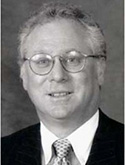 |
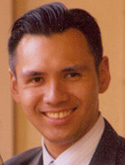 |
 |
 |
|
Bob Sonnenblick |
Noel |
Marty Pupil |
Jeff Rinkov |
 11:15 – 12:30
11:15 – 12:30
CONCURRENT THINK TANKS
T-3: Essentials to Meeting Lender Requirements
The discussion will focus on which lenders and mezzanine providers are the most active sources of capital in the hotel industry marketplace today and how you can expedite the loan application process by knowing what underwriters look for and the documentation that you should provide including historical rates and occupancy, property condition, standard reporting, operating statements, appraisal analysis, brand affiliation, and completed and planned upgrades.
MODERATOR:
Bob Sonnenblick, Chairman, Sonnenblick Development LLC
PANELISTS:
Peter Berk, President, PMZ Realty Capital LLC – Hotel Finance Group
Mark Laport, President & CEO, Concord Hospitality Enterprises Company
Barbara Morrison, President & CEO, TMC Financing
Mehul “Mike” Patel, CEO & Chairman, NewcrestImage
Christopher Williams, Vice President, Franchise Finance, GE Capital, Franchise Finance
Bob Sonnenblick to moderate the “Luxury Hotels & Resorts” panel at the Thinc Hotel Conference in Bali, Indonesia on Sept 5th at the Sofitel Bali Hotel.
| 4:10PM – 5:00 PM | Luxe in Flux: The Next Big Trends in Luxury Hotels and ResortsWhat lies ahead for this segment and is it a profitable business model to invest in? What are the popular and upcoming trends in in the Luxury hotel/resort segment?
|

 In Focus: Washington, DC
In Focus: Washington, DCIn one of the highlight sessions at the Tourism, Hotel Investment & Networking Conference (THINC) Indonesia 2014, Robert (Bob) Sonnenblick, Chairman – Sonnenblick Development, will lead a panel discussion comprising some of the most prominent players in the region’s Luxury Hotel and Resort segment. The session, titled ‘Luxe in Flux: The Next Big Trends in Luxury Hotels and Resorts’, will see this select panel of industry experts share their perspectives and knowledge of the market, discuss latest trends, and what lies ahead for this segment in the years to come.
 Justin Yang
Justin YangThe Beverly Hills hotel market, which boasts some of the highest room rates in the region but has not seen a new property built in nearly six years, is starting to heat up.
In what one city official conceded was an unusual overture, Pacific Palisades developer Sonnenblick Development has submitted an unsolicited proposal to build a 124-room luxury Auberge Resorts hotel on a 1.4 acre city-owned property at 9268 Third St.
The hotel, right in the backyard of another luxury hotel, L’Ermitage Beverly Hills, would be built on land leased from the city. The parcel now houses a small office building that has been the home of Lakeshore Entertainment since 2005.
In response to the proposal, the City Council directed staff to hold an informal public meeting last month to gauge public interest and advise the council on next steps.
While unsolicited proposals are not common, David Lightner, deputy city manager, said Beverly Hills had received expressions of interest recently for other city-owned properties, including a 5-acre site nearby on Foothill Road between Third and Alder streets.
“These proposals are not frequent,” Lightner said. “During the recession years, it was fairly unlikely. As the city emerged from recession starting from 2012, developers started looking at the (Lakeshore) site.”
Robert Sonnenblick, principal of the development firm, said in an email to the Business Journal that he was interested in the Lakeshore site because its quiet neighborhood can attract a high-end clientele, pointing to L’Ermitage’s success. He approached the city because it could give him a better deal than other privately owned sites in Beverly Hills. Land is scarce and difficult to find in the city.
“First, we really like the hotel market in Beverly Hills. It’s really strong and it has a great history,” he wrote. “Second, all of the other sites are being bid up to crazy prices by condo developers.”
That has residents wondering if the city is getting a good deal if it were to move forward with the hotel.
Marilyn Gallup, vice president of community group Beverly Hills Municipal League, said the city needs to determine a true value for the site before showing interest in projects like this.
“Looking at the renderings, it looked very nice. I’m not for it or against it,” Gallup said of the proposal. “First you have to put value on the land to know whether or not the city would be getting a good return. The city needs to decide what they want to do with the properties before you start looking at individual projects.”
That, said Lightner, is exactly what the city is doing.
“Is this the highest and best economic generator for the city? Are there other municipal functions? Are there other functions anticipated?” he asked. “That’s why the City Council said, ‘Let’s go talk to people and figure it out.’”
Healthy market
A recent report by PKF Consulting USA estimated that Beverly Hills had an average room rate of $414 and market occupancy rate of 77.3 percent last year.
Sonnenblick said a hotel on the site could generate as much as $2.5 million a year in transient occupancy taxes in addition to its payments on the ground lease.
Lightner said revenue generated by a hotel could be significant, but the city was still researching potential returns.
The last hotel to be built in Beverly Hills was the Montage, at 225 N. Canon Drive, which bowed in late 2008, and the prospect of another hotel in the city, whether an Auberge or another operator, remains preliminary. The Lakeshore site, just north of Burton Way and about four blocks west of the Four Seasons Hotel on Doheny Drive, would need to be rezoned to accommodate a hotel. Lightner said the property is zoned for parking, institutions and parks; rezoning the property would be a lengthy process requiring further studies and examinations of the site.
Lakeshore has a lease that runs for another year with an option for a five-year renewal. Lightner said the city could end that lease if the site were to be redeveloped.
Sonnenblick is not the only one to express interest in redeveloping the site as a hotel. Lightner said the owners of L’Ermitage, which fronts on Burton and backs on the Lakeshore site, has also expressed interest. A spokeswoman for L’Ermitage declined to comment.
Alan X. Reay of Irvine hospitality consultancy Atlas Hospitality Group said there is more than enough room for Beverly Hills to take on another hotel. He said the West L.A.-Beverly Hills hotel market is one of the nation’s best, second only to Manhattan.
“The L’Ermitage is 39 years old and it’s a nice building,” Reay said. “But with this proposal, you have this new product with a Beverly Hills address. There’s so much demand right now, the city could easily absorb a 124-room hotel. Ninety percent of the cities we deal with love the (transient occupancy taxes). It drives jobs and hotels.”
PANEL DISCUSSION:Boutique Hotel- Start to Finish
Moderator: Bob Sonnenblick, Chairman, Sonnenblick Development Panelists:

May 15, 2014 by Ian Ritter
Robert Sonnenblick, Chairman of Sonnenblick Development, has completed over $1.5B of commercial real estate transactions on the west coast. Among the most notable include: Beaudry Center, LA ($197M), The Ritz-Carlton Hotel, Pasadena ($97M), One Waterfront Plaza, Honolulu, HI ($100M) and the LA World Trade Center ($55M). He was also an original development partner of the $90M Loews Santa Monica Beach Hotel, which sold for $125M.
One commercial real estate sector that GRS Group hasn’t touched on recently in this space is hospitality. Bob Sonnenblick, chairman of Sonnenblick Development LLC, recently filled us in on the current hotel trends, and he had plenty of good news to share. Development is back, core markets are hot and fundamentals are in good shape. Sonnenblick shared what he thinks are the hotel sector’s bright spots.
We hear a lot about multifamily and its boom. What is going on with the hospitality sector right now?
There’s no question that the apartment industry is the darling of the real estate business right now. Every investor, pension fund or builder is actively looking for apartments. But as a result, there has been huge competition in the apartment sector, and it’s taken away most of the profitability of being in that sector. It’s become a very hard and competitive business now.
The exact opposite is the case in the hotel business, where there are very few hotel developers still standing as a result of the previous recession from 2008 to 2012, when most of them all got wiped out. It’s actually a very good time to be a hotel developer right now.
Most importantly, hotel operations are at an all time high this year. Tourism in Los Angeles County just broke a record for the largest dollar volume of tourism ever. The actual business side of our industry is very strong.
What kind of development is happening?
The limited-service hotels, the ones without food and beverage components, like Hilton Garden Inn, Hyatt Place and Courtyard by Marriott, the real select-services are on fire. Those are the ones that are getting built around the country right now. There is very little construction of full-service, high-rise, four-star and five-star hotels.
What is driving this?
It is a very simple concept. The profit margins on the rooms component of a hotel are very high. The profit margins on the food and beverage components are very low. So people are building hotels now with only rooms in them and nothing else. The customer is OK with that. They’ll take a nice room and walk across the street to a restaurant.
There’s clearly an increase in spending that’s happened over the last year. Operations and profitability are up about seven percent this year alone, which is a huge jump. But these select-service hotels are generally equivalent rooms to the full-service hotels, but they’re priced 30 percent lower. The customer loves it.
How is business travel holding up?
Business travel is back up to the levels we had seven years ago. That part is all really good, and next year it will be even higher. In general, the outlook for the hotel industry is a very strong future over the next two or three years with very limited new supply.
Are there any parts of the country doing particularly well?
There are two parts of the country that are very strong, and not surprisingly, it’s the two coasts. The New York-Washington D.C.-Boston market is unbelievably strong. The L.A.-San Francisco combo-market is very strong. The third market that is equally strong is Miami and South Florida. The coastal markets are having phenomenal years. The middle of the country is fairly flat.
Are there any hotel projects you have on tap that you’d like to highlight?
We’ve got two projects in California that we are very excited about. The first one is the building of a $75-million hotel on the campus of the University of Southern California Medical Center, surrounded by four hospitals and three medical schools. it’s a very exciting project for us. And we’re doing a 137-room hotel inside the new terminal at Sacramento International Airport. Any time you build a hotel attached to the airport terminal, it gives you a big leg up on getting really good occupancy.
We are also actively looking for more sites around Southern California that are located near and attached to major hospital projects.
Do you see anything derailing this momentum?
Unless it’s some kind of wild international act of terrorism, other than that, I really see us having a pretty good two-to-three-year run in front of us before you see interest rates start going back up.
– See more at: http://www.grs-global.com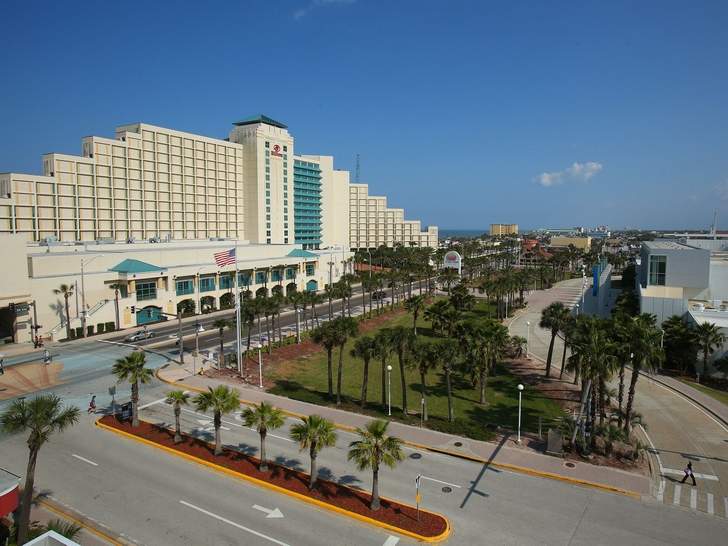
News-Journal/NIGEL COOK
The Hilton Daytona Beach Oceanfront Resort in Daytona Beach, Monday, April 28, 2014
For all the optimism over new hotels, renovations and national convention business, Daytona Beach’s tourism tide still largely rises and falls with the fortunes of its largest hotel, the Hilton Daytona Beach Oceanfront Resort.
The Hilton’s influence runs deep in area tourism, from daily room rates to investor decisions on future hotels, industry watchers say. The 744-room resort carries the baggage of a rocky past — ownership changes, mortgage defaults — and an uncertain present. But as with the rest of the beachside, recent events suggest a brighter future for the Hilton. (snipped)
‘CAUGHT IN THE DOWNTURN’
The Hilton’s most-recent appraised value is way down from a 2007 appraisal that pegged the hotel’s worth at $150 million, though observers doubt that appraisal’s validity.
The hotel’s appraised value has little effect on the day-to-day lives of Daytona Beach residents, observers say. The hotel will stay open, and tourists will continue to stay there.
But it does send a signal to hotel developers, said Bob Sonnenblick, chairman of Los Angeles-based real estate development firm Sonnenblick Development.
If you see an established hotel like the Hilton is only worth ($68,000) per room and it will cost you $200,000 per room to build a new hotel, you will look at that and think, ‘It makes no sense to build any new hotels in this market,’” he said.
Buying shuttered or under-performing hotels and renovating them would be more attractive to developers than building new because the costs are much lower, Sonnenblick added.
Still, the appraisal hasn’t turned off one developer who’s looking to build a brand-new hotel on the beachside.
Click to Read Full Article
Finding the best construction methodology is almost like deciding whether the beginning of the toilet paper should go above or below the roll. It’s all personal preference, so we asked what top market experts liked best at Bisnow’s Construction & Development Summit last week..
It varies by product and even within product type, we learned. Take multifamily mixed-use specialists Brian Winley of Century West Partners and Related California’s Gino Canori (flanking Sonnenblick Development’s Bob Sonnenblick and Panattoni’s Mark Payne). While Brian says GMP is his preferred method, Gino likes cost-plus. Bob notes the timing of when contracts are signed also is important—he signs his at 3% drawings (that’s industry lingo for 3% done… but you all knew that).
Could it be? At Bisnow’s Construction & Development Summit last week, some bold predictions were made about a traffic-free 10. Read on (and stick around for the also exciting topics of land prices and permitting).
Sonnenblick Development chairman Bob Sonnenblick says the day the Expo Line extension opens, the eastbound 10 Freeway, which becomes bumper-to-bumper at 2pm, will be a totally different place. He also says the dissolution of California’s redevelopment agencies probably cost the industry $4B; all the cities had major projects lined up with RDAs, he says.

He also says the dissolution of California’s redevelopment agencies probably cost the industry $4B; all the cities had major projects lined up with RDAs, he says.
Bob’s a big proponent of design-build because, if well documented, it takes all the construction risk off of the developer’s shoulders. He says development is already hard enough: “If you can take that risk and lay it off on your contractor, it’s got to be the right way to do this thing.” Andy notes Hensel Phelps is budgeting projects it first saw seven to nine years ago, though “they’ve traded who’s actually going to do ’em a couple times.”


More information:
Announcement Boutique Hotel Investment Conf Full Agenda
| 7:00 AM – 4:00 PM | Conference Registration |
| 7: 30 AM – 8: 30 AM | Networking Breakfast |
| 8:30 AM – 8:45 AM | Welcome:Frances Kiradjian,BLLA Founder & Chair with Program Overview Welcome:Dr.Robert J. Koenig, Associate Dean,NYIT |
| 8:45 AM – 9:00 AM | Robert Mandelbaum,PKF Hospitality Research |
| 9:00 AM – 9:15 AM | Jan Freitag, STR |
| 9:15 AM – 9:45 AM | Keynote Speaker:Horst Schulz,Chairman & CEO, Capella Hotel Group |
| 9:45 AM – 10:30 AM | PANEL DISCUSSION:Boutique Hotel- Start to Finish Moderator: Bob Sonnenblick, Chairman, Sonnenblick Development Panelists: John Bralower, President,Carlton Hospitality Group Karrle Drlnkhahn, Princpial The Getty’s Group Mark Gordon, Managing Partner, Tribeca Associates Daniel Lesser, President & CEO, LW Hospitality Advisors Jason Pomeranc,CEO,The Pomeranc Group |
APRIL 22, 2014
Square Feet
By JULIE CRESWELL
In hotels these days, it’s the haves versus the have-nots.
At some dining rooms, guests have to produce their room keys to eat at the
free breakfast buffet. No eggs and muffins for those staying in rooms with other
keys, even if the guests slept under the same roof.
At Chicago’s so-called triplex — where three hotel companies share space on
a city block — Starwood’s Aloft guests work out in a small gym within eyesight of
a much larger one shared by Marriott and Hyatt hotel guests.
“Starwood had an issue, they didn’t want their guests intermingling with the
other guests in the fitness area,” said Deno Yiankes, the head of investments and
development for White Lodging, which codeveloped and operates the Chicago
triplex. “Each brand has its own little hot button. Marriott and Hyatt said it
wasn’t a big deal, so they shared and got a bigger fitness center.”
Juggling those competing little hot buttons is one challenge developers face
as they put up more and more hotels housing two or more brands in the same
building.
Early this year, Marriott opened a hotel in Midtown Manhattan. The lower
half is a Courtyard by Marriott, the upper floors are the Residence Inn,
Marriott’s extended-stay brand. The Hyatt Hotels Corporation has two dualbranded
hotels and at least four more in the pipeline. Hilton, which already has
15 dual-branded hotels in North America, has 17 more approved or under
construction.
“It’s all the rage,” says Craig Mance, a senior vice president for development,
North America, at Hilton Worldwide. A hotel being remodeled on Chicago’s
Magnificent Mile will be split between its Hampton Inn brand while others will
belong to its Homewood Suites brand. Mixed together. On the same floor.
So even as hospitality corporations spend millions of dollars each year to
create distinct brands and experiences they hope will attract repeat customers,
the lines between brands are being blurred by the economics of higher land
prices.
Developers, trying to get the most out of high-priced downtown
metropolitan areas, are searching for ways to slash construction costs and get as
many rooms onto sites as possible.
That’s easier to do with two hotels that can share a pool, exercise room,
conference centers, laundry and kitchens. Those are all areas that take up space,
reducing the number of available rooms. The move reduces operating costs, too.
“There are huge efficiencies to be gained by making the little sandwiches and
putting them in the fridge at the limited-service hotel, running a bar at a
medium-service hotel, and a full bar and restaurant at another, all being run out
of the same kitchen,” said David Kessler, the national director of the commercial
real estate industry practice at CohnReznick, a consulting firm.
And although some hotel companies are embracing dual-branding, they are
struggling over how to maintain their separate identities and how to deal with
the awkward logistics that can arise, like free breakfasts for some hotel guests
but not others.
Brands become particularly wary when it comes to mixing hotels from
different corporations.
Chicago’s triplex opened just last year with three hoteliers sharing some
spaces, like laundry and meeting areas, but keeping other areas, like the gyms, as
well as entrances and lobbies, separate.
Others see more difficulties ahead.
“I think that project is crazy — like crazy bad,” argues Robert Sonnenblick, a
real estate developer who constructs hotels and resorts. “They put in hotels from three big reservations systems, all at the same price point, so that they’re all competing with each other on price. Consumers are going to rate-shop the three of them and choose the lowest one. It’s a race down to zero for the three competing hotels.”
A look at prices on the three corporations’ websites for a king-size bed at the
triplex on the same day in April showed they were within $10 of one another.
White Lodging argues that hotel prices for competing brands in urban
settings tend to be close, whether the hotels are on the same block or across the
street from one another. And executives at Hyatt say the experience has provided
a real-time measure of how they stack up against the competition.
“Once in a blue moon, you’ll see people from the neighboring hotel. But we
still call our lobby the gallery, and we have gallery hosts who will check you in
and pour you a glass of wine,” says Chris Walker, a vice president for Hyatt Place
and Hyatt House brands. “It’s paramount to us that we have control over the
lobby experience.”
Mr. Walker and others in the hotel industry say there are tensions and
continuing debate over what elements are important and make up the total
brand experience for the customer when considering combination developments.
“The purist in me says I don’t want to give up anything. For it to be the Hyatt
experience, it has to be 100 percent. But I’m also a realist and know that that
stance would dramatically eliminate a number of projects that the development
team could pursue,” Mr. Walker says.
Indeed, developers say this is the future.
Developers of the Arundel Mills property in Baltimore put in 150 Hilton
Garden Inn rooms and 100 extended-stay Homewood Suites.
“We got all of the efficiencies of running the property with single
housekeeping, one laundry, and amenities are also shared like the pool, fitness
center and guest laundry,” says David B. Pollin, a co-founder of the
Buccini/Pollin Group, which built and operates the site. “Plus, these two brands
attract two different types of travelers.”
If one brand is full, Mr. Pollin adds, the group has the option to “upgrade”
the traveler to the other.
But breakfast can be tricky. “The Hilton Garden Inn guests are very smart
and try to sneak in for the free breakfast available at the Homewood Suites,”
acknowledges Mr. Pollin, who says hotel staff members try to check guest keys.
Still, hospitality executives generally don’t expect many luxury properties to
jump into the mix because the guest expectations vary widely.
“If you’re used to getting misted at the pool, whether it’s a Waldorf or a Ritz,
and Mr. and Mrs. Smith with their 11 kids who are staying at the Hampton Inn
suddenly jump in, well, that’s not the kind of misting that they want,” says Mr.
Mance of Hilton. “I could see some conflicts arising out of that.”
A version of this article appears in print on April 23, 2014, on page B1 of the New York edition with the
headline: Hotel Brands Doubling Up in Cities Where Space Is Tight.
© 2014 The New York Times Company

November will be an especially busy month for Sonnenblick Development’s hospitality activities. Chairman Bob Sonnenblick (at the 7th Hole at Pebble Beach) tells us he’s just finishing design and has put financing down for a $75M Hyatt House on the campus of the USC Medical Center; groundbreaking is slated for Nov. 1. Also getting started that month: a $40M Hyatt Place in the new terminal building at Sacramento International Airport. He’s got other hotels in the works in Palm Springs and in Pinehurst, NC, where a $150M, 330-room Westin Hotel will boast two golf courses.
With 200 rooms and suites, and surrounded by four hospitals, the USC Hyatt House just east of Downtown will cater to patients and their family members. (As long as your continental breakfast is better than the hospital food, you’re on the right track.) In addition, Bob’s searching up and down the SoCal coast for waterfront hotel sites; but there isn’t much oceanfront left. He’s not deterred, though. He’s involved on projects on the waterfronts in Seattle and Palm Beach, Fla., and makes time to go up to Pebble Beach once a month to golf and get inspiration on the 17-Mile Drive. We hope you’ll join us for our LA Construction & Development Summit, April 24 at the JW Marriott at LA Live.
OPPORTUNITIES IN HOSPITALITY AND CONSTRUCTION IN MEZZANINE FINANCING
|
 David Spoont David SpoontPresident HAVERFORD CAPITAL MANAGEMENT, INC. |
 Michael Girimonti Michael GirimontiManaging Director, Debt Investments PEARLMARK REAL ESTATE PARTNERS |
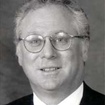 Bob Sonnenblick Bob SonnenblickChairman SONNENBLICK DEVELOPMENT |
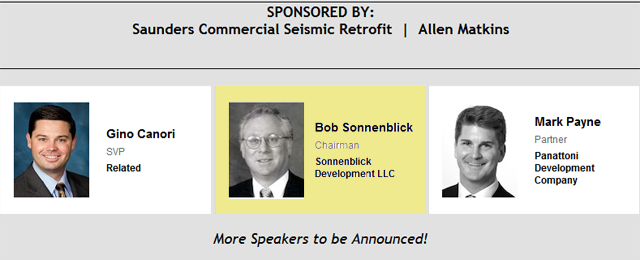
LA Construction & Development
| Boutique Hotel Investment Conference June 4 in New York City BLLA JOIN US as as a select group of experienced panelists and keynote speakers present their findings to attendees. You will walk away with a new network of individuals as well as knowledge about how to clearly navigate the murky (and exciting) waters of investing in boutique & lifestyle luxury properties.SPONSOR this conference to get your name in front of a database of over 100K!This conference Powered by BLLA, in cooperation with JF Capital Advisors.Click here to RSVP!What: BLLA 2nd Annual Boutique Hotel Investment ConferenceWhen: Conference runs 8am – 7:30 pm June 4th Where: Fees: |
Featured Speakers:
|
Event Summary
Boutique and lifestyle hotels are niche businesses that particularly cater to special types of customers. The boutique hotel segment of the hospitality industry is growing as global travelers spend more of their travel dollars on experiential travel.
Investing in boutique hotels is a great way for savvy executives to profit in the crowded hospitality marketplace. Opportunities for investment vary from starting your own boutique to renovating a struggling hotel to joining a partnership of investors. How one invests largely depends on opportunity and available capital.
This special sector of hospitality requires the developer to be prepared with facts, figures and an outstanding presentation for potential investors, lenders or equity partners.
This conference Powered by BLLA, in cooperation with JF Capital Advisors.
Click here to RSVP!
March 3, 2014
By Robert J. Vasilak
At Chambers Bay, will two Robert Trent Jones, Jr.-designed courses be better than one?
Bob Sonnenblick thinks so. The Los Angeles-based developer has proposed to build a clubhouse, a 220-room hotel, a conference center and a complementary 18-hole track at the municipal venue outside Tacoma, Washington. Unlike Chambers Bay’s existing course, Jones’ second track will welcome carts.
Sonnenblick has until mid June to line up financing, an issue that he doesn’t believe will be a problem. “There’s a lot of money around today for well-conceived, well-located, first-class projects,” he told the Tacoma News Tribune.
If Sonnenblick gets all his ducks in line, construction could begin next summer, after the U.S. Open is contested at the facility.

Posted: Tuesday, March 11, 2014 8:33 pm | Updated: 8:38 am, Wed Mar 12, 2014.
David Sinclair/Managing Editor
A potential $168 million development in the old service district on the outskirts of downtown Pinehurst has ties to some star power.
Blaine East, of Landcore, said in a presentation to the Village Council Tuesday night that they have brought in some “unique partners” for Village Place at Pinehurst, including a restaurant owned by Robert Irvine, who has a show on the Food Network, Justin Timberlake’s Southern Hospitality restaurant and a winery owned by Richard Childress of NASCAR fame.
He added that Irvine would also like to build a production studio next to the restaurant to tape programs for his show.
“We’ve taken this core and created this fantastic entertainment component,” East said.
It would also include upscale shops, microbrewery, cigar bar, small hotel, village market, offices and residential units.
Each of the restaurants will be flanked by retail businesses, which he said are “a driving factor” in the development.
East said the plans include a small “boutique” hotel that will not “interfere” with existing hotels in the village. The plan did not indicate how many rooms it would have.
“We are not talking about a large facility,” he told the council.
East said the Village Market grocery store would be similar to the Department Store in the downtown during the days when the Tufts family owned Pinehurst.
“This will be a great retail facility,” he said. “People can walk to it.”
East said the development would employee 450 people, and its businesses are projected to have gross sales of $63 million annually. He said it would generate $2.25 million in property taxes for the village and the county and about $6.1 million in sales tax revenues annually.
East said the development would have an “old town character.” He said it is not intended to hurt the restaurants and shops in the Village Center, but to enhance the entire area.
“We have a chance to grow our retail in the village,” he said.
Koontz added that they envision a lot of outdoor dining and people walking back and forth from the village center, as well as the nearby Pinehurst Arboretum and Rassie Wicker Park.
“We want this to become a great pedestrian plaza,” he said.
Koontz said the plan would also extend Rattlesnake Trail, which would be renamed Village Place Drive, through the development, providing better connectivity from the soon-to-be widened N.C. 211 into the Village Center.
“We felt we could provide something very exciting,” East said. “Our goal is to have a new destination.”
The buildings would be spread around the development to create open space. Residential units would be above the stores and offices.
Walkways and paths would connect to the Village Center and the nearby Pinehurst Arboretum and Rassie Wicker Park. There would be a trolley service, just like in the early days of Pinehurst.
East said the final plan for the development will be based on what the community wants and will support. Required meetings will be held to gather input from residents before a final plan is submitted to the village.
“We have a passion for this, to bring something truly great for the area,” he said.
The concept plans drew praise from council members and the public.
“You know I am a hard sell,” resident Jack Farrell said. “This is pretty exciting. This is the best A-1 plan I’ve ever seen for this area. I know the devil is in the detail.”
Farrell added, “I am looking forward to my tax reduction.”
Mark Lyczkowski, who lives at Pinehurst No. 6, said this will create a “destination” that would complement the existing downtown.
“Landcore has the funding in place to do this,” he said. “You have a great developer who can bring something great.”
Mayor Nancy Fiorillo said it is a “very interesting concept and beautiful design.” She said it must be a “community-centered” plan.
“We need to take a deep breath,” she said. “What will the community support? It will not happen overnight.”
East said the developers also plan to work closely with the merchants and business owners in the downtown in marketing the entire area. He said that will start with the Village Green and “expand outward.”
He said if the core village is vibrant, “it helps everyone. Let’s all roll up our selves and work together.”
Also during the meeting, the council voted unanimously to allow retirement communities on a case-by-case basis in the Office and Professional zoning district and to rezone five acres off Murdocksville Road behind Olmsted Village for a 56-unit apartment complex for people age 55 and older.
The council turned down a nearly identical request last April but voted earlier this year to reconsider the application after being threatened with a possible housing discrimination complaint.
Also, a majority of council members are not in favor of hiring attorneys to represent the Historic Preservation Commission (HPC) and the Board of Adjustment in the case of an appeal of an HPC decision last month to reject plans for a home on Everette Road. The Village Council hired attorneys for both boards when it appealed the HPC’s denial of plans to improve the Village Green.
Council member John Strickland brought up the matter, saying it was a matter of being fair to hire attorneys for the two boards.
Mayor Nancy Fiorillo said Village Attorney Mike Newman had contacted council members individually to ask about whether the village should pay for attorneys for the two boards. She said neither board has asked the council to provide an attorney and that Newman was trying to see how council members felt. No vote has been taken on the issue.
Contact David Sinclair at (910) 693-2462 or dsinclair@thepilot.com

The News Tribune March 4, 2014

This 2007 photo shows the Chambers Creek Properties site, including Chambers Bay golf course. A developer proposes to build a second course and a resort hotel on the site.
The online snipers are already weighing in on a $120 million proposal for a golf course and resort hotel/conference center at Chambers Bay. And they’re not happy. Not happy at all.
Yes, folks, let’s look this gift horse squarely in the mouth. After all, it’s not as if the developer – Bob Sonnenblick of Los Angeles – would foot the bill for the project.
Oh, wait a minute: He would.
“We put up 100 percent of the money,” he told The News Tribune’s Steve Maynard.
Repeat: He would pay for it. Not taxpayers, not sewer customers. All we’d have to do is enjoy the tourism revenue and sales tax money the project would generate – along with the jobs, of course. Can’t have that.
Sonnenblick Development – which has been involved in a number of high-end projects all over the country – is in very preliminary talks with Pierce County about a $120 million proposal for the Chambers Bay site in University Place. It has until mid-June to to come up with a project and financing plan. Even if it gets the green light, nothing would start happening until after the U.S. Open in June 2015.
So there’s no harm in seeing what Sonnenblick envisions for the site. At the very least, it would be exciting to see what a company with Sonnenblick’s impressive portfolio thinks is doable at Chambers Bay.
For their part, county officials have to ask whether the region could support another golf course – even one with an incredible view that golfers can get around on with carts, something they can’t do at Chambers Bay, a public links-style course owned by Pierce County. After four years, the course started making money only last year. The Sonnenblick project would be privately operated and would use the same course designer as Chambers Bay, Robert Trent Jones Jr.
Other questions: The public worked for months on the master site plan for Chambers Creek Properties, and it involved only one golf course. How would adding a second, 180-acre course affect the variety of public uses that were identified in the master planning process?
Would there be any impact on the hugely popular walking trail? Would a second course be any barrier to future national tournaments? And what would be the impacts of additional traffic on the surrounding community?
None of these questions necessarily suggests a deal-killer. In fact, it’s a luxury to have such an important proposal to ask questions about. It means private development is finally discovering the potential of the Chambers Creek Properties site.
Who knows whether the Sonnenblick proposal is the one that will materialize. Just the fact that the discussion is happening is a welcome one.
Read more here: http://www.bellinghamherald.com/2014/03/04/3508866/proposed-resort-could-be-a-tourist.html#storylink=cpy
Friday, February 28, 2014
By John Strege
Chambers Bay in University Place, Wash., which will host the U.S. Open in 2015, is not for everyone, given its difficulty quotient and the fact it’s a a walking-only course. But is a more accommodating second course in its future?
A Los Angeles development company, Sonnenblick Development, has entered into a preliminary agreement with Pierce County, which owns Chambers Bay, to build a 220-room hotel there, according to the News Tribune, which also reported that a second 18-hole golf course is included in the agreement.
Robert Trent Jones II, who designed the Chambers Bay course, said it is premature to reach any conclusion. “We’re doing a study on behalf of [Sonnenblick Development],” Jones said from Chambers Bay on Friday. “He [Robert Sonnenblick] has an opportunity to build a hotel there and he would like to see more golf.
“But the whole thing is up in the air. There may or may not be [a golf course], but it won’t be anything like Chambers Bay. It would be more like a family course.”
The question is whether there is enough room on the Chambers Creek property to the south of the existing course to accommodate another course. Jones suggested that in the event there isn’t enough room that a nine-hole course with different sets of tees that would allow it to be played like an 18-hole course is an option.
“There’s a whole resort golfer community who won’t play [Chambers Bay] right now because they don’t walk 18 holes,” Sonnenblick told the News Tribune.
A hotel has long been planned for the site, but a previous developer was unable to secure financing and the project was put off until after the U.S. Open.
Read Original Article
A Los Angeles developer is contemplating building a 220-room hotel and a new golf course at Chambers Bay in University Place, site of the 2015 U.S. Open.
Pierce County is working with a Los Angeles developer, Sonnenblick Development, to build a 220-room hotel and another 18-hole golf course at Chambers Bay in University Place.
The News Tribune in Tacoma reports Pierce County is giving Sonnenblick until mid-June to come up with its project and financing plan. Construction on the $120 million project would not start until after the 2015 U.S. Open in June.
Sonnenblick officials said the second course is important because it would allow golf carts to be used. Chambers Bay currently doesn’t allow carts to be used.
This isn’t the first time a hotel development has been planned for Chambers Bay. As reported earlier this week in the Puget Sound Business Journal, plans for a hotel were included in the original plans for the course, which opened in 2008.
By Steve Maynard
Tacoma News TribuneFebruary 27, 2014
Read more here: http://www.thenewstribune.com/2014/02/27/3070502/los-angeles-developer-has-big.html#storylink=cpy

An overview of Chambers Bay Golf Links in University Place, February 26, 2014.
PETER HALEY – Staff photographer: The News Tribune
A California hotel developer is formulating plans to build a 220-room hotel and a second 18-hole golf course at Chambers Bay in University Place.
Pierce County has entered into a preliminary agreement with Sonnenblick Development, giving the firm until mid-June to develop its project and financing plans.
If a formal deal is reached after that, construction would not start until after the U.S. Open at Chambers Bay golf course in June 2015.
It’s the third attempt to get a project off the ground at the county-owned property and the first attempt since 2010, when another developer failed to secure financing.
A resort hotel was part of the 2010 plan as well. But building a second golf course is a new addition.
Besides the hotel, Los Angeles developer Bob Sonnenblick said he wants to build another 18-hole golf course where, unlike the Chambers Bay course, golfers could ride carts. Chambers Bay prohibits carts to prevent damage to fescue grass on the links-style course.
Sonnenblick said adding a second golf course is crucial to attracting more golfers to the hotel he would build.
“There’s a whole resort golfer community who won’t play this course right now … because they don’t walk 18 holes,” Sonnenblick said in an interview with The News Tribune.
Sonnenblick said the third part of the project is a retail and restaurant pavilion near the waterfront, potentially with kayaking and sailing. But it won’t be included in the initial design.
His firm has hired Robert Trent Jones Jr.’s company to design the second golf course. Jones designed the original Chambers Bay course.
An architect is planning a three- to four-story hotel — with conference and banquet space and a golf clubhouse — that would sit at the top of the property overlooking Chambers Bay.
Sonnenblick, who is chairman of Sonnenblick Development, estimated the entire project would cost about $120 million. A championship golf course, about 7,000 yards in length, would take up 180 acres. The hotel would sit on another 15 acres.
Deputy County Executive Kevin Phelps said the county hasn’t calculated how many of the 930 acres at Chambers Creek Properties could still be developed. The Chambers Bay course takes up 300 acres. Other areas such as setbacks, buffers and land to expand the Chambers Creek Regional Wastewater Treatment Plant are off limits to development.
“The hotel’s no problem whatsoever,” Phelps said. “The real issue is, can they fit in the golf course and maintain all the open space and amenities that we expect to have at Chambers Creek Properties?”
Phelps said the county “is diligent in that we still want to have open space, recreation, trails and off-leash areas.”
“Those are musts,” he said. “They are not options.”
Sonnenblick said there’s “plenty of room” for the entire project.
He and the county would have to reach an agreement on plans for the project and a lease before construction could start.
“We put up 100 percent of the money,” Sonnenblick said.
Either party can back out of the first step — a one-year, pre-development memo of understanding — without any cost to the county.
“We lose nothing by seeing what they have to put on the table,” County Executive Pat McCarthy told County Council members this week.
The county can’t negotiate with other developers for Chambers Bay while the agreement is in place. Phelps said another party likely would enter into the same type of agreement if Sonnenblick and the county decide to part ways.
Council Chairman Dan Roach said the council first learned of the agreement from McCarthy on Feb. 19, after she had signed it on Feb. 14.
Roach said he’s hopeful development at Chambers Bay will occur, providing tourism and sales tax dollars to help pay for the county-owned golf course.
The course made money last year, said county spokesman Hunter George. It lost money in the four previous years, requiring an interfund loan to make debt payments.
Both the County Council and University Place City Council would have to approve changes to the master plan for Chambers Creek Properties, which doesn’t include a second golf course, said University Place City Attorney Steve Victor.
Victor said the project — which would require permits from the city — would be a “great amenity” for University Place.
“But it’s a big project and an expensive project,” Victor said. “And as we’ve all seen, not every idea that is investigated comes to pass. From my perspective, it’s wait and see.”
Sonnenblick said he expects to acquire financing.
“We are in a totally different real estate financing market today versus six years ago,” he said Wednesday while sipping an Arnold Palmer in the Chambers Bay grill. “There’s a lot of money around today for well-conceived, well-located, first-class projects.”
Sonnenblick said his company acquires bank financing and does business with a dozen state pension funds that become equity partners for projects.
Phelps said Sonnenblick’s company has a “tremendous track record” of developing major projects in Los Angeles and elsewhere.
Sonnenblick said his firm is developing its first golf course — with a 335-room Westin Hotel — adjacent to Pinehurst Resort in North Carolina, where this year’s U.S. Open will be played in June on Pinehurst No. 2. It also was an investor in a golf course in Boca Raton, Fla.
He said his company is developing six hotels over the next two years totalling $500 million, about half of which are financed.
Golf aside, Sonnenblick said he expects the Chambers Bay location overlooking Puget Sound will be a big draw.
When hotel guests look out at the view of the water, he said, “they’re going to love this.”
Steve Maynard: 253-597-8647 steve.maynard@thenewstribune.com @TNTstevemaynard
Read more here: http://www.thenewstribune.com/2014/02/27/3070502/los-angeles-developer-has-big.html#storylink=cpy
By Victoria Talbot
The City of Beverly Hills held a public meeting Wednesday to share information on a proposed luxury hotel development on City owned property located between Foothill Road and Maple Drive on Third Street.
Sonnenblick development would like to redevelop 1.4 acres to build a 124-room Auberge Resort Hotel.
An existing building on the site has been home to Lakeshore Entertainment since 2005. The tenant has “several years” remaining on their lease with an option to renew.
The public meeting was a preliminary discussion to evaluate the public’s interests and concerns and discover if there are other preferences for development of the City’s property.
Deputy City Manager David Lightner explained that this was not the usual process for development. Instead, in a very preliminary way, the City Council directed staff to “start the process with a general community meeting to present the idea of a luxury hotel and get the reaction.” About 35 people were in attendance. “Others have expressed interest, L’Ermitage and the Peninsula, in a luxury hotel,” he said.
Asked about the current tenants, Lightner said: “If there is a proposal for a complete redevelopment of the site the City can give notice and provide an exit.”
Developer Bob Sonnenblick explained that the success of L’Ermitage, “interested us in the neighborhood.” The concept is a very high-end luxury boutique hotel. The average daily rates are $790 at Auberge Resorts’ properties in the Napa Valley, Calistoga Ranch, Aspen, and Cabo San Lucas with guests spending an average of $3,200 during their stays.
The Sonnenblick family decided on Auberge Resorts after extensive research. Hotel rooms would be a minimum of 770- square feet. Some will include a private second floor patio and Jacuzzi. The hotel would not exceed 45-feet in height and feature a pool, courtyard, restaurant and bar, with a small spa designed to service hotel guests.
“The gross will go up and the rent will also grow,” said Sonnenblick, explaining that the City would share in the hotel’s success. The rent would be in addition to the 14-percent TOT tax. He calculated the TOT would generate $2.5 million per year in City revenues. The current lease is about $1 million a year. Sonnenblick said the lease would revert back to the City in 55 years.
Residents expressed concern that the parcel represents one of the few undeveloped parcels in the City.
“Long-term leases should be the citizen’s decision. They should vote on this,” said resident Marilyn Gallup.
“I am concerned we are being guided down a path, ” said one person, citing repeated references to the “highest and best use of the land.”
“Is this the best bang for our dollar,” asked another. “Is there something else out there that would be better if we were looking for an investment? Is revenue the most important thing?” asked another.
“The City has looked at these properties and doesn’t have a specific plan,” responded Lightner, stating that the property was zoned for parks, institutions and parking. Redevelopment of this kind would require a zoning change. He reiterated that the meeting represented the most preliminary discussions about the property.

January 17, 2014
Major hotel brands are banging down the doors to get into the SoCal market, according to development experts at our recent SoCal Hospitality Summit. (Even hotel execs can barely wait for 3pm check-in.) According to CFO Julie Shiflett, Red Lion is looking to add 20 hotels over the next 12 months to its existing 55 West Coast properties. She says major hotel brands are willing to give hotel developers sliver equity to get into a strong market (80%-plus occupancy).
Principal and COO Jay Newman says The Athens Group is redeveloping the Miramar Hotel at Wilshire and Ocean Avenue in Santa Monica and is working with Marriott to bring Edition to the old Scandia site on Sunset Boulevard. His company developed The Montage Beverly Hills, our event site. (Since Jay was our host, we resisted stealing the robes.)

Sonnenblick Development chairman Bob Sonnenblick has six hotel projects in various stages of development across the US, ranging from select-service to full-service resorts. The top submarkets are on the waterfront, but there’s only a couple development parcels available on the beachfront from Ventura County down to San Diego, he says.
According to our moderator, Arent Fox partner Rich Brand, the first thing we know about hospitality is that nobody has ever bought a hotel that they thought was well-managed. The second thing? They always want to find that untapped market.
Julie says hotels that weren’t able to meet the PIP standards and lost their flag over the recession likely will need redevelopment to enter another brand. Jay cites aggressive labor unions and referendums sponsored by competitors among impediments to building new hotels.
 Bob says one market that scares him is Downtown LA, where a huge number of rooms are coming online. With the cost of new construction, even the select-service deals are $400k/key.
Bob says one market that scares him is Downtown LA, where a huge number of rooms are coming online. With the cost of new construction, even the select-service deals are $400k/key.
January 13 2014
A recent study found a hotel’s green certification does not translate into increased revenue.

The 200-room Muse Hotel in New York reports a positive impact on bottom line due to going green. (Photo: Kimpton Hotels)
By Alicia Hoisington
Copy Editor / Reporter
ahoisington@hotelnewsnow.com
REPORT FROM THE U.S.—The verdict is still unclear whether going green puts green back into hoteliers’ pockets, according to sources.
A recent study, “Hotel sustainability: Financial analysis shines a cautious green light,” found, on average, booking revenue neither increased nor decreased for eco-certified hotels. The study analyzed millions of individual bookings in more than 3,000 certified hotels, with a comparison group of 6,000 non-certified properties.
“Earning a green certification does not automatically result in a large revenue bump nor a revenue fall. In short, green is not a ‘silver bullet’ strategy,” the report stated.
“In this study, we just wanted to look at if putting a green leaf on Travelocity as an indicator of whether it’s sustainable or not, will that change the market performance. So that part we saw was neutral,” said Rohit Verma, professor at the Cornell University School of Hotel Administration and an author of the study.
“We have another related study. … We have property-level cost data—cost for various types of energy usage, utilities and other things. And what we found in that study is that the hotels which are more sustainable are more productive in the sense that they are using better use of their resources than the hotels which are less sustainable,” he said.
Verma said if both studies are merged, the results show on the revenue side there is no difference between sustainable hotels and non-sustainable hotels. However, on the cost side, sustainable hotels have an advantage.
Cost, ROI of green
Ericka Nelson, GM of the 200-room Muse Hotel in New York, which is in Kimpton Hotels & Restaurant Group’s collection, sees an impact on bottom line when it comes to her hotel’s eco-certification.
“We find that today’s traveler is more aware and committed to eco-friendly travel, feeling a personal responsibility to lessen their carbon footprint,” she wrote in an email. “As a result, we do find that this affects our bookings in a positive way. … Our leisure guests consistently tell us that one of the reasons they stay with us is because of our eco-friendly practices.”
She said, as with any aspect of business, the eco-friendly products and practices must align with costs as well as demonstrate a return on investment.
“Fortunately, green products and initiatives have matured so much that many of these practices have saved us money,” Nelson said. “By investing in energy-saving measures over the years, for example, we have reduced our energy bills as well as our impact on the environment.”
She said occupancy for 2013 ended at 90.28% with an average daily rate of $329.
Bob Sonnenblick, principal of Sonnenblick Development LLC, doesn’t see the value in green hotels.
“If you had two identical hotels on a corner, and one of the hotels is green … and the other one isn’t, and I said to you, ‘Over the course of a year do you think that one hotel would do better making more money than the other?’ The green hotel will not make more money,” he said.
He said a green hotel is not able to charge a rate premium for having green characteristics. Likewise, if customers won’t pay for green, the concept will turn into a fad, lasting one or two years before it disappears from the industry, he said.
“We are developing six new hotels across the country, so we look into things as to whether or not they will be revenue-generating,” Sonnenblick said. “The bottom line is we’re not implementing any of those green characteristics in any of the six hotels because we found that we’re not going to make money off of it.
“Until there’s such a thing as profitability attached to it, I think you’re going to see across the entire industry people will talk about it; people will look at it, but in the end they will not implement,” he added.
But Nelson said hoteliers need to think about the guest experience.
“Green awareness is becoming more and more mainstream, and hoteliers must consider consumer demand,” she said.
She said there is an expectation that hotels will implement conservation initiatives behind the scenes that will reduce guests’ environmental impact without having any effect on the guest experience.
“Becoming a certified green hotel assures guests that you practice what you preach and that the hotel is up-to-date on the latest conservation methods,” Nelson added. “In this way, guests will keep returning to your property because they are confident in your commitment to green business practices.”
The green umbrella
Eric Ricaurte, principal of Greenview, a sustainability consultancy for the hospitality industry, said people tend to use the word “green” as an all-encompassing term. He said within the hotel industry there is so much segmentation—from business to leisure guests, to luxury to economy hotels, and so on.
“But when it comes to green, we suddenly forget everything else we’re talking about and just talk about one encompassing guest for one encompassing hotel. And that’s the biggest mistake—treating us as though we’re all the same,” he said.
He said it’s more important to look at what guests really care about. For instance, if guests are health-conscious they might want healthy food-and-beverage or in-room wellness options. Hoteliers should think similarly when it comes to green.
“You have to look at the different psychographics of the traveler. So that’s the biggest issue here that needs much further exploration—the psychographics, market segmentation, location segmentation,” he said.
Ricaurte believes green research should be expanded. “I would say there should be more studies on customer segmentation, with specific preferences, not just green ideas.”
The hotel room mini-bar may become an endangered species, but who cares? We need big bottles to celebrate the return of hotel development. Experts at Bisnow’s SoCal Hospitality Summit say we’ll see sticks coming out of the ground this year and into 2015.
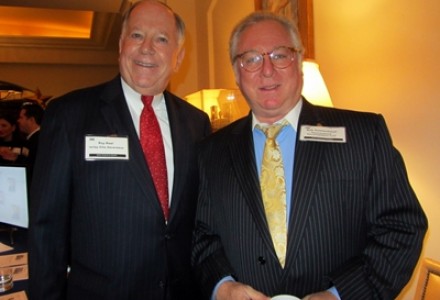
Before the program, we snapped Harley Ellis Devereaux’s Roy Reel with Sonnenblick Development chairman Bob Sonnenblick. Find out about Bob’s latest projects and those of others in coverage of our second panel next week.
Published: Saturday, December 7, 2013 at 8:08 p.m.
Last Modified: Sunday, December 8, 2013 at 10:07 p.m.
DAYTONA BEACH — With new hotels poised to give the beachside what some observers call a long-overdue refresh, what could possibly go wrong?

Well, there’s this: The law of supply and demand comes into play in a big way, and the prospect of new hotel rooms and meeting space holds both the promise of better times and concern about too much too soon.
Major hotel renovation and construction projects — including the proposed Hard Rock Hotel and two-tower Protogroup Inc. hotel-and-condominium complex — are set to add about 1,310 hotel rooms to the area’s 12,000-room-strong inventory in 2015 and 2016.
Though fresh rooms and new attractions that include the $400 million “Daytona Rising” renovation of Daytona International Speedway and the proposed One Daytona entertainment/retail development across the street will undoubtedly draw more overnight visitors in 2016, some hoteliers doubt those projects alone will be enough to keep the new hotels full of guests.
And they worry about what will happen to their properties — in terms of occupancy and room-rental rates — if the new hotels stand only partly full come 2016.
“The demand is not growing at the pace the supply is,” said Manoj Bhoola, president of Elite Hospitality, a company that operates two beachside Ormond Beach hotels and two hotels near the Speedway in Daytona Beach. “It will be harder for those of us who haven’t been foreclosed on or (gone) bankrupt to compete.”
Tourism officials and hoteliers say the key to keeping the new hotels filled is to aggressively market them to lure vacation bookings and secure group business long before the properties’ ribbon-cuttings.
“It’s a good thing if we’re adding branded, quality locations,” said Jason Reader, general manager of the 744-room Hilton Daytona Beach Oceanfront Resort, the Volusia-Flagler area’s largest hotel. “That being said, if you add this new supply and you don’t do anything about creating demand, that’s not a good thing.”
The Daytona Beach area tourism industry has been growing. Hotels, vacation rental properties and campgrounds in the region generated $5.9 million in bed-tax revenues in fiscal year 2013, which ran from Oct. 1 to Sept. 30. That’s about 5 percent more than fiscal 2012, when the county collected around $5.6 million.
Other measurements indicate growth, as well. Average occupancy at Daytona Beach area hotels rose to 56 percent in 2012 — up from 53 percent the year before and in line with the area’s 20-year trend — and average room rental rates increased by $6.45 over that period to $105.28 in 2012.
To be sure, operators of the incoming hotels will promote their products — and, by extension, Daytona Beach — vigorously. But, industry watchers say more is needed, and growth needs to ramp up by 2016 to prevent the new hotels from doing little more than competing for customers who were going to visit the area anyway.
“If we’re not scared about 2016, we need to be really scared,” said David Rijos, general manager of The Shores Resort & Spa in Daytona Beach Shores, at a meeting of the Volusia County Tourist Development Council in October.
Rijos serves on the council, which advises the Volusia County Council on tourism issues.
Adding 1,310 hotel rooms — nearly 11 percent of what’s already available — in one year has all the makings of an overbuilt market, said Bob Sonnenblick, chairman of Los Angeles-based real estate finance and development company Sonnenblick Development.
“That’s a huge number for a market like Daytona — a huge red flag,” he said, adding that a growth rate of 1 to 2 percent per year is normal.
“You will see room rates drop by 30 percent overnight, and occupancy will drop (significantly)” as demand struggles to keep up with the surge of new rooms, he said.
Local industry watchers are planning for the crush of new rooms.
The Ocean Center, the Volusia County-run beachside convention center in Daytona Beach, should figure prominently in bringing more people to the area, Rijos said.
In 2009, the convention center completed an $82 million renovation and expansion. Recently, it played host to a series of large events that brought thousands of visitors to the area. Those included the Promise Keepers Christian men’s conference in October, which brought more than 4,000 people to the area, and Living Proof Live with evangelist Beth Moore, a Christian seminar that brought more than 8,000 visitors to Daytona Beach in November.
“The Ocean Center isn’t a silver bullet, but it certainly is our best bullet,” Rijos told the tourist development council.
Keeping the Ocean Center booked with events that fill hundreds of hotel rooms will require an effort that improves upon current bookings. The Ocean Center and Halifax Area Advertising Authority — the taxpayer-funded organizations tasked with bringing conventions to the area — spent the better part of the last year and a half at odds as to how to accomplish that, with parties from both sides accusing the other side of undermining their efforts.
The two organizations recently defined their roles, with the Ocean Center’s sales team focusing exclusively on booking that building and the ad authority working to bring conference business to area hotels and meeting spaces, such as Daytona International Speedway.
Additionally, the ad authority’s board in August voted to divert $400,000 of its budget to bring business to the Ocean Center. The convention facility used the money to hire new salespeople and establish an incentive fund to attract new events.
The changes should prevent the Ocean Center and ad authority from stepping on each others’ toes, said Don Poor, the convention center’s director.
“We can both focus on our own areas,” he said. “We can concentrate on convention business that fits the Ocean Center, and the (ad authority) can focus on … promoting the area.”
According to Ocean Center records, the convention center hosted 18 events estimated to use three or more hotels and at least 1,000 hotel rooms on their peak nights in the 2013 fiscal year, which ended Sept. 30. That’s a drop from fiscal 2012, when it hosted 21 such events, and slightly higher than fiscal 2007 — before the renovation — when it hosted 17 major events. The Ocean Center has 23 large events booked for fiscal 2014, according to the report.
The Ocean Center isn’t the only convention space on the beach. Hotels with meeting areas dot State Road A1A, as well.
In fact, the 200,000-square-foot Ocean Center stands across the street from the Hilton Daytona Beach Oceanfront resort, which itself packs 60,000 square feet of meeting space.
And the supply is only going to grow.
The Hard Rock Hotel is expected to add 40,000 square feet of meeting space when it opens, while the Protogroup development will bring in another 15,100. Meanwhile, just up S.R. A1A from the Protogroup site, the recently sold Desert Inn will open with 25,000 to 30,000 feet of meeting space after the hotel’s new owners finish renovating the property in late-2015.
Because they’re smaller, hotels don’t have the means to play host to the kind of large events the Ocean Center does. However, business from meetings at the hotels and from sporting and other events held in the area are an important source of revenue, especially during the slow winter tourism months, said Jeffrey Hentz, executive director of the Halifax Area Advertising Authority.
Many groups book their trips and meetings two to five years out, which means the clock is ticking for the new hotels.
“If we’re not making sure the hotels are filled at a price point we want, we have to put heads in beds, even if we have to deeply discount,” Hentz said. “In general, if you don’t get the group business, you’re going to get it with (individual guests and families), and that’s very competitive and very expensive.”
If the new hotels don’t have booked group business when they open, they’ll have to fill the rest of their rooms somehow. And that could be very bad for the destination, Hentz said.
“They’ll all be going after the same business the other hotels are going after,” he said. “That will start a price war.”
To prevent this, the new hotels need to start booking as soon as possible.
“They have to start the day they start moving dirt,” Hentz said, adding their sales teams also need to accompany ad authority staff to trade shows and other events.
That’s the plan, said Ken Berthiaume, regional director of sales for Summit Hospitality Group, the company that bought the Desert Inn.
“Once we break ground, I’ll start pre-selling,” he said.
Summit intends to close the Desert Inn in late-2014 for renovations. The company hopes to re-open the hotel under a major hotel brand in 2015.
Protogroup plans to begin marketing its hotel rooms about a year before its 2016 opening, said attorney Rob Merrell, who represents the company locally.
Though the new hotels could cause growing pains, observers say they are nonetheless needed to make Daytona Beach competitive with other destinations.
For years, the area has been losing tourists to counties like St. Johns and Seminole in large part because Daytona Beach’s selection of hotels is old and in need of major updates, said Mark Soskin, an economist with the University of Central Florida.
“The main thing keeping people from staying here was the low, low, low quality (of available hotel rooms),” Soskin said. “They didn’t consider those rooms as acceptable at any price.”
Henry Wolfond, chairman of Bayshore Capital, the Toronto company that is developing the Hard Rock, agrees that newer hotels are needed. When they’re built, they’ll work in tandem with the renovated Speedway and its restaurants and shops to encourage vacationers to take a second look at Daytona Beach, he said.
“New and remodeled hotel rooms will command a higher rate and attract tourists who are looking to stay in fresher accommodations and perhaps experience Daytona Beach for the first time,” he said. “If you look at how other areas in Florida, including South Beach and Sunny Isles in Miami, have transformed over the past two or three decades, you truly get a sense of what is possible.”
Also, industry watchers say the new branded properties will help sell the destination to professional meeting planners and vacationers looking to earn customer loyalty points with the hotel companies.
“The more flagged hotels we open up, the greater level of success we’re going to have in raising our rate structures and bringing in more customers that are loyal to those brands,” Hentz said.
Libby Gallant, general manager of Perry’s Ocean Edge Resort in Daytona Beach Shores, said she shares concerns about the incoming supply, but wouldn’t stop it from happening even if she could.
“We’re going to have to find that new leisure guest,” she said. “(They) are the bulk of our business, and we’re going to have to reach them to fill the new rooms coming in.”
December is known for one holiday in particular. It’s of course Repeal Day, Dec. 5, when Prohibition ended. But we’d like to add another big date. Bisnow’s SoCal Hospitality Summit. Our annual hotel check-up is Dec. 19 at the Montage Beverly Hills. This week, we spoke with two of our experts. Drinks weren’t served… but we could’ve if we wanted to.

Sonnenblick Development chairman Bob Sonnenblick (looking festive at the Marina Del Rey boat parade) has two hotel projects funded and soon to get underway in California. He’s breaking ground in Q2 on the USC Hyatt House, a $75M, 200-key hotel on the USC Medical Center campus, next door to the County-USC hospital.
Bob tells us families of patients will be able to easily walk across the street. He’s also building a $40M Hyatt Place hotel inside the new terminal at Sacramento International Airport. And Bob’s got other projects in the hopper, including a 330-room Loews in Cathedral City on Highway 111 and a 335-room resort on 400 acres he bought in Pinehurst, NC. He’s actively looking for land for additional hotels, especially waterfront-oriented sites in the LA area.
Financing is plentiful for nearly all kinds of hotel deals, including acquisitions, refinancings and even new development, said speakers on a NAHIC panel.
By Ed Watkins
Editor-at-Large
ewatkins@hotelnewsnow.com
CHICAGO—While it’s a great time to be a borrower in the hotel industry, the market hasn’t become overheated … at least not yet, said speakers last week during a general session panel titled “Who’s got money” at the North America Hotel Investment Conference.
The panelists agreed financing is plentiful, especially for hotel acquisitions and refinancing, and even for new development. Rates and terms are also favorable.
“There’s more money in the market today than at any time in the last 30 years,” said Robert Sonnenblick, chairman and principal of Sonnenblick Development LLC. “There’s lots of competition among lenders to make deals.”
Sonnenblick, whose firm has six hotel development projects underway, said in the past 30 days he’s received construction loan commitments for two of the hotels. Five lenders bid on the senior construction loans, and six or seven firms tendered offers for preferred equity, he said.
Supply and demand dynamics and generally favorable hotel industry performance are fueling the interest from the lending community.
“(Loan-to-value ratios) are being pushed up to 75% in some cases because of where we are in the (industry’s) cycle,” said Scott Kaniewski, senior VP of HREC Investment Advisors. “Values are still appreciating and lenders are trying to build or protect market share, so they’re more aggressive in their underwriting. There’s lots and lots of competition, which allows borrowers to get some good deals.”
The panelists insisted that despite the liquidity in the market, the environment is not yet “frothy,” or in danger of overheating, as it did in the mid-2000s.
“I still see very diligent underwriting,” said Jeffrey Bucaro, senior VP of Aries Capital. “People are only lending on cash flows. Projections mean nothing, but they’re going back multiple years to see how the assets have performed.”
Pricing and terms
Bucaro said debt yields are compressing from 11% earlier this year to approximately 10.25% for many deals. LTVs are creeping upward.
“Not too long ago, LTVs were often 69% because no one wanted a ‘7’ in front of the number,” he said. “Now 72% to 74% are common. All things considered we’re in a good spot, not frothy.”
Michael G. Medzigian, chairman and managing partner of Watermark Capital Partners, outlined some of the loan pricing and terms he’s encountered in the marketplace in recent months. Medzigian’s companies have purchased 11 hotels so far in 2013 with several more closings anticipated before the end of the year, he said.
Medzigian said he’s able to secure debt at 50% to 60% LTV, including provisions for capital expenditures, with maturities between five and 10 years. Often, the loans are interest-only from 18 months to the full term of the loans. Amortization following the interest-only period is typically 25 to 30 years.
Medzigian said interest rates have crept up by about 25 basis points since May and are typically at about 4.25%, or up to 50 basis points higher, depending on the type of asset.
William G. Sipple, executive managing director of HVS Capital Corp., said bridge loan financing is available for as low as 6% interest to as high as 7% or 8%. Pricing for mezzanine loans ranges from 10% to 12%.
He said some loan originators are accommodating borrowers in other ways than rate and terms. He said his firm has arranged deals with limited or no cash management requirements.
Markets and segments
The panelists agreed the financing landscape changes by market and segment. They said different metrics are used for deals in hot markets such as New York and San Francisco.
“For whatever reason, and I can’t explain it, our industry has become unbelievably New York-centric,” Sonnenblick said. “New York has something like 9,000 new rooms (in the pipeline) so you would think if there was one city to shy away from, it would be New York, but all the standard underwriting rules don’t apply there.”
Kaniewski believes San Francisco is a strong market because of an upturn in commercial development and high barriers to entry for new hotel projects.
“In both cities you’re seeing a lot of inflows of capital from Europe and Asia, because investors from those regions view the (United States) as safe,” he said.
In general, there are five markets in the U.S. that attract the majority of financing, Medzigian said. He said while a deal in one of these cities will attract between 15 and 20 debt quotes, that number is cut in half in the next tier of markets.
He said his deal focus is on the areas of economic growth in the country, which are the two coasts and the Sunbelt.
“A map of our assets looks like a smiley face because that’s where you’ll see the growth,” he said.
Other panelists said product segmentation is just as important as market location in finding favorable financing.
In secondary and tertiary markets, Kaniewski said there is plenty of money for select-service hotels with flags from one of the primary franchise companies.
“Once you move into full service in those markets, financing can be more of an issue. There are options, but it’s a thinner market than there is for select service,” he said.
Financing is most difficult to obtain for the resort segment, especially for new development, said the speakers.
“Other than a gaming deal, I don’t think there has been a construction loan made on a major resort in the U.S. in the last year,” said Sonnenblick.
– See more at: http://www.hotelnewsnow.com/Article/12730/Lending-pace-is-strong-but-not-frothy#sthash.WxVHwAFJ.dpuf
Thursday, December 19, 2013 The Montage Beverly Hills
SPONSORED BY:
Arent Fox | CBRE | Pircher, Nichols & Meeks
 |
 |
 |
|
Bob Sonnenblick
|
Jay Newman |
Mark Wiesenthal |
Our 3rd Annual Southern California Hospitality event brings together top industry players to tackle some of the toughest questions in the industry. Join us for insight into investment in Southern California hotel properties; how the fundamentals are looking and what’s driving them; what we have learned from challenges in the recent year; where industry leaders are finding opportunities; and how are deals getting done. We look forward to seeing you there!
Thursday, December 19, 2013
The Montage Beverly Hills
(Marquesa Ballroom, Lobby Level)
225 North Canon Drive
Beverly Hills, CA 90210

8-9 AM Continental Breakfast & Networking
9-10:30 AM All-Star Panelists
10:30-11 AM Post-Panel Networking
 While it’s a great time to be a borrower in the hotel industry, the market hasn’t become overheated … at least not yet, said panelists last week during a general session at the North America Hotel Investment Conference.
While it’s a great time to be a borrower in the hotel industry, the market hasn’t become overheated … at least not yet, said panelists last week during a general session at the North America Hotel Investment Conference.
HNN’s Ed Watkins reported from the conference that financing is plentiful, especially for hotel acquisitions and refinancing, and even for new development. Rates and terms are also favorable.
“There’s more money in the market today than at any time in the last 30 years,” said Robert Sonnenblick, chairman and principal of Sonnenblick Development LLC. “There’s lots of competition among lenders to make deals.”
– See more at: http://www.hotelnewsnow.com/article/12732#sthash.MrtK4LeX.dpuf
Take a finance deep-dive and learn from the top investment minds in the industry. CEO’s and Presidents from leading hotel companies will discuss relevant topics, from equity sources to alternative financing and renovation budget management. For a full educational program, view the conference agenda.
Conference Venue:
Sheraton New York Times Square HotelIMN Real Estate Conferences is please to announce that Mr Robert Sonnenblick, Chairman of Sonnenblick Development LLC, has been added to the speaker list at its upcoming Real Estate and Mezzanine Financing Conference to be held in New York City on November 18, 2013.
Mr Sonnenblick will be speaking on the topic of:
A Borrower’s Perspective on Today’s Real Estate Lending Market
| 4:00PM Track B: | Portfolio Lenders Vs. Non-Traditional Lenders Vs. CMBS & Conduit Loan Financing – Convergence Among Lenders? The Borrowers’ Perspective |
As competition for good deals and credit worthy borrowers continues to heat up, are lenders originating loans that are outside of their core product lines? Are commercial banks originating loans customarily associated with alternative lenders? Are B note buyers looking to get into CMBS origination? What are insurance companies doing to remain competitive? Are there new players coming to market looking to originate loan products across the spectrum? Are lenders more willing to follow their clients across state borders and do deals in new markets? Is the convergence among lenders here to stay?
Panelists:
Robert Deckey, CIO, GEORGE COMFORT & SONS [ BIO ]
Adam Altman, Partner, KABR REAL ESTATE INVESTMENT PARTNERS
Arvind Bajaj, Managing Director, MADISON MARQUETTE [ BIO ]
Kyle Allan Morque, Vice President, Finance, MOINIAN GROUP
Bob Sonnenblick, Chairman, SONNENBLICK DEVELOPMENT, LLC [ BIO ]
|
|
|
IHIF Summit-Series Conferences is pleased to announce the addition of Mr Robert
Sonnenblick, Chairman of Sonnenblick Development LLC, to its speaker list at the
upcoming North America Hotel Investment Conference in Chicago on Nov. 22. 2013.
Mr Sonnenblick will be joining the Hotel Finance panel.
A Look Back
Launched in 2010 as the Distressed Hotel Summit, the North America Hotel Investment Conference has since evolved into the North American anchor of the International Hotel Investment Forum (IHIF) Summit Series. Presented by Hotel Management, the IHIF Summit Series produces premier, world-class investment conferences that focus on growth and financing opportunities for the hotel industry.
Since inception, NATHIC has delivered a timely service, focusing on the issues pertinent to current hospitality investment professionals. NATHIC concluded its fourth annual event in Washington, D.C. Nov. 28-29, 2012. Anthony Melchiorri, star of Travel Channel’s hit show, Hotel Impossible and President and Founder of the New York-based consulting company Argeo Hospitality, was the keynote speaker, and answered audience questions in a session moderated by Mike Cahill, Chief Executive Officer of Hospitality Real Estate Counselors (HREC).
Justifying add-on fees to guests
20 Aug 2013
Hoteliers who add extra fees and surcharges to guests’ bills need to communicate the rationale for the practice and provide value for the extra charges, sources said.

REPORT FROM THE U.S.—Hoteliers who add fees and surcharges to guests’ bills need to communicate why they do so and what value customers receive from the extra charges, sources said.
“Transparency is critical, especially with the younger generations of travelers, who expect everything to be transparent,” said Henry H. Harteveldt, travel industry analyst with consulting firm Hudson Crossing. “Their friends share everything through social media and they expect companies to be completely open to them. Their mindset is if you’re going to charge me for something you need to let me know what it is for and what value it represents and you need to tell me upfront.”
According to new research, this year hoteliers in the United States will collect $2.1 billion in fees and surcharges from guests. That’s up from $2 billion in 2012, a 6% increase, and nearly double from the $1.2 billion collected in 2000. The research is conducted annually by Bjorn Hanson, divisional dean of the Preston Robert Tisch Center for Hospitality, Tourism and Sports Management at New York University.
The total includes items such as resort fees, early cancellation fees, telephone surcharges, minibar re-stocking fees, in-room safe charges, automatic gratuities and charges for high-speed Internet access.
Hanson said in recent years hoteliers have become more effective in communicating fees and surcharges by placing tent cards in guestrooms, including information in guest directories, requiring guests to initial a form at check-in or simply “placing a collar on a bottle of water with the price on it.”
“As a result, there is less of a sense that fees and surcharges are an ambush to get more revenues from guests,” Hanson said. “(These fees) have become more well-known. It doesn’t mean guests like them, but they’ve become used to them.”
He said the intense media attention as airlines ratcheted up their fee schedules has made it easier for hoteliers to adopt the practice.
“The fact that airlines started implementing what can be viewed as more-aggressive fees and surcharges has heightened awareness of (the practice) but also almost made it a common travel standard, making it a little bit easier for hotels to implement fees and surcharges,” he said.
Hotel marketing consultant Brenda Fields said it’s important for hoteliers to provide fair value for fees they charge or risk a backlash from guests.
“The key for hoteliers is to get it right,” Fields said in an email. “That is, charging appropriately, without gouging. Offer a product or service that works, and communicate it to the guest. Negativity can be overcome or minimized when there is a better understanding.”
The best approach, Harteveldt said, is for hoteliers to explain to guests how bundling the fees gives them better value than paying for services on an a la carte basis.
He said some guests will accept some fees when they feel they’re “paying for a product that provides some kind of added value, whether it’s improving the quality of the stay or its efficiency.”
Resort fees and charges for Internet service are the most controversial hotel fees, Harteveldt said.
“Resort fees are simply ridiculous because they are indirect rate hikes,” he said. “Consumers generally don’t like them, but especially when the property isn’t even a resort.”
Guest responses to resort fees fall into several categories, Hanson said. Some might not like extra fees but they understand it’s become an industry practice, especially at resorts.
“Some guests actually like the resort fee because for them it’s better than paying separately for a pool chair, towel or an umbrella or to receive faxes,” he said. “And, of course, there are those who say, ‘I don’t want any of those services yet I’m being asked to pay for them.’”
Robert Sonnenblick, president of Sonnenblick Development, is especially vocal in his criticism of resort fees, calling them “a highly deceptive practice.” He said he would never add a resort fee to any of the hotels he owns.
“My biggest problem is not the concept of resort fees; it is the concept of involuntary resort fees, and there is a distinction between the two,” Sonnenblick said. “When you call to reserve a room, you ask for a room rate and if they then add on a mandatory $20 fee, the $150 room rate they told you on the phone becomes $170, which means they lied to you.”
Even the perception of extra fees can upset some guests, said Birgit Radin, managing director of the DoubleTree Magnificent Mile and The Inn of Chicago, and a Hotel News Now columnist.
“It depends on how you define fees and surcharges,” she said. “Some customers perceive an Internet connection charge as a fee; they perceive not including breakfast in the rate as a fee. They see it as a nickel and diming.”
She said because many guests are accustomed to free Internet service and free breakfast when they stay at limited-service hotels, they don’t want to pay for these things when they stay at full-service properties.
At one time, energy surcharges were another source of many guest complaints. In the early 2000s, some hotel companies and properties instituted these charges to offset rising utility costs. Facing consumer complaints and possible legal actions, hoteliers gradually dropped the unpopular add-on fee, and Hanson doesn’t believe they’ll be back.
“It’s highly unlikely, unless there is some extraordinary spike in energy costs,” he said. “It’s a very sensitive issue. It would be very unpopular unless it could be justified by a significant jump in energy costs, but even then when there is a surcharge of $5 (per night) guests are wise enough to know it doesn’t cost that for the energy they use in their guestrooms.”

Press Release: (New York, NY). August, 2013.
Los Angeles-based real estate financier and developer Robert Sonnenblick, chairman
of Sonnenblick Development LLC, has been chosen by IMN Conferences Inc. to speak at
their upcoming Real Estate CFO Forum in NYC on September 30th.
The conference will be held at the Downtown Marriott Hotel on West Street.
Mr Sonnenblick will be headlining the 12 noon panel on “Financing and Capital Raising
for Real Estate Projects”.
Conference Venue:
Marriott New York Downtown
85 West Street
New York, NY 10006
Phone: 877-513-6305 or 800-266-9432
Website: http://www.marriott.com/hotels/travel/nycws-new-york-marriott-downtown
12:00 Capital Raising Techniques & Financing
[ Submit Session Question(s) ]
Health of the commercial real estate market * Finding available sources of financing * Raising third party capital * Alternative capital raising strategies * Markets for funds of various sizes * Fund structure * Co-investment opportunities * Marketing and strategy * Raising funds outside of the United States * Regulation, compliance and oversight * Reporting, governance & transparency
Moderator:
Steven M. Moore, Managing Director, Real Estate Advisory Group, KPMG CORPORATE FINANCE LLC [ BIO ]
Panelists:
Jason Tighe, VP Regional Finance Director, AREA PROPERTY PARTNERS [ BIO ]
Austin Khan, Chief Investment Officer, LAURUS CORPORATION
Frank Falbo, Partner, MAYER BROWN LLP [ BIO ]
Bob Sonnenblick, Chairman, SONNENBLICK DEVELOPMENT, LLC [ BIO ]
 |
Moore |
 |
Sonnenblick |
 |
Falbo |
PRESS RELEASE: Santa Monica, Calif.
Bob Sonnenblick, Chairman of Los Angeles-based Sonnenblick Development LLC has
been chosen by IMN Conferences Inc to moderate the “Debt-to-Equity” panel at their
upcoming Real Estate Finance Conference to be held September 9th at the Fairmont Hotel
in Santa Monica. The panel begins at 12 noon. See: http://www.imn.org/real-estate/
| 12:15 Dequity Plays: The Equity Player & Why You Would Go Debt? |
• Seller financing • Buying debt • Cost of capital implications • Recap opportunities • What is the goal of acquiring the note? • Cost of debt • Funds: Did you have to run this by your investors? Why/Why not?When is an equity player a debt player? When there is $$ to be made is the easy answer but it is more involved than attacking the death star. This session will be the Yoda to your young Skywalker discussing some of the more detailed reasons that equity players turn to the force know as the dark side of debt investing.
 Session Chair:
Session Chair:
Bob Sonnenblick, Chairman, SONNENBLICK DEVELOPMENT, LLC
[ BIO ]
 Panel Participants:
Panel Participants:
Andrew Brian Brog, President, BROG PROPERTIES [ BIO ]
Leslie Lundin, Managing Partner, LBG REALTY ADVISORS, LLC [ BIO ]
John Warful, President, METROPOLITAN PACIFIC CAPITAL
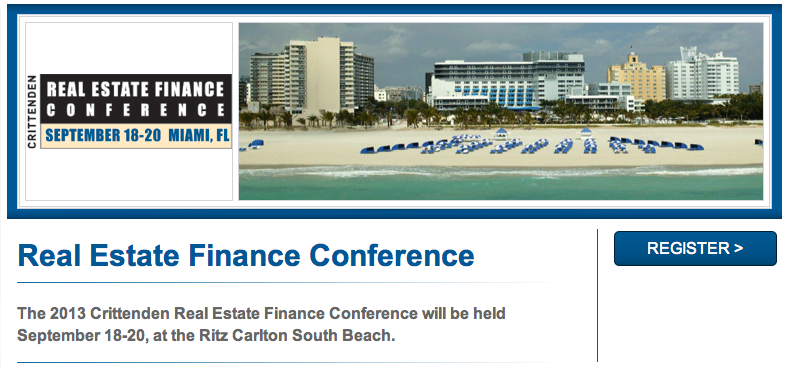
Sept 2013 #502 – Hotel Development & Finance
Thursday, September 19, 2013 | The Ritz Carlton South Beach – See more at: Click Schedule of Events
3:45pm – 4:45pm #502 – Hotel Development & Finance
Moderator: Robert Sonnenblick – Sonnenblick Development LLC
Daniel Palmier – UC Funding
John Bralower – The Carlton Group
Max Comess – HFF
Ezra Katz – Aztec Group
– See more at: Click Schedule of Events

Most people know that Sonnenblick Development is focusing on hotel development. But before that, chairman Bob Sonnenblick (with Peaches, the company’s director of strategic planning and adorable snouts) specialized in development of government-tenanted build-to-suit office buildings like Norwalk Government Center. The ownership entity, Sonnenblick-Del Rio Norwalk LLC, just signed a 60k SF full-floor lease with Accenture LLP. The international consulting firm is moving from El Segundo under an 11-year lease valued over $12M. (Asked what she likes to see on the top of buildings, Peaches said “Green Ruff.”)
The 464k SF building sits on 22 acres at 12440 Imperial Hwy in Norwalk. The Accenture deal brings it to 95% leased. Norwalk Government Center is the LA HQ for the Department of Homeland Security, and other tenants include The County of LA, State of California, and FBI. (At this office, thanks to background checks, everyone figures out their Secret Santa in no more than eight seconds.) Studley’s Liron Nelik and Laurie Condon repped the tenant, while CBRE’s John Biven and Melissa Garcia repped the building.
Only one more shopping day until tomorrow. Send your story ideas to julie@bisnow.com.
9:30 am — 10:30 am BLOSSOM BALLROOM
PROVING PROJECT FEASIBILITY
This session discusses how to analyze the market and determine the direct competition and provides the details of what goes into a Market & Economic Feasibility Study. A Panel of Experts with experience in commissioning market and feasibility studies as well as those who write them discuss why this MUST be your first step – even before closing on your site or hotel.
Moderator: Bob Sonnenblick; Chairman, Sonnenblick Development LLC
Panelists:
Larry Broughton; CEO, BroughtonHOTELS
John Arnett; Strategic Advisory, Warnick + Company
Bruce Baltin, Sr. Vice President, PKF
Afshin Kateb; CFO, SBE/SLS Hotels
Dan Flannery; COO, Morgans Hotel Group
BLLA’s 2nd Annual International Boutique Lifestyle Hospitality Leadership Symposium is scheduled for October 21-23, 2013 in Los Angeles. To ATTEND, EXHIBIT or SPONSOR go directly to the event website at: www.boutiqueleadershipconference.com.
|
|
|
Developers vying for shot at old City Hall land
Newport City Council expected to vote on one of three proposals — two hotel projects and a mixed-use residential development.

Sonnenblick Development proposed a 148-room high-end luxury hotel, with 15 townhouse suites and 12 free-standing villas. The hotel would also include underground parking, along with other amenities. (Courtesy Sonnenblick Development / Daily Pilot / July 5, 2013)
By Jill Cowan
http://www.dailypilot.com/news/tn-dpt-me-0706-city-hall-reuse-20130703,0,7623946.story
July 5, 2013 | 8:08 p.m.
The morning was chilly, the marine layer still firmly blanketing the Balboa Peninsula.
“This is Ground Zero for what people think about as Newport Beach,” said longtime resident and developer Bob Olson.
The grounds of Newport Beach’s now-vacant former City Hall didn’t look like much. A remote religious shrine tucked in the wilds of Thailand might have had more visitors at that moment.
But Olson, looking at what for decades had served as the city’s civic core, along Newport Boulevard, saw a unique 130-room hotel, complete with a spa, rooftop bar and upscale dining options, built in a style that would pay tribute to the community’s nautical history.
On Tuesday, from the still glitteringly new confines of a much different City Hall near Newport Center, the Newport Beach City Council will consider whether to accept a staff recommendation and move forward with Olson’s vision or choose one of two other proposals for the 4.3-acre site. At the 7 p.m. meeting, the public will also have one more chance to weigh in on the matter.
The Shopoff Group, which is also working with the city on the planned Uptown Newport development near John Wayne Airport, proposed a mixed-use residential development, with 99 units renting for an average of about $5,058 per month. The proposal also includes underground parking, along with a public plaza and 15,000 square feet of commercial space.
Sonnenblick Development proposed a luxury hotel, but at a higher price point than the one proposed by Olson’s firm, RD Olson Development. Sonnenblick’s proposed 148 rooms would go for an average daily rate of $371, versus Olson’s $279. The proposed Sonnenblick hotel, which would include about a dozen each of townhouse suites and free-standing villas, would also have a spa and rooftop bar, as well as underground parking.
According to the report, the RD Olson proposal fit best with the city’s vision of the surrounding Lido Village, architecturally and in terms of public access. Furthermore, while both hotels were projected to better stimulate activity in the area than homes, concerns about the viability of the Sonnenblick hotel because of its high price point meant the RD Olson proposal won out with staff on an economic level.
Residents and officials hope that whichever project is chosen, it will revitalize Lido Village, which has languished with vacant storefronts and little tourist traffic.
Olson said that if the Lido House Hotel — the name his firm proposed — were built, guests would spend money eating out at nearby restaurants before biking to the Balboa Fun Zone, and Newport residents would grab coffee at the hotel’s coffee shop or enjoy a night out at the hotel’s bar.
He pointed out a row of sleepy storefronts along 32nd Street.
“Guests will be coming here to experience Newport Beach, and we encourage our guests to come out and explore this area,” he said. “Let’s say your family owns this building, so they say, ‘Let’s fix it up, now that we’ve got some economic activity.'”
Although the vast majority of community members who’ve spoken on the matter have echoed that logic, pushing for a hotel over residential units, Bill Shopoff, principal of the Shopoff Group, said he saw unanswered questions in the hotel proposals, particularly with regard to bed tax projections.
According to the city’s staff report, which culled information from the companies’ respective proposals, the RD Olson hotel would generate about $1.13 million per year in tax revenue for the city and pay about $420,000 per year to the city in rent, for a total approaching $1.55 million.
All three proposals involve a 99-year lease. Other details would be negotiated with the chosen company.
The Sonnenblick hotel, similarly, was projected to generate for the city significantly more in tax revenue in a typical year, $1.59 million, than it would from its lease, which would generate about $600,000 in a year, for a total of $2.19 million.
The Shopoff complex, on the other hand, is projected to generate $230,000 in taxes during a year, while its lease is projected to generate $1.01 million in a year.
But Shopoff cautioned that the transient occupancy tax projections might be optimistic, given the many economic factors that could affect a hotel — not to mention the long planning and development process, which will require Coastal Commission input.
“I think our economics are comparable to or superior to the economics of a hotel,” Shopoff said. “If the hotel were going to be built today, I’d be more certain, but that market changes more rapidly. I don’t think the project will begin construction for several more years.”
At various public meetings about the site’s redevelopment, including an April study session on the proposals, questions about parking have arisen.
Both Shopoff and Sonnenblick proposed underground parking, though according to the staff report, building the garages would require extensive excavation, shoring and, probably, “dewatering,” because the site is so close to the ocean.
Nevertheless, Sonnenblick questioned whether the estimated 145 surface parking spots proposed by RD Olson would be enough.
“The largest difference in the proposals is that our project includes underground parking,” said Bob Sonnenblick, the firm’s principal. “And theirs, Olson’s, assumes no on-site parking at all.”
He added, “The other difference is that we’re really proposing a five-star luxury hotel … and previously the Olson group has built Courtyard by Marriott-type projects.
“The difference between those two levels of hotel quality will lead to a fairly substantial difference in hotel taxes received by the city over the course of the next 30 years.”
But Neil MacFarlane, longtime Lido Isle resident and former president of the Lido Isle Community Assn., and others have said they trust RD Olson to build a hotel and run it at viable rates.
“We think [Olson] will actually build a hotel,” he said. “He’s here to stay and he’ll operate it successfully.”
In any case, the development could be the city’s best — and last — shot at reviving Lido Village, said Hugh Helm, who spoke on behalf of the association over coffee at the Woody’s Diner just across Finley Avenue from the site.
“We’ve got our chance to do this right,” he said. “If not, we’re gonna have to live with it for a long time.”
Jill.cowan@latimes.com
Twitter: @jillcowan
Side-by-side:
RD Olson Development
Development type: Boutique hotel
Rooms: 130
Projected cost: $46.6 million
Operator: Destination Hotels & Resorts
Room rates: $279 per night on average
Public plaza and pedestrian paths: 0.68 acres
Parking: 145 spaces, surface only
Building height: Four stories and a tower at 58 feet, 5 inches
Sonnenblick Development
Development type: Boutique hotel
Rooms: 148
Projected cost: $81.8 million
Operator: Auberge Resorts
Room rates: $379 per night on average
Public plaza and pedestrian paths: 1.3 acres
Parking: 210 spaces, underground garage
Building height: Four stories at 55 feet, with a tower at 65 feet.
Shopoff Group
Units: 99
Projected cost: $61.3 million
Operator: Riverstone Property Management
Rent: $5,058 per month on average
Public plaza and pedestrian paths: 1.2 acres
Parking: 325 spaces, underground garage
Building Height: Four stories at 55 feet.

To green or not to green? That was the question and a heated topic at the recent Bisnow Lodging Investment Summit. So we polled our readers to see what you really think about sustainability and if it matters in the hotel industry.
The majority says that guests are not willing to spend more to stay in a sustainable hotel.
 Scoffed one respondent: “I like having clean sheets and towels—the cleaner and fresher, the better.” Another replied that it’s more about cleanliness, comfort, noise, decor, bedbugs, odor, and the attitude of staff. Instead of bamboo sheets and recycled notepaper, they want courteous service and working TVs.
Scoffed one respondent: “I like having clean sheets and towels—the cleaner and fresher, the better.” Another replied that it’s more about cleanliness, comfort, noise, decor, bedbugs, odor, and the attitude of staff. Instead of bamboo sheets and recycled notepaper, they want courteous service and working TVs.
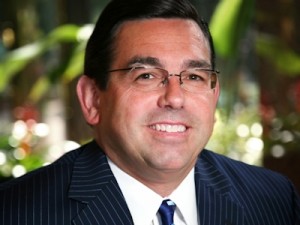 Concord Hospitality Enterprises prez of architecture and design Tim Osiecki (which began building LEED in 2008 with Pittsburgh’s Settler’s Ridge Courtyard by Marriott) says the mere mention “causes a reflexive reach for wallets amidst protestations about ROI and guests who don’t care, don’t understand, and won’t pay for it.” (This coming from the same guests who pay $8 for coffee.) While Settler’s Ridge cost over $500k more to build, he said the annual savings exceeded the firm’s expectations. Today, the same custom LEED design would come in at less than $350k. Concord worked in tandem with Marriott to provide the design template for a LEED prototype; using it means developers can expedite the LEED design process, saving time and money.
Concord Hospitality Enterprises prez of architecture and design Tim Osiecki (which began building LEED in 2008 with Pittsburgh’s Settler’s Ridge Courtyard by Marriott) says the mere mention “causes a reflexive reach for wallets amidst protestations about ROI and guests who don’t care, don’t understand, and won’t pay for it.” (This coming from the same guests who pay $8 for coffee.) While Settler’s Ridge cost over $500k more to build, he said the annual savings exceeded the firm’s expectations. Today, the same custom LEED design would come in at less than $350k. Concord worked in tandem with Marriott to provide the design template for a LEED prototype; using it means developers can expedite the LEED design process, saving time and money.
Here’s an idea of how Tim says Concord has been able to monetize sustainability. The firm now has a mandate to build all LEED, with $2M invested so far and another 18 hotels in its pipeline either under construction or in design, including the 182-room, $47M Cambria Suites in DC, a 196-room, $80M Cambria Suites in Midtown Manhattan, and a 258-room, $80M Hyatt House in Jersey City.
Sonnenblick Development chairman Bob Sonnenblick is one developer not on board, a position people have booed him for, so he’s glad others agree. It’s not financially feasible, he argues—people often stay at hotels to relax, not pay more money for a shower that’s lower flow than the one at home. One respondent said, “It’s gone overboard… now they pay $200 or more a night and can’t get a decent stream of water.” Bob called sustainable hotels a trend that won’t have a long shelf life—two to three years max. One owner of a LEED-certified, select-service hotel responded, “the guest is only interested in the green notes in their own pockets… we’ve found clearly that the guest is not willing to pay anything more to stay in a LEED hotel.”
 Does it matter if guests are on board? The previously quoted owner-operator is still keen on sustainability “as it’s efficient to operate and therefore is a reasonable investment.” Another respondent says avoiding waste in laundry and toiletries lowers operating costs, too. (So stop stealing soap, everybody!) Kimpton is one brand well known for sustainability. In addition to its LEED Gold Hotel Palomar and LEED-certified Hotel Monaco (both in Philly), all of its hotels are Green Key certified. It uses non-toxic cleaners; serves organic and shade-grown coffee; offers special rate codes that give back to The Nature Conservancy and The Trust For Public Land; and has free or discounted parking for guests with hybrid or electric vehicles.
Does it matter if guests are on board? The previously quoted owner-operator is still keen on sustainability “as it’s efficient to operate and therefore is a reasonable investment.” Another respondent says avoiding waste in laundry and toiletries lowers operating costs, too. (So stop stealing soap, everybody!) Kimpton is one brand well known for sustainability. In addition to its LEED Gold Hotel Palomar and LEED-certified Hotel Monaco (both in Philly), all of its hotels are Green Key certified. It uses non-toxic cleaners; serves organic and shade-grown coffee; offers special rate codes that give back to The Nature Conservancy and The Trust For Public Land; and has free or discounted parking for guests with hybrid or electric vehicles.
You may remember we wrote about “The Mountain” being purchased in Utah by Summit, whose founder, Elliott Bisnow, helped start our publication, and whose business partner, Ryan Begelman, is our new Bisnow Media CEO. (Complicated, we know.) Anyway, here’s a cool story about it from Tuesday’s Morning Edition show on NPR.
Go to Biz Now and Vote: 1) Is collecting resort fees a dirty practice?
Bob Sonnenblick isn’t only vocal about sustainability. Here’s a practice that he calls “dirty” and “unconscionable”—resort fees, or mandatory daily surcharges imposed by hotels to cover the costs of certain amenities, like Internet access and pool (even if you don’t use them). The fees often aren’t disclosed in booking prices, leading to an unexpected, much more expensive hotel stay. He says he’d like to petition lawmakers to make the practice illegal. Do you agree, or are resort fees important for the hospitality biz? Tell us by clicking the survey above.
What’s your favorite part about staying in a hotel? Tell amanda@bisnow.com.

DAYTONA BEACH — Bringing big hotel and retail developments to the beachfront used to take a big taxpayer investment.
And that money was supposed to accomplish big goals: revive the beachside, attract tourists with more money to burn and draw conventions to the Ocean Center.
Those goals are still there today — as big as ever — but one thing has gotten smaller: the amount of taxpayer money hotel developers are asking for.
“(Hotel developers) are able to come in and make their numbers work without having to talk about 10, 20 or 30 million in public subsidies,” said Daytona Beach Deputy City Manager Paul McKitrick.
From the mid-1980s through the early 2000s, the city and county dished out more than $35 million in community redevelopment money — $50 million-plus in inflation-adjusted dollars — to help build and expand what is now the Hilton Daytona Beach Oceanfront Resort and the Ocean Walk retail, time-share and condo-hotel complex.
Fast-forward to today, and the purse strings are tighter, with the city offering less — many millions less — to the beachfront’s two newest proposed developments, the Hard Rock Hotel and the 300-500-room convention hotel-and-condo complex backed by Russian investors, though local and national observers note the companies could seek more help as construction gets under way.
So, what changed over the past quarter century?
“It was a different time (in the 1980s), both with respect to the economy and the beachside,” said attorney Rob Merrell, who represents the Protogroup, a Russian company that is building the $150 million two-tower complex on the beachfront where State Road A1A meets Oakridge Boulevard. “It was truly a war zone (on the beachside), and the blight was rampant.”
In the mid-1980s, when the city OK’d the first of the roughly $15 million that would go toward the Daytona Beach Marriott — now the Hilton — the beachside was seedy, its hotels were dated and the Boardwalk was a magnet for unsavory characters.
“It was in every way a blighted area,” McKitrick said, adding that the city then was more willing than it is now to build with public funds in the absence of private investment.
Despite the city shelling out for the Marriott — which went into bankruptcy in 1994 and was rebranded as an Adam’s Mark — and the county spending $39 million to build the Ocean Center, the beachside fell into a similar situation in the late-1990s.
Again, the city dipped into community redevelopment area (CRA) funds — this time to the tune of about $19 million — to help build the Ocean Walk Shoppes and its accompanying time-share and condo-hotel complex.
The city later refinanced the bonds used to pay for the Hilton and Ocean Walk projects, taking on $37.7 million in debt initially, to be paid back by 2031.
Today, the Hard Rock developers and Protogroup — for now, at least — are only looking for a fraction of that, enough to improve the surrounding infrastructure and landscaping to support the developments.
Though the city is still eager to attract another convention hotel — in part to complement the Ocean Center, which completed an $82 million renovation in 2009 — and it still wants to revitalize the beachside, McKitrick said it’s looking to spend less in CRA funds.
“Hopefully, everybody is more realistic about what the role of tax money should be,” said City Commissioner Pam Woods. “We should always remember that it is the market that should drive what happens.”
And thanks to market changes, building on the beachfront makes sense today even with less government support, said Henry Wolfond, chairman and CEO of Bayshore Capital Inc., the Toronto company that is developing the 250-room Hard Rock Hotel south of Sun Splash Park on State Road A1A.
“The opportunity to acquire property at fair prices in the past few years contributes to the viability of moving forward with less incentive from local governments than in the days when Hilton and Ocean Walk were built,” Wolfond said.
A state tourism industry that has recently been on the rebound and the existence of the old taxpayer-funded developments — the Ocean Center, Ocean Walk and Hilton — don’t hurt, either, he said.
Rather than asking for money to help build portions of the Hard Rock hotel, condominium and restaurant complex itself, Bayshore is negotiating with city officials to get help upgrading infrastructure so it can support the new facility, said attorney Glenn Storch, who represents the company locally.
Storch wouldn’t disclose how much the company is seeking, but said it would be substantially less than the amount that went to the Hilton and Ocean Walk.
“If not for these incentives, (the Hard Rock) would not be built,” he said.
Similarly, the city so far has only offered to reimburse Protogroup’s impact fees and separately reimburse the company up to $450,000 with CRA money to fix up the Oakridge Boulevard beach approach, which the firm’s hotel-and-condominium complex will straddle, with improvements like lights, landscaping and signage.
DeLand attorney Mark Watts, who represents Protogroup, estimates the company will save about $1 million from the fee reimbursements.
“These are public improvements,” said Reed Berger, the city’s redevelopment director. “We’re not building someone’s building for them.”
More than simple economic changes are keeping a lid on taxpayer aid to the new hotels, at least for now. The projects themselves are different from the Hilton and Ocean Walk and, consequently, aren’t eligible for as much help, city officials and developer representatives say.
The Protogroup project and the Hard Rock will be built in community redevelopment areas, special taxing districts created by the county to revitalize neighborhoods it deems blighted.
And while the Hard Rock will be built entirely in the South Atlantic CRA, only the southernmost building of the two-tower Protogroup development will stand in the Main Street redevelopment area, which was created in 1982 and is the county’s oldest CRA.
Consequently, that limits the amount of CRA money that can go to the Protogroup project, Berger said.
Additionally, unlike the Hilton and Ocean Walk developers, Protogroup didn’t seek help for the complex’s interior, Watts said.
The company doesn’t need help for the kind of common areas — including banquet rooms, passageways and lobbies — to which state law allows CRA money to go, he said.
Watts added the Protogroup is still in talks with the city, county and the Florida Department of Transportation, which maintains A1A, about making additional upgrades to the neighborhood — including resurfacing Oakridge Boulevard from the beach approach to the Halifax River bridge. That could mean more public money going to the Protogroup, Watts said, but the funds would be spent off-site, not on the resort itself.
Ultimately, the city would like to get the beachside improved to a point where fewer incentives would have to be used to attract new development, McKitrick said.
But things are currently going in the wrong direction, and CRA-funded projects have done nothing to help, said local radio talk show host and former Volusia County Councilman Big John, who served on the council when the Marriott, Hilton and Ocean Walk incentives were approved by Daytona Beach.
“It’s getting worser and worser,” Big John said, adding that factors other than developer-friendly economic conditions have led the city to tighten the CRA spending for the new developments.
“No. 1, Daytona Beach doesn’t have enough to give anymore,” Big John continued. “No. 2, they don’t think they can get support. They got tapped out by the (Hilton and Ocean Walk developments).”
Regardless of why it’s happening, the apparent shift away from public incentives in Daytona Beach is bucking a national trend, said Bob Sonnenblick, chair of Los Angeles-based real estate development firm Sonnenblick Development.
“Incentives from municipalities are increasing, not decreasing,” Sonnenblick said. “It’s almost the best and easiest way to get a hotel started. It’s a simple mathematical exercise for the city: either keep the site vacant or work a deal with the developer.”
Indeed, the Sioux City, Iowa, City Council approved financing $22 million and closing a downtown street to help develop a Hard Rock Hotel & Casino.“I think there’s pressure on the cities that if you don’t deal with the developer, they’ll just go to the next city and see if it will do those incentives for them,” he added. “They are getting many incentives today because normal financing isn’t easy.”
A study drafted last year by Orlando research firm Fishkind & Associates for the CEO Business Alliance, the county’s private economic development group, suggested the city and county offer tax-funded guarantees on financing for a new $130 million, 500-room convention hotel on the beachfront. Neither the city nor the county acted on the report’s recommendations.
And Sonnenblick said he isn’t sure Protogroup and Bayshore won’t ask for more than they seek initially.
“There is a difference between talk and action,” he said. “Right now, they’re saying, ‘Oh, we can make it work with a small subsidy.’ But, in 75 percent of the cases, the developer comes back and (asks for more).”
However, industry watcher Daniel Lesser, president and CEO of LW Hospitality Advisors in New York City, offered a counter view, saying there is no discernable national trend in how much public assistance hotel developers seek.
“At the end of the day, incentives are a deal-specific matter,” Lesser said. “It’s all supply and demand and the balance of negotiating power between municipality and developer.”
 Press release: New York Thursday May 30, 2013
Press release: New York Thursday May 30, 2013
iGlobal Forum Conferences has added Los Angeles-based real estate developer Robert Sonnenblick to its upcoming Real Estate Opportunities Summit on June 12th in New York City. The conference will be held at the Helmsley Park Lane Hotel.
Mr.Sonnenblick will be the panel moderator for the Distressed Opportunities Fund panel
at 1:30pm.
1:30 pm
CAPITALIZING ON DISTRESSED OPPORTUNITIES & EXAMINING FUNDS SET UP TO PURSUE ALTERNATIVE INVESTMENTS
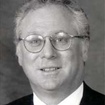
iGlobal Forum is pleased to announce the Non-Core Real Estate Opportunities Summit, which will take place on June 12th in New York. The real estate sector is becoming increasingly crowded, leading to a shortage of stock and yield compression. Non-core sectors are expected to outperform, driven by robust occupational demand and a significant yield premium to traditional real estate sectors. iGlobal Forum’s Non-Core Real Estate Opportunities Summit will explore a range of alternative real estate investment opportunities. You will gain an in-depth understanding of the opportunities that lie in non-core property areas, and how to profit by bringing them into your portfolio.
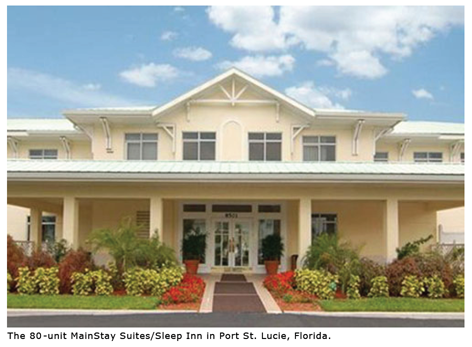
|
31 May 2013 New directions in dual-branded hotels 31 May 2013 7:16 AM By Ed Watkins Editor-at-Large ewatkins@hotelnewsnow.com |
Story Highlights
|
GLOBAL REPORT—Dual-branded hotels—two or more properties under the same roof or adjacent to each other and under the same management—isn’t a new phenomenon, but the concept has expanded in recent years. Innovations include splitting an existing hotel into two brands and building dual-branded properties with flags from different brand families. One examples of the former is a MainStay Suites in Port St. Lucie, Florida, that was reconfigured to include a Sleep Inn.
The latter concept—dual-branded hotels with different brand family flag includes a development at the Sacramento, California, airport that will have a full-service Marriott Hotel and a limited-service Hyatt Place; and a Clarion Hotel in Beachwood, Ohio, that will soon undergo a renovation to convert one wing of the hotel into a 120-room Hotel Indigo, an InterContinental Hotels Group brand.
Also, in Nuremberg, Germany, Foremost Hospitality broke ground on a side-byside Hampton by Hilton and a Holiday Inn Express.
Creating two from one
The MainStay Suites in Port St. Lucie was a perfect candidate to become a dual-branded hotel, said Mark Daley, president and CEO of The Generation Companies, owner of the hotel.
“The Port St. Lucie market is on I-95 and there are a lot of seniors who come down there in the winter, and while MainStay has a wonderful appeal to extended-stay travelers, it’s not as well known as Sleep Inn, especially for people just pulling off the interstate needing a short-term place to stay,” Daley said. “We felt the Sleep Inn name has a lot more brand-name recognition for that customer and also for the senior crowd.”
The decision to split the hotel was a function of serendipity. During Choice’s annual convention in 2012, the company introduced a new prototype building as a combination Sleep Inn and MainStay Suites. And, by coincidence, the Port St. Lucie MainStay was originally developed (Generation bought the property five years ago) with some rooms not having full kitchens as required by MainStay.
“The hotel was built using the Sleep Inn plans for one set of the rooms and the MainStay plans for the other rooms,” said Mike Varner, head of domestic brand management for Sleep Inn. “They had the (dual-brand) concept but they only had the MainStay Suites flag. When the (new prototype) was introduced, they were very intrigued with combining the two flags in the one property.”
Choice created a product improvement plan for the property that required the guestrooms follow the new prototype and that the public spaces reflect Sleep Inn’s Design to Dream design package, Varner said. Daley said the renovation and conversion took about 90 days to complete. He declined say how much the project cost.
“We upgraded the lobby and breakfast area with the current Sleep Inn design scheme, so common areas are tilted more heavily toward Sleep Inn,” Daley said. “And given that the Sleep Inn breakfast is a little more robust than MainStay’s, we agreed with Choice that we would operate the breakfast to Sleep Inn standards.”
Generation Companies owns or operates 27 hotels, all pure extended-stay hotels except the Port St. Lucie property. Daley said he views this project as “opportunistic based on the profile of this particular market. But we have other properties (for which) we would consider this type of thing.”
Varner, too, views this as a unique opportunity for Choice, but he doesn’t rule sanctioning similar projects.
“We would listen to just about anything because that’s part of our DNA,” he said. “At the same time, Sleep Inn has a very specific direction and MainStay is predominately a new-construction brand. It must make sense for the developer, the consumer and it’s got to make sense for the brand in the long run. If we can get that win-win-win, it’s something we can be supportive of.”
Mixing brand families
If one strong brand family can generate a lot of business for a hotel, then two families can do even better.
That’s the philosophy Robert Sonnenblick took as he started development of a dual-hotel project at the Sacramento International Airport.
Sonnenblick, who is president of Los Angeles-basedSonnenblick Development, is completing designs for a proposed 1 January groundbreaking on the project outside of baggage claim at the new $1-billion Sacramento airport terminal that opened in October 2011.
Sonnenblicksaid his company won the rights to develop the hotels, but the airport wanted two separate hotels: one full service and one limited service.
“Marriott came to us when we first won the (request for proposal) and said they wanted to do both the full-service and the limited-service, but the more the county and I thought about it we decided it would be in our best interest to have two separate reservations systems on the hotels,” he said. “I look at the 10 million customers that Marriott has and the six million customers that Hyatt has, I want both of those reservations systems marketing the Sacramento airport and my hotels.”
He said the full-service Marriott will have 200 rooms and substantial meeting space, while the 135-room Hyatt Place will have about 3,000 square feet of meeting space. Sonnenblickis currently seeking a third-party management company to operate both properties.
“My task is to find a management company that is approved by Marriott for full service and also approved by Hyatt for limited service. We’ve narrowed that down to three companies, and we are negotiating with them right now,” he said.
The project is being privately financed, with a 99-year ground lease from the airport authority. Sonnenblick said separate commercial banks are providing debt for each side of the hotel, and a pension fund is an equity partner in the deal.
While the Sacramento project is Sonnenblick’sfirst dual-branded hotel, “I’m working on a second one right now that is a beachfront resort. It’s different in that we’re putting two major full-service hotels next to each other sharing the beachfront and sharing a golf course, but each is branded separately,” he said.
Story Highlights
- There’s an abundance of capital sources in the hotel industry, said Andrew Coleman of Walker & Dunlop.
- The easiest deals to get done are for stabilized assets, Coleman said.
- A select-service hotel is twice as easy to finance as a full-service property, said Bob Sonnenblick of Sonnenblick Development
WASHINGTON, D.C. – Panelists speaking during last month’s Bisnow Lodging Investment Summit painted a rosy picture of the hotel lending environment. Capital sources were described as “abundant,” CMBS was said to be back at nearly full steam and financing in general was called “attractive” during several different sess1ons.
“There’s an abundance of capital back in the market- conduit lenders, life insurance lenders, banks, specialty lenders, you name it,” said Andrew Coleman, senior VP at Walker & Dunlop, during a panel titled “Hotel deals are getting done.”
The above sources are actively financing properties in primary markets, but many of the institutional, life insurance lenders are more hesitant in secondary and tertiary locations, he said.
The easiest deals to get done are for stabilized assets, Coleman added.
Fueling the recovery in hotel debt financing is the higher yields available at the asset level, said Warren de Haan, chief originations officer and managing director at Starwood Property Trust.
Life companies have huge allocations and their costs of funds are low, and banks are at all-time lows for percentage of loans to deposits. At the same time, there’s a huge demand for fixed -income product, “so naturally people are going to chase mortgage product,” he said.
More than a year ago, conduit lenders were offering 65% LTV with 12 debt yield at 4.25% cost of funds, de Haan said. Today, those costs of funds are slightly lower. Coleman said he’s also seen a reemergence of local and regional banks that are willing to listen to a good story. “12 months ago nobody wanted to hear a story… They’re now listening to those stories.”
Speaking during a “Hotel development roundtable,” Bob Sonnenblick, chairman of Sonnenblick Development, offered the following rule of thumb for construction loans: 50% of cost on a non-recourse basis, Libor slightly more than 1 and ton of equity is required in every deal.
Select service sizzling Sonnenblick also said it is twice as easy to finance a select-service hotel as it is a full-service property.
Editor’s Note: Part one of this story ran on May 3. This is part two of two.
The city is currently considering three options for re-use of the old city hall site – two hotels and one mixed use.
City Council heard the proposals April 23 during a very well attended afternoon study session about how to re-use 3300 Newport Blvd. Proposals for hotels came from RD Olson Development and Sonnenblick Development, while a mixed-use proposal came from The Shopoff Group.

Artist renderings of the projects proposed from (top to bottom) RD Olson Development, Sonnenblick Development, The Shopoff Group.
“The right decision is extremely important to the Lido Village area and the city,” said Denys Oberman, a peninsula resident.
The city has a responsibility to choose the project “best suited for the community,” she added.
Community response at the meeting was largely in favor of a hotel, with many speaking during public comment, including Lido Isle Community Association spokesman, Hugh Helm, who mentioned a resident poll the association conducted, with 98 percent answering in favor of a hotel.
The re-use of the old city hall site is the first step needed to revitalize Lido Village, he added.
“I’d like to see the project move along as quickly as possible, but in a diligent way,” Oberman said.
The staff is currently reviewing the three proposals with their consultants, said Kim Brandt, community development director, and hopes to make a recommendation to council by June.
“Once we conclude our review, we will present our findings to the City Council in a staff report that will of course be made available to the public. We are hoping to get back to council in June,” Brandt wrote in an email.
Oberman questioned the transparency with the city and asked for the economic assumptions and benefits sections of the proposals to be made public. It’s great that the city is reviewing them, she continued, but the public should be able to do the same.
“A portion of that will be made public,” Brandt said, possibly as early as today. Other parts of the proposal will remain confidential, she added.
“There are a lot of experienced and educated people in the community… with raised eyebrows,” Oberman said. “The community, quite honestly, has some questions.”
Ideally, Oberman said, she would like the community to be able to fully review the proposals and give feedback to each and the council.
Brandt did not know the timeline of when city staff will finish evaluating the proposals and be ready to present, but said it would be in a “timely fashion.”
Once the selected portions are made public, residents can review them and contact their city councilman or city staff to voice their opinion. There will also be public comment during the council meeting when staff presents their findings. Staff reports are typically made available the Thursday before the meeting.
Oberman, along with others locals, strongly favor the hotel option, she said later. Both of the hotel proposals have elements of attractiveness and potential concerns, she added.
Bob Olson’s project is a 130-room boutique hotel called the Lido House Hotel. The estimated total project cost is $43 million, Olson said.
The facility would include a restaurant, spa, fitness center, bay to beach park, ballroom and meeting room, rooftop lounge and viewing deck.
The project from Robert Sonnenblick is also a hotel consisting of 20 town homes, 12 villas and many guest rooms. The cost range for the proposal is approximately $70 million, Sonnenblick said.
The Sonnenblick property would include public courtyards, plazas and promenades, two restaurants, rooftop bar, lounge and event area, health spa, several water features, outdoor event areas, meeting space, and 210 below grade parking spaces.
The mixed-use proposal comes from William Shopoff and includes 99 luxury apartment homes and 15,000 square feet of upscale retail space. The estimated project cost will be approximately $60 million, Shopoff said.
The commercial area would include restaurants, community meeting room, pedestrian walkways, water features, a parking garage, and a town square and public plaza.
The city may seriously consider an apartment complex because the money is guaranteed, but they may also want to take advantage of the revenue a hotel could bring in through TOT taxes, speculated Edward Cook III, longtime Lido resident and co-president of McCarthy Cook & Co., a real estate investment and development firm.
A few of the key issues behind the proposals include projected revenue for the city, revitalizing the struggling surrounding retail, how it fits in with the community, financing of the project, if it makes economic sense, parking, and the use of the two landmark ficus trees.
All three said their project makes economic sense.
Shopoff maintains that his mixed-use proposal offers the lowest risk for the city.
It’s lower risk because their proposal is 100 percent equity and zero debt, Shopoff explained. They have committed capital, he added.
“In today’s market, we can all get financing,” he said. “Our lack of needing financing for anything makes it much more likely that when we get through the process with city council and the California Coastal Commission we can go (immediately) and build a project.”
“Those issues can’’t be overlooked,” he added.
As far as financing goes, Sonnenblick feels confident his current connections are more than willing to go forward with this project if chosen.
He has the unofficial backing of two Los Angeles based banks for the construction loan and pension fund partner for equity, they are just waiting until Sonnenblick is chosen to finalize, he said.
Sonnenblick is also waiting until their project is chosen to include Auberge at the meeting or available for commenting.
Olson is also confident in his company’s ability to finance their project.
“Our project makes economic sense,” Olson said. “If it doesn’t make sense nobody is going to step up and finance it.”
The economic plan for his project is feasible, he said, because they know their costs and expect a certain amount of return for their investors.
“We are in the market every day pricing hotels and building hotels,” he said. “We know what the costs are.”
“It’s our business, and we know our business very well,” he added.
Bruce Baltin, senior vice president of PKF Consulting, is working on the Olson project. Before teaming up with Olson, Baltin worked as a consultant for the market study for the city.
The market study, which Baltin emphasized was independent from any developer, found that it is a good opportunity for a hotel, he explained.
The economic power of a hotel is very good, Baltin said, because 100 percent of the TOT taxes go directly to the city.
Guests on vacation tend to spend more on a daily basis, they eat out every night, they shop at local stores.
Olson has a good track record, a fitting project for the market and a solid proposal, Baltin said.
“That’s why investors will finance it,” he said.
How much each project will need varies and one difference that plays a major role in cost is parking.
The $43 million cost estimate for the Olson project is lower because they don’t have the parking demands the other proposals have, explained Olson, whose project includes expanded public parking on 32nd Street to 150 spaces.
“We aren’t forced to do underground parking and take on all the excessive risk that comes with building a parking structure into the water table,” he continued.
The risk, he continued, from issues regarding the environment, risky construction, and state regulations.
Comments from residents have also expressed concern that underground parking at the old city hall site is risky.
No so, countered Sonnenblick, whose project involves this type of parking with 210 spaces and removes public parking on 32nd Street. His company and their general contractor, C.W. Driver (who also built the new civic center in Newport Beach), are very comfortable with their ability to build one level of below-grade parking on this site, he wrote in an email.
“It is not risky, they are very competent builders, and it will not negatively impact below ground water flow,” he continued. “It is, however, very expensive.”
Environmental impacts can be “easily avoided with proper engineering,” he added.
“Parking is critical for a hotel’s success and it’s critical for the surrounding neighborhood,” Sonnenblick said.
There needs to be more of a focus on parking, he added.
‘(The Olson hotel team members) are tremendously mistaken on their plan with parking,” he continued.
Neither hotel proposal seemed to have efficient or adequate parking, countered Shopoff, whose project includes 325 spaces from an expanded area on 32nd and a parking structure.
‘“On a site like that,” he said, “parking is premium.”
Another premium feature are the special landmark ficus trees.
The ficus trees will be preserved with both the Olson and the Shopoff projects, they will be moved to different spot with Sonnenblick’s proposal.
Olson noted that he thought the trees were too fragile to be moved, but Sonnenblick felt by transplanting them to a more a more public place makes the hotel design more efficient.
The potential timelines for each project are similar, about one to two years after breaking ground, which could be as soon as next spring.
Cook recommended looking at the track record of each proposal, consider if their other projects are outside the area or if they have local experience, and their financial capability.
It’s an interesting and exciting opportunity, Sonnenblick said.
The city is fortunate to have three quality proposals to sort through, Shopoff added.
It’s a big responsibility, Olson said, and the community is depending on the city.
“The area definitely needs revitalization,” Baltin said, “and getting the right project there could certainly do that.”
By Sara Hall on May 03rd, 2013
Editor’s Note: This story is part one of two
With the grand opening of the new civic center and park on Saturday, residents are wondering what will become of the old city hall site.
City Council heard three proposals last week during the afternoon study session on April 23 about how to re-use the land at 3300 Newport Blvd., from RD Olson Development, Sonnenblick Development, The Shopoff Group.
Both Olson and Sonnenblick presented hotels, while Shopoff offered a mixed-use of residential and retail.
Artist renderings of the projects proposed from (top to bottom) RD Olson Development, Sonnenblick Development, The Shopoff Group.

Artist renderings of the projects proposed from (top to bottom) RD Olson Development, Sonnenblick Development, The Shopoff Group.
“We all recognize the great need to revitalize Lido Village,” said Lido Isle Community Association spokesman, Hugh Helm, at the meeting, “and the city hall site re-use is the key first step.”
Community response at the meeting was largely in favor of a hotel, with a handful of residents speaking during public comment, including Helm.
A few of the key issues behind the proposals include projected revenue for the city, revitalizing the struggling surrounding retail, how it fits in with the community, financing of the project, economic feasibility, use of the two landmark ficus trees, and parking.
Edward Cook III, longtime Lido resident and co-president of McCarthy Cook & Co., a real estate investment and development firm, has his own take on the issue.
“This is the single most important land use decision on the peninsula,” ever, said Cook, who has taken an interest in the issue both personally and professionally. “It’s a once in a lifetime opportunity.”
The staff is currently reviewing the three proposals with their consultants, said Kim Brandt, community development director.
“Once we conclude our review, we will present our findings to the City Council in a staff report that will of course be made available to the public. We are hoping to get back to Council in June,” Brandt wrote in an email.
The first proposal last Tuesday was from Bob Olson, of RD Olson Development, who presented a 130-room boutique hotel called the Lido House Hotel.
The estimated of total project cost is $43 million, Olson said later.
The facility would include a restaurant, spa and fitness center, bay to beach park, ballroom and meeting room, rooftop lounge and viewing deck.
During the next 10 years, the hotel would bring approximately $400 million of direct and indirect spending from hotel guests and about $17 million in taxes to the city, according to Bruce Baltin, senior vice president for PKF Consulting.
Robert Sonnenblick, chairman of Sonnenblick Development LLC, also proposed a hotel during the meeting, his consisting of 20 town homes, 12 villas and guest rooms.
The cost range for the proposal is approximately $70 million, Sonnenblick said later.
The Sonnenblick property would include public courtyards, plazas and promenades, two restaurants, rooftop bar, lounge and event area, health spa, several water features, outdoor event areas, meeting space, and 210 below grade parking spaces.
The 10-year economic impact would be about $682 million of direct and indirect spending by hotel guests and approximately $1.6 million annually in tax revenue, according Sonnenblick partner, David Rose.
Bottom line is Auberge is a very high end operator, Sonnenblick said, some Auberge resorts have room rates as high as $1000 per night, he explained.
A high-end luxury project creates higher room rates and brings in wealthier customers, he explained, which increases revenue from TOT taxes and guest spending in the local community.
The only mixed-use proposal came from William Shopoff, president and chief executive officer of The Shopoff Group. The Shopoff project would consist of 99 luxury apartment homes and 15,000 square feet of upscale retail space.
The estimated project cost will be approximately $60 million, Shopoff said later.
The commercial area would include restaurants, community meeting room, pedestrian walkways, water features, a parking garage, and a town square and public plaza.
The average rental rates are expected to run between $5,000 to $6,000 per month, Shopoff said.
All three said their project would help revitalize the area.
A hotel would bring visitors to the area, whose number one activity is spending money, Olson said. A hotel will also create activity in town from the residents, he added.
More retail in an area that is already struggling isn’t the solution, Olson continued.
“This is our opportunity to reinvigorate lido and give our city,” Olson said.
A mixed-use space could be as good or better than hotel, Shopoff argued, for a number of reasons.
It would spark economic vitality and redevelopment, he added. The new residents will shop locally, he explained.
Traffic would be lower, especially during special events at a hotel, he added, and the high-end retail and restaurants will add vibrancy to the area, he sad.
In Cook’s opinion, a retail and apartment mixed use project, built in an area already struggling with retail, would contribute very little to economic vibrancy, he said.
“It needs something to jump start (the area and existing retail) not more retail,” Cook said.
“A hotel does so much more for both the city and the local community than an apartment building does,” Sonnenblick said. Financially, a hotel would bring in about 10 times more than an apartment complex, he added.
But it’s not all about economics, Shopoff countered.
It really has to be the best fit for the community and work well with the residents.
After Tuesday’s meeting, Shopoff said it’s clear the public has an opinion on the matter and at the meeting’s public comment, he understands they were overwhelmingly in favor of a hotel.
His project has supporters, Shopoff said, they just didn’t show up.
“It’s our job to try and get (supporters) to show up,” and they should have worked harder on that aspect, he admitted.
He plans on talking more with the community and hopes residents keep an open mind and don’t rush to judgment.
“We’ll provide all the information and the community and decision makers will determine what’s best,” Shopoff said. “We’re going to put our best foot forward, our best project.”
Shopoff said they are honored to be participating in the process.
Some residents that live nearby may fear that with an apartment complex it might get “rowdy” there, Shopoff said, but that is not going to happen, he confirmed.
“It’s incongruent with out tenant profile,” he explained.
The residents will be real contributors to the community, he continued.
Shopoff said at the meeting that he hoped the site will be the “most exclusive rental building in Orange County.”
The average rental rates are expected to run between $5,000 to $6,000 per month.
His project also includes a park with public space. It intermingles better with the community, he added.
“Our project is perfectly designed for both that site and the (local) marketplace,” Sonnenblick said.
Sonnenblick said he is currently gathering endorsements and sitting down with neighborhood groups. He encouraged residents to consider design, economic and feasibility issues, before supporting one proposal over another.
“We are very excited about this opportunity and we think our design could be a very successful hotel,” for the area he added.
Olson, a Newport Beach resident, is working with homeowners and has received a lot of support from the community, he said.
“I think it will give an identity to Lido, the peninsula and the city,” he said.
He emphasized the importance of involving the community and making sure residents feel that it’s their hotel. His project is designed to get guests out and into the community, rather than capturing them and keeping them on the property, he explained. They have one restaurant, but would encourage guest to eat out at local restaurants as well. He didn’t want to compete with the local restaurants, he added.
The restaurant will be WK Grill, created in honor of W. K. Parkinson, who dredged the harbor and built the isle up to 10 feet above the high tide line. He built Lido Isle.
“He was an oil man with a colorful past,” Olson said. So the restaurant will be themed around the life of W.K.
This is an urban area and not a large piece of land, Olson said, so his team wanted to create a hotel appropriate for the setting. It’s not a big resort environment, he added.
“That’s the wrong concept for Newport Beach,” he said. “It wouldn’t work in this community.”
The three developers have also contacted the owners of several neighboring sites, including Lindsay Parton, President/Principal of DJM Capital Partners, the firm about to seal the deal for Lido Marina Village.
“Revitalizing Lido Marina Village is an exciting opportunity, to say the least. It’s not often you have such a picturesque and even iconic place with all the important elements already there,” Parton wrote in an email.
He endorsed RD Olson Development out of the three, he said.
“The architecture ties in with the history of the area and will provide an authentic lodging experience for visitors to Lido Village and Newport Beach alike,” Parton continued.
The two companies recently worked together on a project in Huntington Beach.
“Our challenge is to bring it to life with some fresh thinking, creativity and a lot of TLC. Quality boutiques, innovative restaurants, and a great ambience and style -that’s something we know how to do. But getting it just right for the locals – that’s something we take pretty seriously,” Parton wrote.
The Fritz Duda Company, owner of the neighboring site, Via Lido Plaza, declined to comment on the three potential developers, said property manager Tristan Ritter. They may comment at a later time as things progress, she added.
The second half of this story will appear next week and cover the financing aspect of each project, economic feasibility, the two ficus trees, and parking.
Editor’s Note: This story is part one of two
“To me, green in the hotel industry is bulls—.”
Bob Sonnenblick has always been a guy who speaks his mind, and—if the above quote is any indication—he didn’t disappoint Thursday morning when asked whether “green” was a driving force behind hotel development during a panel at the Bisnow Lodging Investment Summit.
The principal of Sonnenblick Development LLC presented his argument as a matter of dollars and cents.
“If there are identical hotels on a corner, and one is green and one is not green. … and you said to the customer—we all live and die by the customer—‘Mr. Customer, would you pay a premium on your room rate to stay at that green hotel?’” the answer would be “no.”
“If the customer won’t pay the extra money for that project to be green, then the whole concept is bulls— in our business and it won’t last,” Sonnenblick argued.
To his credit, Bob Sonnenblick (right) didn’t mince words when sharing his thoughts on sustainable development. Fellow panelists, such as Buccini/Pollin Group’s Dave Pollin (left), didn’t share his views, however.
I admire the man’s conviction. As for his argument? It’s my turn to call BS.
Sonnenblick is absolutely correct about the premium of green—or the lack thereof. Study after study shows customers will not pay a dime extra to stay in a sustainable hotel. But there are other important factors to consider.
First, Sonnenblick failed to account for lost business. Going back to his original example with the two identical hotels, Mr. Customer might not pay more to stay in the green hotel, but he likely would book there over its non-green competitor across the street. As even more studies have shown, an increasing number of consumers favor sustainable businesses, and many large groups and government agencies will only book at hotels that meet certain sustainability standards.
Speaking of government, there’s also the issue of increased regulation. Sonnenblick can scream about rate premiums all he wants, but the point is moot if and when the U.S. government begins to require eco-conscious development and operations. Many municipalities and states (see: California) have begun to do so, and it’s already a fact of life in Europe, where carbon counts and credits are an accepted facet of the business ecosystem.
Third, and as we’ve reported time and time and time again, there are real cost-savings to be had, provided an owner or developer holds the hotel long enough to recoup some of that up-front investment.
And finally, Sonnenblick’s argument in and of itself is antiquated. Green isn’t a matter of either/or anymore. It’s too deeply ingrained in our everyday products and practices. From light bulbs to wall coverings to washing machines, things are simply built more sustainably, more efficiently. They’re “green” by default. You can’t avoid it.
A developer choosing between building a sustainable hotel or not is like a marketer deciding whether or not to the use the Internet or mobile channel.
To his credit, Sonnenblick did acquiesce on the moral side of the argument. When fellow panelist Mark Purcell of Starwood Hotels & Resorts Worldwide said any short-term costs pale in comparison with the long-term future of his grandchildren, Sonnenblick agreed.
“I agree with the moral argument,” he said. “I just mean that if things don’t have an economic benefit, they don’t last.”
I would counter that hoteliers who fail to recognize broad-scale shifts in business, culture and society won’t last.
When it comes to sustainability, the train already has left the station. It appears Sonnenblick has been left standing on the platform.
WASHINGTON, D.C.—Though the “Hotel Development Roundtable” panel during last week’s Bisnow Lodging Investment Summit lasted 45 minutes, Bob Sonnenblick was able to sum up the development landscape in less than 4.5 seconds.
“It’s a pretty good time to be a developer,” said the president of Sonnenblick Development.
Costs are down, new supply is almost nonexistent and interest rates are at historic lows, Sonnenblick continued.
Land prices have increased approximately 20%, but that’s after falling 75% during 2009 and 2010, he said. Construction costs are still down 40% compared with 2007.
“All those things lead to a pretty good time to be a developer right now,” Sonnenblick said.
Liam Brown, president of the U.S. and Canada division for select-service and extended-stay lodging and owner and franchise services, Marriott International, agreed.
“We are on a nice growth trajectory relative to new development,” he said. There’s nothing bad looming on the horizon, and “supply growth is terribly constrained.”
Brown noted that financing is not as loose as it was during 2007, but that’s not necessarily a bad thing. On the contrary, increased scrutiny ensures only the strongest projects come to market.
Mark Purcell, VP of North American development for Starwood Hotels & Resorts Worldwide, didn’t have quite as favorable a spin. Lenders might be talking actively about financing, but they have extremely difficult thresholds that developers must meet.
“It’s very much project-specific,” he said.
Further financing troubles
“It’s twice as easy to finance a limited-service hotel today as it is a full-service hotel,” Sonnenblick said.
“Full-service hotels are terribly difficult to finance,” Brown said. What full-service growth does exist is mostly from conversions.
Lender hesitation around the sector is a matter of scale, Purcell said. They would rather spread their dollars around a variety of less-expensive, limited-service projects than one or two full-service hotels.
A typical full-service hotel costs up to $400,000 a key, Sonnenblick explained. A select-service project rarely exceeds $200,000 a key.
To help fill in the financing gaps, many developers are turning to public funds, the panelists said.
Sonnenblick said he’s a huge proponent of approaching municipalities as potential partners. That’s what he did in one location, where his development company partnered with the local government to split the cost of the city’s bed tax in exchange for job creation and commercial development in what would have stayed a vacant lot.
Smart municipalities view hotels as multi-story retail, said Dave Pollin, co-founder of The Buccini/Pollin Group and chairman of the board of BPG’s hotel management affiliate Pollin/Miller Hospitality Strategies. Each new development brings with it new sales taxes, payroll taxes and more.
The “vast majority” of projects Purcell is overseeing at Starwood Hotels have some component of public assistance, such as historic credits and business improvement district grants, he said.
Anyone building an expensive project will have to put a lot of layers in the capital stack, he added. Public funding can help.
But can the brands? It’s not likely, Sonnenblick said.
“Things have changed,” he said. “When I look to the brands now, I love them for their reservation system and whether they’re going to operate or not operate. … but looking at the brand for money today is useless.
“Maybe 3% of the project cost could come from one of the brands” in the form of sliver equity or key money, “but that’s about it.”
Marriott’s Brown did not disagree. The major chains use their money cautiously—and only for high-profile locations, strategic locations.
However, a good brand is imperative in the lending process, he added. Fly a strong flag, and “most of the projects stand on their own,” he said.
Pollin has scored some key money from the brands by drumming up a little competition.
“Key money is available in the range of $5,000 to $15,000 a key depending on where the project is and if there is another brand that could run that flag,” he said.
Asking for incentives from a brand comes at a cost, Sonnenblick warned.
“The more money you ask that brand for, the longer you’re going to get locked into them contractually on a deal. There’s a give and take on that,” he said.
Hotel Gurus!
Last week’s Bisnow Lodging Investment Summit (we call it BLIS for short) in DC wasn’t just about the expert panelists, but also the 600 hospitality pros who attended to discover the latest trends and make deals. (There was so much handshaking that next year, we’ll be passing out Bengay.) Here’s who we found networking:
Here are some West Coasters: Bisnow director of Southern California operations Frank Sanchez, Woodbine Investment Corp’s Dupree Scovell, Sonnenblick Development founder Bob Sonnenblick (who also spoke), and Callison’s Christian Glauser Benz. Bob says his firm recently purchased 350 acres in Pinehurst, NC, where he hopes to break ground in January on a 330-room Westin hotel. He’s also talking with Tiger Woods Design about a golf course for the site.
By Jeffrey Cassady
BUSINESS WRITER
Published: Thursday, April 11, 2013 at 4:21 p.m.
Last Modified: Thursday, April 11, 2013 at 9:14 p.m.
DAYTONA BEACH —New York City. Miami. San Francisco . . . Daytona Beach?
For more than a decade, all-in-one complexes that contain a traditional luxury hotel and individually owned condominiums have been popping up in large cities and high-end vacation destinations around the country.
Now, as the developers of two new hotel-and-condo projects on the State Road A1A oceanfront prep for construction, the trend could be making its way to the land of NASCAR and biker parties. Although some industry experts have doubts about the concept working in this market, the developers are confident and local tourism leaders see a big potential upside in going upscale.
The projects’ developers hope the complexes’ condo sales will translate into quick cash after the facilities open and that the mix of a regular hotel and condo space will help protect them if the travel or real estate markets turn sour.
“It’s a very good mix,” said Alexey Lysich, vice president of Protogroup Inc., which plans to break ground on a $150 million two-tower hotel-condo-retail complex at the eastern tip of Oakridge Boulevard in August. “Condo residents can use room service, the shop and other hotel services.”
Mixed-use hotel-and-condo projects started growing in popularity — particularly in major cities — during the late 1990s as developers sought to lure condo buyers with plush hotel amenities and the opportunity to have their property associated with well-respected luxury brands, said Daniel Lesser, president and CEO of New York-based LW Hospitality Advisors.
“It made sense to all parties involved,” Lesser said. “For operators, it’s another revenue stream. For residences, it means hotel services. It also renders a project less risky because, on the spectrum of risk, hotels are considered higher-risk than residential by itself.”
But Daytona Beach is more Chevy than Mercedes-Benz, one industry leader suggests, and getting the luxury crowd’s attention could prove difficult for the historically blue-collar destination. That’s especially true with the plethora of swanky tourist magnets within driving distance of the World’s Most Famous Beach, said Bob Sonnenblick, chair of Los Angeles-based real estate development firm Sonnenblick Development.
Indeed, nearby vacation cities such as Palm Beach, Fort Lauderdale and Miami already have five-star hotel-and-condo complexes from brands like The Ritz-Carlton Hotel Co. and Four Seasons Hotels and Resorts.
“(Mixed-use hotel-and-condo complexes were) popular 10 years ago on the very high-end branded basis,” Sonnenblick said. “It never caught fire in a three-star, Daytona-type market … South Beach is the new Riviera of the United States. I don’t know that someone there is going to say, ‘Forget South Beach. I want to go to Daytona.’ “
Still, the developers of the two Daytona Beach projects are out to convince high-rolling buyers and vacationers to give the area a look.
Protogroup’s 105-condo, 400-to-500-hotel room development will be joined by a 100-condo, up-to-900-room hotel-and-condo complex Toronto-based investment firm Bayshore Capital plans to build south of Sun Splash Park.
“For us in particular, a project that has more hotel rooms than condos is more helpful to us in the short run,” said Don Poor, director of the Ocean Center, which will be just up the road from both developments. “In the long run, the condos attract more high-end development and improve the quality of the surrounding (neighborhood). (Residents) have (year-round) demand for high-end restaurants, high-end retail and so forth.”
The Protogroup property will feature an independent hotel, complete with retail space, a conference center and luxury amenities, Lysich said. The Bayshore property will have a branded luxury hotel, though the company is not yet ready to announce the flag under which the hotel will operate, said chairman and CEO Henry Wolfond.
“This will be a luxury resort hotel and residential condominium unique to the Daytona Beach market,” Wolfond said of his company’s project. “Once the brand is announced, we have no doubt whatsoever that it will transform and revitalize Daytona Beach to its past glory.”
And branding often is a key selling point for condo buyers looking at mixed-use hotel developments, Lesser said. Well-off buyers typically like the prestige of owning property associated with posh hotel chains like St. Regis or Ritz-Carlton.
“There is cache associated with (owning a condo attached to a hotel) for folks,” he said. “I can’t say that I have come across a large hotel with residences that wasn’t branded.”
As it stands, the Protogroup complex, tentatively named The Daytona Beach Convention Hotel & Condos, will not have a branded hotel, which could make it difficult not only to attract residents but also to obtain financing — a task already difficult because of tight credit for condo projects, Sonnenblick said.
“I don’t believe that there is any construction financing today for unbranded four-star hotels,” he said. “Every construction lender I talked to requires having a brand attached to new hotel projects.”
However, Lysich said Protogroup has the funds to cover about half the construction cost and that the other half will come from investors, a bank or both.
Bayshore is “highly confident” it can finance its project, Wolfond said, adding the company should have lenders in place within the next 60 days.
If the projects are built, they will go a long way toward modernizing Daytona Beach’s tourism scene, said longtime local hotel developer George Anderson.
“It’s definitely a big plus for Daytona Beach when you have someone with capital who’s willing to run with it,” Anderson said. “The world of vacationing is going to change, and Daytona hasn’t stayed up with the times.”
Mar. 27, 2013
ATLANTA–Hotel construction is on the upswing, with rising demand and low supply, but developers are worried about construction costs and labor scarcities, according to panelists at a conference on hotel development at last week’s Hunter Hotel Investment Conference in Atlanta.
“It’s a better time to be a hotel developer today than any time in my career,” said Bob Sonnenblick, chairman of Sonnenblick Development LLC of Pacific Palisades, Calif. Competition from developing apartments is gone, and he said “cities are dying for bed tax.”
Sonnenblick said he recently approached municipal officials in Palm Springs, Calif., pitching a project this way: either let this piece of property stay vacant, or do a deal with us and earn half of a bed tax for the next 30 years, and we’ll create 300 jobs. Municipalities are much more receptive to hotel developers, he said.
“Somebody turned a switch on last few months, and projects that had been stagnant are getting going,” said Jeff Jernigan, president of Pinkerton & Laws, of Marietta, Ga. His company has been a general contractor for 58 years, and just started their 250th hotel project, a 200-room Westin.
But spikes in lumber prices are driving up the cost of construction, Jernigan said. Lumber prices went from $250 for a thousand board ft. to $405 per thousand, a 43 percent increase in the last three months. Jernigan said the “wait it out” strategy, waiting for prices to fall, doesn’t look promising.
“And we’re not only dealing with commodities,” said Jernigan. “Our biggest problem is labor. There is such shrinkage on the labor side, we just don’t have capacity.”
Tougher immigration laws in Arizona, Georgia and Alabama have chased some skilled laborers away, creating net negative migration, said Jernigan. One of his good workers, with legal immigration status, begged him: “Please don’t send me to Alabama.” Other skilled laborers have been drawn away to lucrative jobs in the oil field.
The last year has been the highest year for subcontracting failures, Jernigan said. A glass contractor who had done one-third of Jernigan’s work went out of business last week. “He was just exhausted. He had nothing left in the tank capital-wise.”
“This is a tricky year,” said Jernigan. “Most of these guys are undercapitalized and don’t have people.”
“Anybody that was building without surety bonds has got to be out of his mind,” said Sonnenblick. “If some subcontractor has a problem on another job,” could mean financial disaster on a deal without surety bonds. “Everybody should be using surety bonds on every deal,” he said.
New building codes requiring more energy efficient buildings are proving troublesome, said Jernigan. He described problems getting code enforcers to accept the use of exterior insulation and finishing system (EIFS), as well as another instance in which he was required to add ductwork to each room, requiring added framing to each floor. “They are ugly surprises. We’re looking at another $300,000 whammy from this code issue,” complained Jernigan.
California and New York remain difficult markets in which to develop, said Gerry Chase, president and COO of New Castle Hotels & Resorts of Shelton, Conn., due to government regulations. “If anything, development is getting more difficult. Those that have the patience to work the deal will find they have a pretty successful project.” Chase’s company has 27 hotels on the east coast and Canada.
Financing is available from a variety of sources, but lenders will be cautious. Doug Artusio, chairman and CEO of Dellisart LLC, of Roswell, Ga. said some projects are being financed with industrial revenue bonds, enabling developers to get tax-free financing from the bank. Developers may be able to develop deals to avoid property tax for up to 20 years. Some hotels are also using USDA-backed financing, but those loans are not available in all areas, and can be complicated to get.
S. Jay Patel, president and CEO of the North Point Hospitality Group, Inc., of Atlanta, recommended taking a potential project to several lenders. “Bankers are like tires,” Patel quipped. “You’ve got to always have a spare one in the trunk.” He says his company likes projects worth between $30 million and $35 million that are in the mid-11s in financing, with 30 percent to 35 percent equity.
Getting a hotel brand to back a project is critical to financing, Sonnenblick said. “It’s virtually impossible to get financing without a brand on board.”
Chase said hotel projects can get some financing in select service-type projects, but it must be a “good project, well located, somewhere the brand wants their flag to be located.”
But Patel complained that financing support from franchisers’ has been “close to zero” in his company.
“I know there are incentives, and there is key money out there to help finance a project,” said Patel. “But the brands we do business with, we have been unsuccessful with getting any financing from them.
Sonnenblick said that “if you have a really sexy project, you could pull 3-4 percent key money,” which will help get a project financed.
“Don’t be afraid to ask, ‘how can you help me?’” advised Sonnenblick. “If we’re not doing deals, they are not getting deals.”
“The message is be creative, be patient, and have your package compete, and good projects will get done,” said Artusio.
Press Release
Mr. Robert Sonnenblick has been chosen by iGlobal Conference Corp. to moderate the real estate panel on “The Status of the Hospitality Sector” at their upcoming Fourth Annual iGlobal Real Estate Mezzanine Financing Summit in NYC. The conference will be held on May 8th at The Pierre Hotel.
| 2:40 pm |
|
 Jonathan Falik
Jonathan Falik
Senior Managing Director and Head of Hospitality Capital Markets
BGC PARTNERS/BGC CAPITAL MARKETS
 Enrico F. Plati
Enrico F. Plati
President & CEO
TARIS REAL ESTATE
 Michael Girimonti
Michael Girimonti
Managing Director, Debt Investments,
PEARLMARK REAL ESTATE PARTNERS
 Moderator:
Moderator:
Bob Sonnenblick
Principal
SONNENBLICK DEVELOPMENT
PRESS RELEASE:March 11, 2013
Hunter Hotel Conferences has added Bob Sonnenblick, Chairman of Los Angeles-based Sonnenblick Development LLC, to its speaker list for their 3:30pm panel on March 21, 2013.
The panel is titled: “Hotel Development Today” and will headline Day 2 of the 25th Annual 3-day Hotel Conference (March 20-22) at the Atlanta Marriott Marquis Hotel.
For further information, please go to:
www.HunterConference.com
or www.SonnDev.com

LOS ANGELES—There are lights, cameras, and plenty of real estate action happening in Los Angeles, particularly in the entertainment sector. Sonnenblick Development’s Bob Sonnenblick (snapped at Hyatt Corp’s annual luau at the Americas Lodging Investment Summit in LA last week), tells us movie and commercial production have been growing for six months. That means major production studios are leasing LA office space again. They and music producers are leasing for the standard 10 years. Reality shows are also doing a lot of office deals but going for two- to three-year commitments. And studio space is so full that leasing is overflowing into warehouses. (Bisnow is shopping around its own concept: a reality show about filming a reality show in such unusual quarters.)
By Jill Cowan
January 4, 2013 | 8:15 p.m
As the Newport Beach City Council gears up for 2013, it will tackle uses for the old City Hall site, an Airport Land Use Commission finding that could affect a development project and analysis of a Corona Del Mar lane merger relocation at its first meeting of the year Tuesday.
Old City Hall site
According to staff reports, the city received 15 responses to an October request for qualifications from groups interested in developing the 4-acre City Hall site with either a boutique hotel or a residential mixed-use complex.
Of those, city staff and the Ad-Hoc Neighborhood Revitalization Committee recommended that the council move to issue a request for proposals from the top three groups in each category.
The groups chosen for possible hotel proposals were Pacific Hospitality Group, RD Olson Development and Sonnenblick Development Co. For residential developments, the group chose AMLI Residential Partners, Archstone and the Shopoff Group.
Uptown Newport
Community members can discuss the possibility of overruling an Oct. 18 Airport Land Use Commission decision on the Uptown Newport project, which found that plans for the development were “inconsistent” with John Wayne Airport’s land use plans.
The council was originally set to have a public hearing Dec. 11. On Tuesday, it can vote to officially notify the commission and the state about its intention to overrule the finding. After more opportunity for public comment, the city could then override the commission’s decision.
Lane merger
The council may also put to rest a proposed location change for a lane merge in Corona del Mar.
In June, the city set up temporary lane markings to test the effects of the proposed change on East Coast Highway at MacArthur Boulevard. The change would have added sidewalk space nearby.
In late October, the city found that congestion in that area increased and the council voted to have the temporary markings removed.
The council is scheduled to hear a final report on the trial period.
Public comment changes
Issues that may not be up for much discussion are proposed changes to the council’s public comment policy.
A consent calendar item, which city staff typically expects to pass without council debate, would change council policy to decrease the amount of time members of the public would have to comment on matters that appear on the meeting agenda.
The change would allow three minutes of public comment on agenda items, whereas now, five minutes is allowed.
In the general public comment period, when community members can comment on anything, the time limit is already three minutes, which wouldn’t change, a staff report said. The council would still be able to lengthen or shorten those time limits on a case-by-case basis.
The consent calendar item would also change policy to allow only members of the council to pull items from the consent calendar for further discussion. Now, any member of the public can also ask for more discussion on consent calendar issues.
Tuesday’s meeting is scheduled for 7 p.m. at Newport Beach City Council Chambers, 100 Civic Center Drive.
jill.cowan@latimes.com
Twitter: @jillcowan
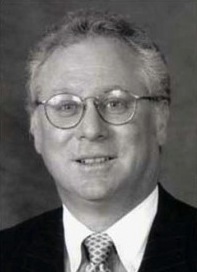
“After I spoke on a Bisnow hotel panel three weeks ago, I stuck around and chatted with numerous
attendees who came up to our speaker’s dais afterwards.Do you know that I have now picked up THREE major hotel development deals/projects from that
event from people who approached the panel afterwards?”
— Bob Sonnenblick
Wednesday, April 24 – Thursday, April 25
Washington, DC | The Washington Hilton
The room may have been full of bedheads, but there were no sleepyheads at our Hotel Investment Summit. More than 300 of you attended the event last week at the SLS Hotel Beverly Hills. OK, it’s actually in LA, but we won’t split hairs when our keynote speaker was the hotel’s owner: Sam Nazarian, founder, chairman, and CEO of LA-based sbe.
Pircher, Nichols & Meeks partner Michael Scheinberg (right) introduced the hospitality impresario, who talked about how he began funding hotel operators while in his early 20s and decided he liked the business. Sam says doing the Viceroy in Santa Monica “opened my eyes” to how the worlds of development, hotel operations, food and beverage, and entertainment coalesced into one property. In 2002, he founded sbe, which now has more than 5,000 employees. Next month he’ll begin construction on SLS Hotel & Casino Las Vegas at the old Sahara. sbe will have 3,500 rooms open by the end of 2014 and will be the only operation on the Strip that controls and manages not just the hotel but also food and beverage, retail, and a casino, delivering a life-style value proposition.
Our Summit also featured two all-star panels. The first, moderated by Arent Fox partner Rich Brand, looked at how deals are getting done. Rich’s practice is 50% sports and 50% real estate, with the latter focused mostly on hospitality. Our panelists, who included Wells Fargo’s Vernon Chi and Starwood Property Trust’s Warren de Haan, noted there’s much more interest on the debt side in the hospitality space. Warren says the real change is in the CMBS market, which is “now daring” to finance select-service hotels in even secondary and tertiary markets at decent leverage levels.
 The panel also included Clearview Hotel Capital CIO Tom Naughton, CBRE’s Rod Apodaca (who just sold along—with partner Bob Kaplan-the Embassy Hotel Apartments in Santa Monica), and LW Hospitality Advisors CEO Dan Lesser, who says the 24/7 coastal markets are the most desirable-more specifically, the limited or select-service properties. The beauty about this point in the cycle “is that there’s a lot of runway left in terms of rebound.” Rod expects greater activity in 2013 and 2014, noting supply is so limited that anything that comes out gets bombarded with interest.
The panel also included Clearview Hotel Capital CIO Tom Naughton, CBRE’s Rod Apodaca (who just sold along—with partner Bob Kaplan-the Embassy Hotel Apartments in Santa Monica), and LW Hospitality Advisors CEO Dan Lesser, who says the 24/7 coastal markets are the most desirable-more specifically, the limited or select-service properties. The beauty about this point in the cycle “is that there’s a lot of runway left in terms of rebound.” Rod expects greater activity in 2013 and 2014, noting supply is so limited that anything that comes out gets bombarded with interest.
Homeier & Law partner Michael Homeier moderated our second panel, dealing with development. Over the past three years, the firm has done close to 100 projects using EB-5 financing. Two-thirds of the money has gone into real estate—hotels made up half. The deal size has gone up considerably, as well—from the first project, a $20M raise for the W Hotel in Hollywood, to $110M for Sam’s Sahara project. “This is a real source of alternative financing.” The panel included Sonnenblick Development chairman Bob Sonnenblick, who’s got eight hotel development projects across the country and the Caribbean, and is actively seeking hotel land, and The Chartres Lodging Group president Maki Bara, who says the company has been focused on redevelopment, having done $800M worth of renovation projects in the past 10 years—in some cases, spending more to renovate a property than the purchase price.
Others on the panel included HKS Architects principal/LA office director Scott Hunter and Marriott SVP Chris Rose, who handles development for the company in the Western US. Chris says Marriott’s opening 100 hotels in the US this year and financing depends on the segment. On the full-service side, he’s seeing mostly conversions but points to some recent ground-up activity being done by very wealthy individuals that have the banking relationships and can sign on the note or self-finance. Scott says SKS has a “pretty rich pipeline” of projects with a lot of ground-up construction and redevelopment domestically, “if we can get the locks unlocked on financing.” But the firm’s seeing a lot of growth internationally—especially in China.
While Bob’s avoiding the middle part of the country “like the plague,” he’s heavily invested in SoCal and, especially, NorCal. “We tend to stay near the water,” having learned from developing the Loews Hotel in Santa Monica that there’s only so much beachfront. His biggest problem isn’t financing or city approvals but finding sites. Maki’s ideal opportunity would be a deal in which all three legs of the stool—physical asset, brand, and operations—need to be fixed. For Dan, hospitality is a manic business with dramatic high and lows, all feeding back to the constant repricing of guest rooms. To Vernon, it’s fascinating that New York has added so many rooms in the past three years, noting “top-line fundamental performances haven’t budged an inch.”
Sonnenblick Development’s Bob Sonnenblick is keeping his fingers crossed—and not just for while zip-lining through the rainforest in Costa Rica. Bob tells us he’s waiting to see who is picked to redevelop the Ports O’Call Village in San Pedro. (The final decision is due in one week.)
The City of LA’s RFP will see the 50-year-old complex bulldozed and replaced with a brand new restaurant and retail project on a 30-acre waterfront site. Bob, a panelist at tomorrow’s Bisnow Hotel Investment Summit at the SLS Hotel in Beverly Hills, also tells us the company won an RFP to build a Marriott and a Hyatt Place hotel (335 rooms total) that will be attached to Sacramento International Airport’s new $500M Terminal B. In addition, Sonnenblick plans to begin during 2013 on a 330-room hotel in Cathedral City and has resort hotel projects in the works in the Bahamas and Palm Beach, Fla. Bob just started planning his annual Super Bowl Party for his RE industry friends. The only thing that could cancel the party “is if the Jets go to the Super Bowl,” because in this admittedly unlikely event, the diehard fan plans to be right there cheering them on.
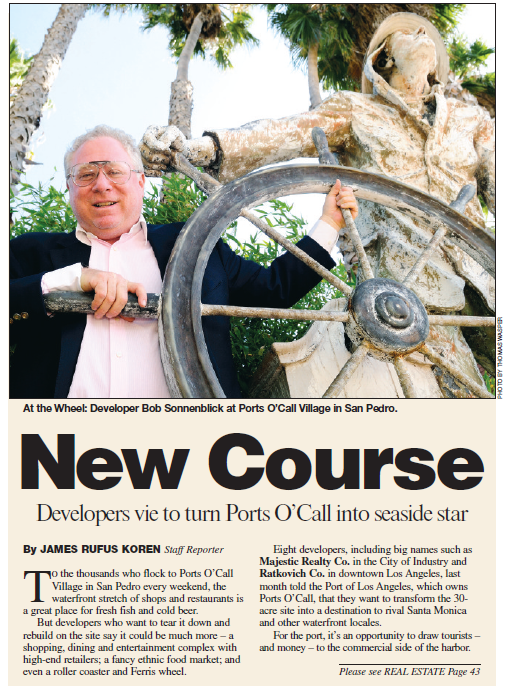
At the Wheel: Developer Bob Sonnenblick at Ports O’Call Village in San Pedro.
By JAMES RUFUS KOREN Staff Reporter
To the thousands who flock to Ports O’Call Village in San Pedro every weekend, the waterfront stretch of shops and restaurants is a great place for fresh fish and cold beer. But developers who want to tear it down and rebuild on the site say it could be much more- a shopping, dining and entertainment complex with high-end retailers; a fancy ethnic food market; and even a roller coaster and Ferris wheel.
To the thousands who flock to Ports O’Call Village in San Pedro every weekend, the waterfront stretch of shops and restaurants is a great place for fresh fish and cold beer. But developers who want to tear it down and rebuild on the site say it could be much more- a shopping, dining and entertainment complex with high-end retailers; a fancy ethnic food market; and even a roller coaster and Ferris wheel.
For developers, it’s a chance to build on 30 acres of oceanfront property.
“There’s only so much waterfront property available to be developed,” said Bob Sonnenblick, a principal at Sonnenblick Development LLC in Pacific Palisades one of the developers proposing to redo Ports O’Call. “Anytime you can get 30 acres on the water with a huge amount of frontage, you can’t go too far wrong.” Ports O’Call was built 50 years ago and hasn’t been upgraded much since. Now it’s seen by developers, port officials and even many local business leaders as a run-down relic of the 1960s. Ports O’Call is busy on weekends, but doesn’t draw many customers during the week. Much of its retail and restaurant space is vacant. While developers are optimistic that the right kind of development can bring more visitors and money to San Pedro, some of the factors that have led to the village’s troubles might not be so easily fixed.
[CLICK TO READ]